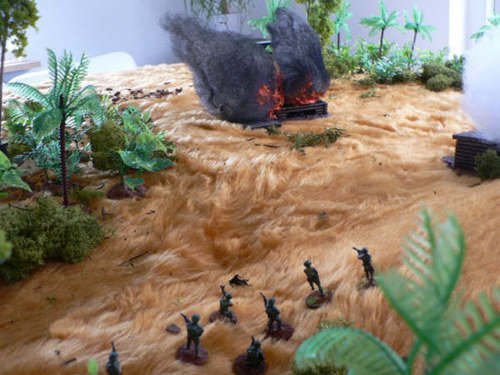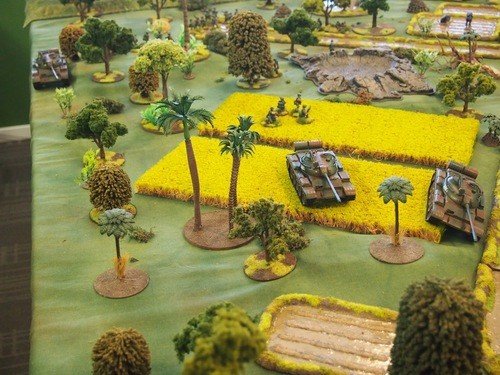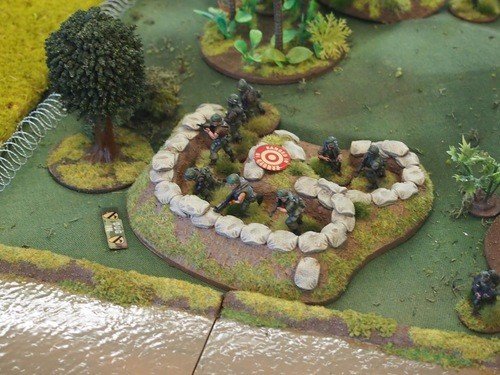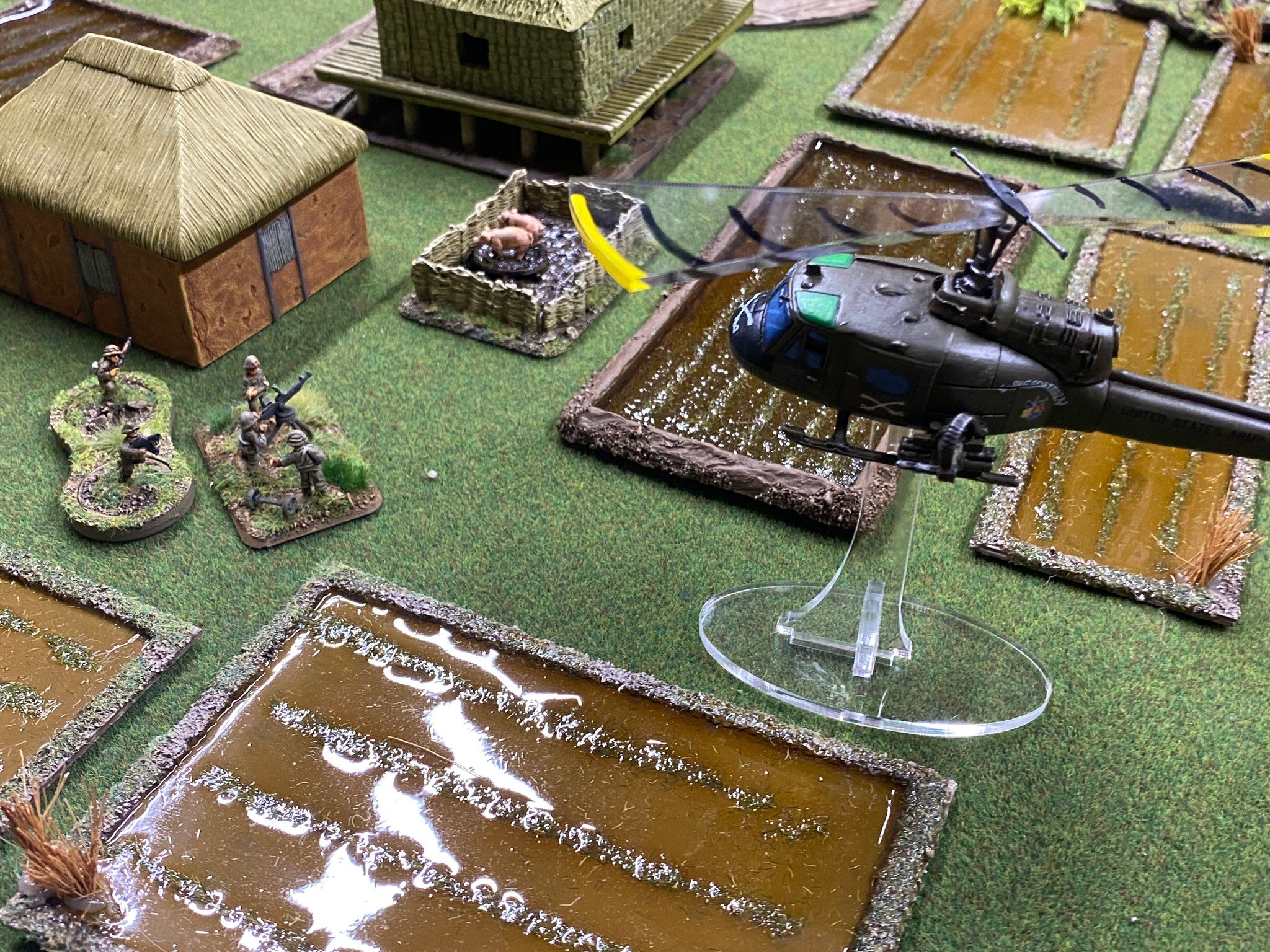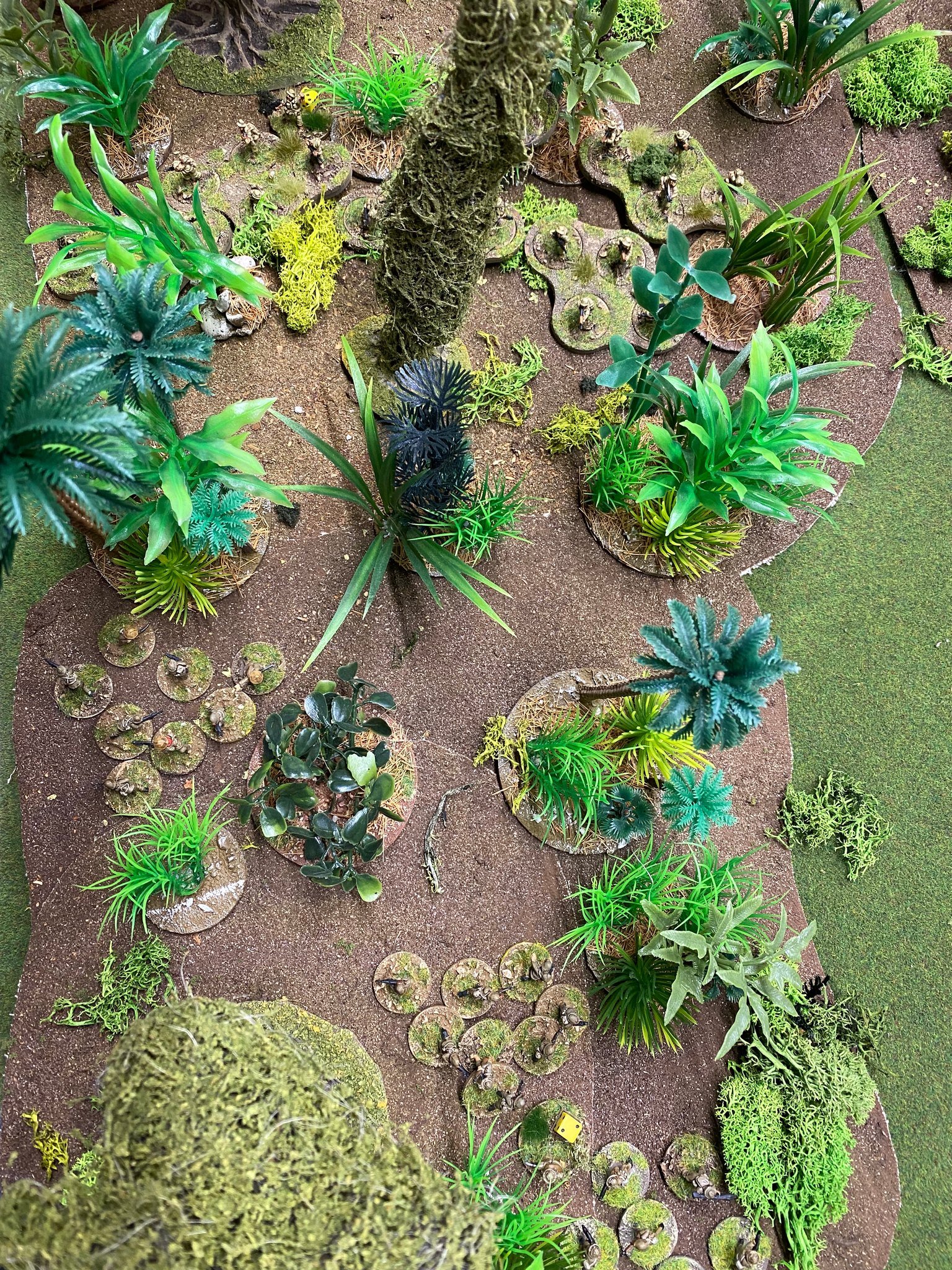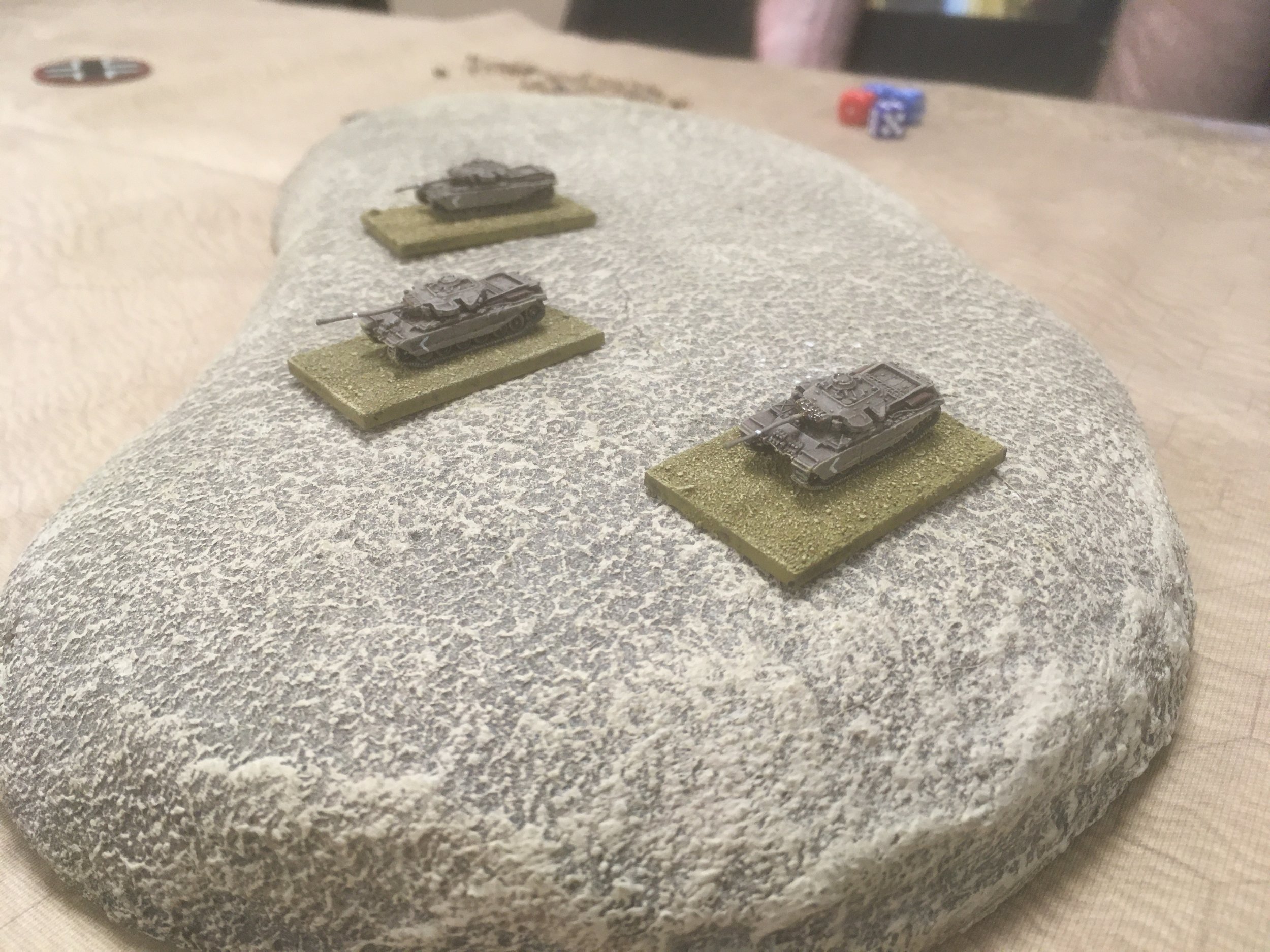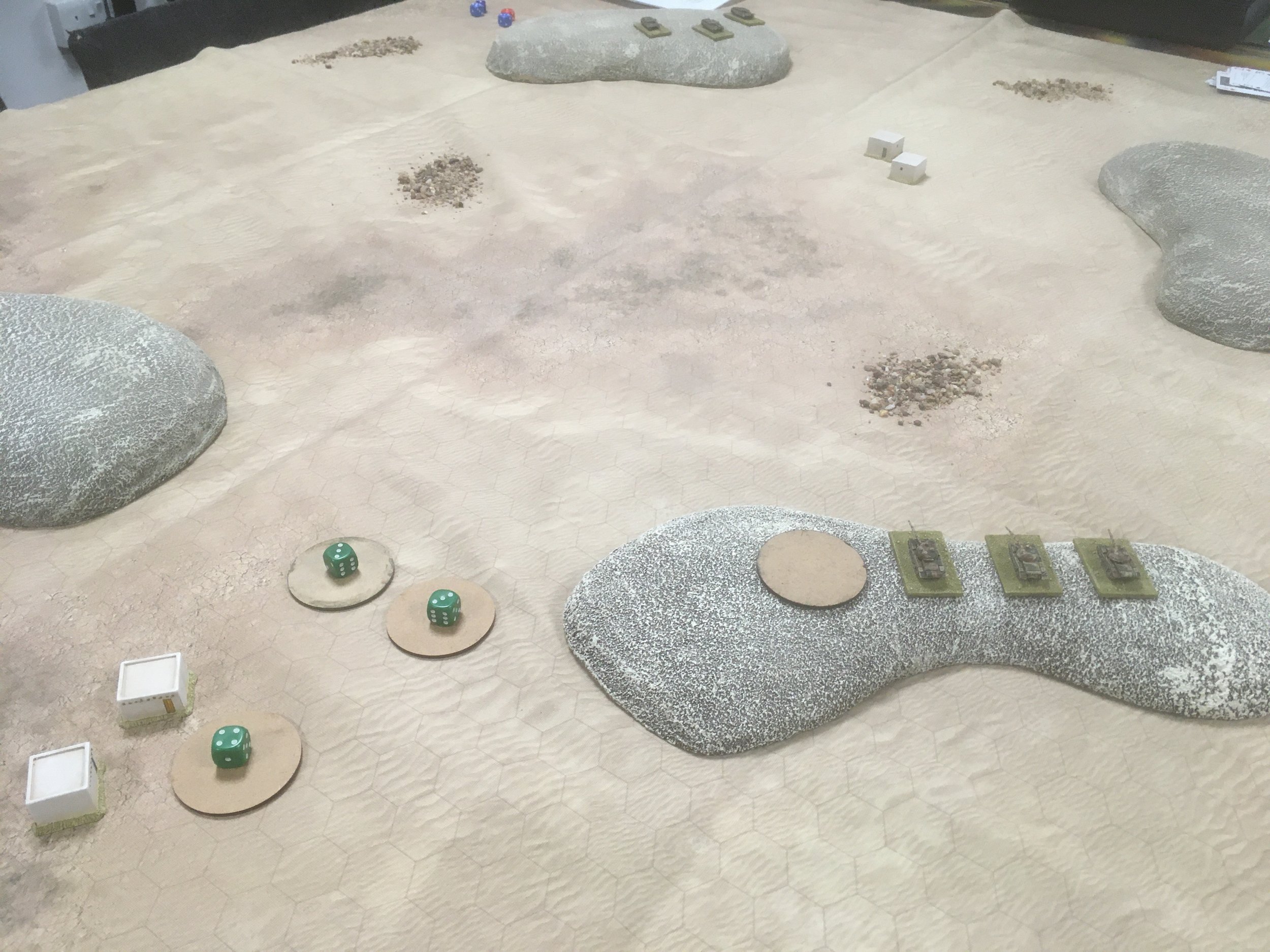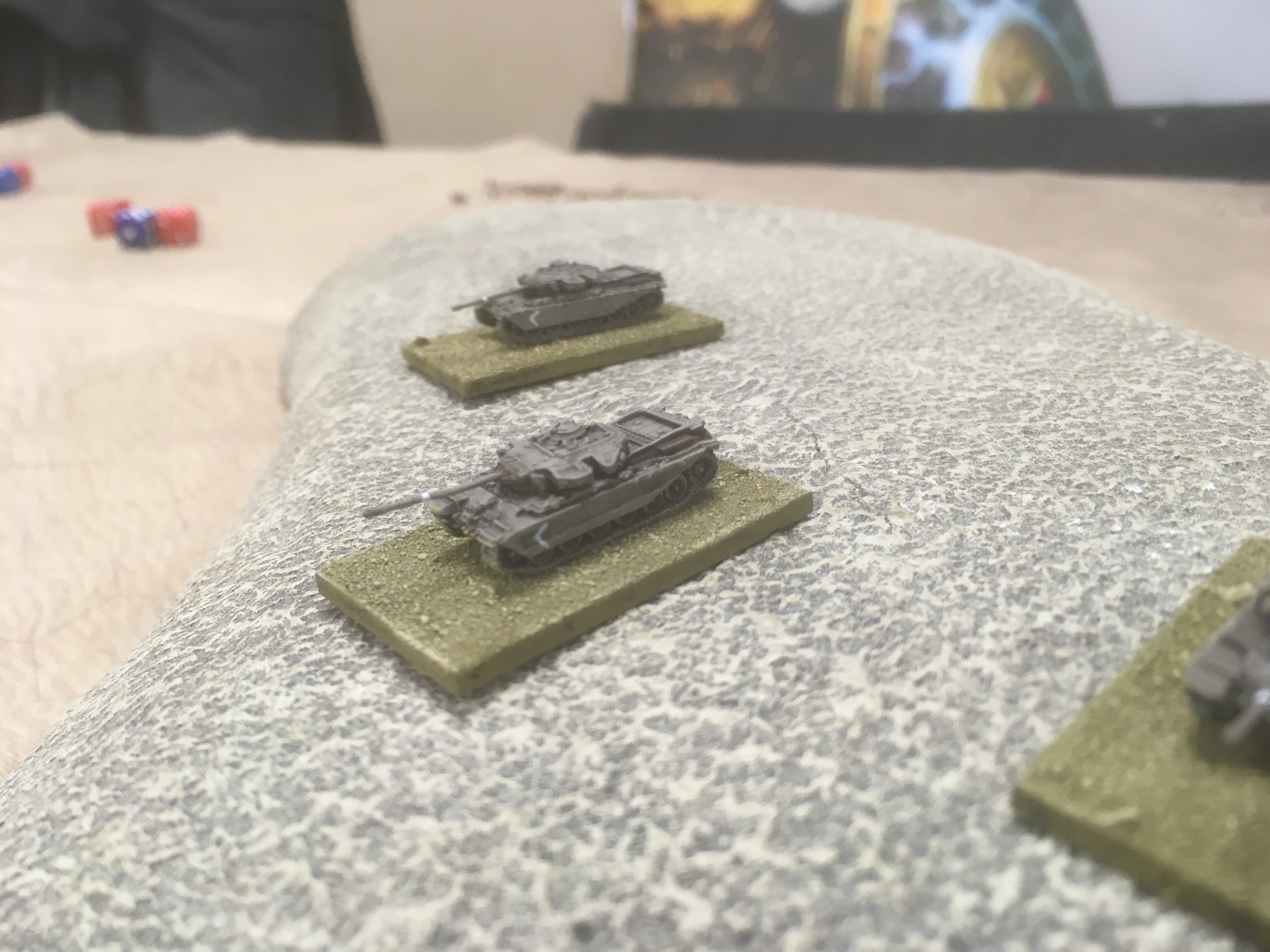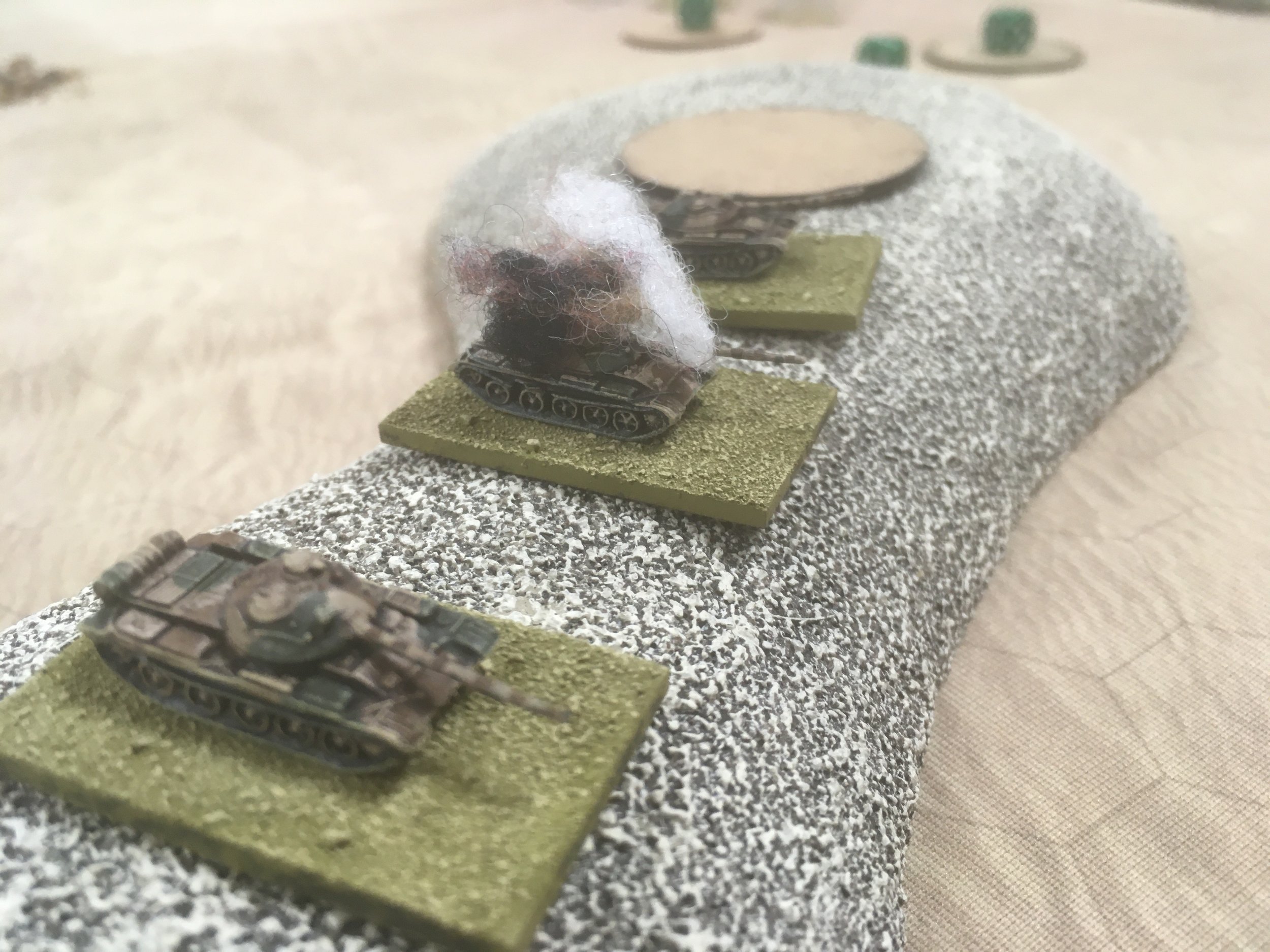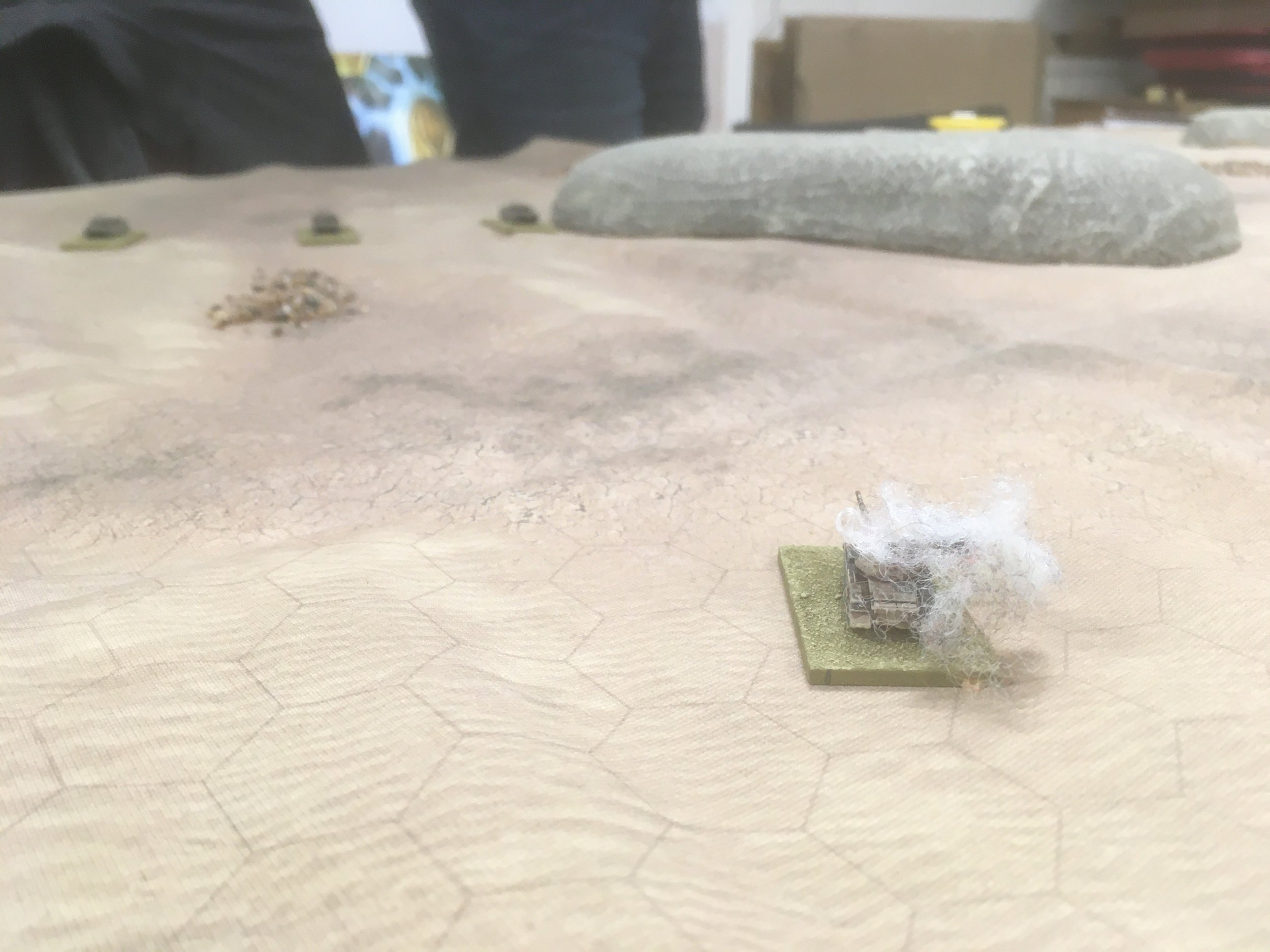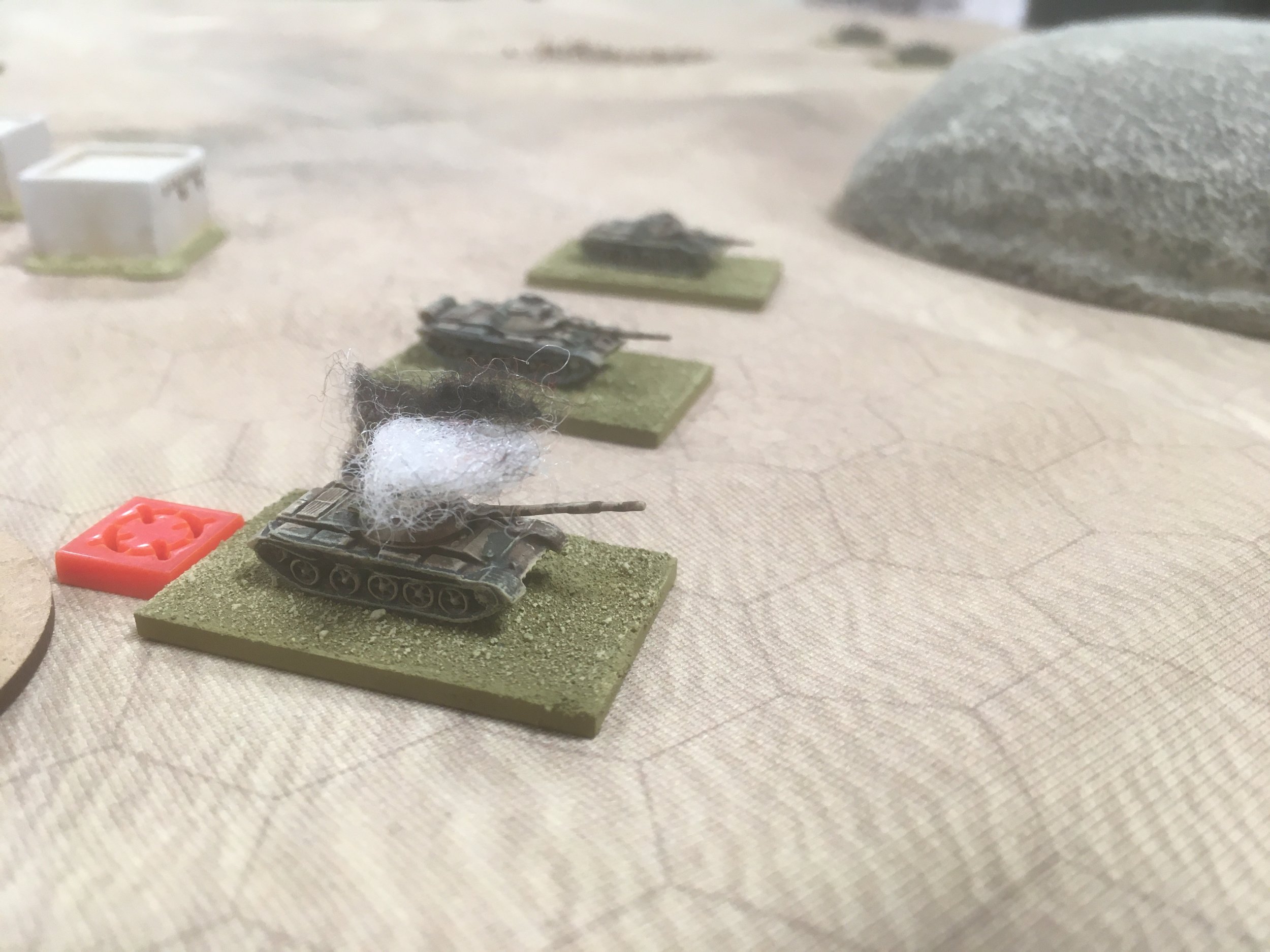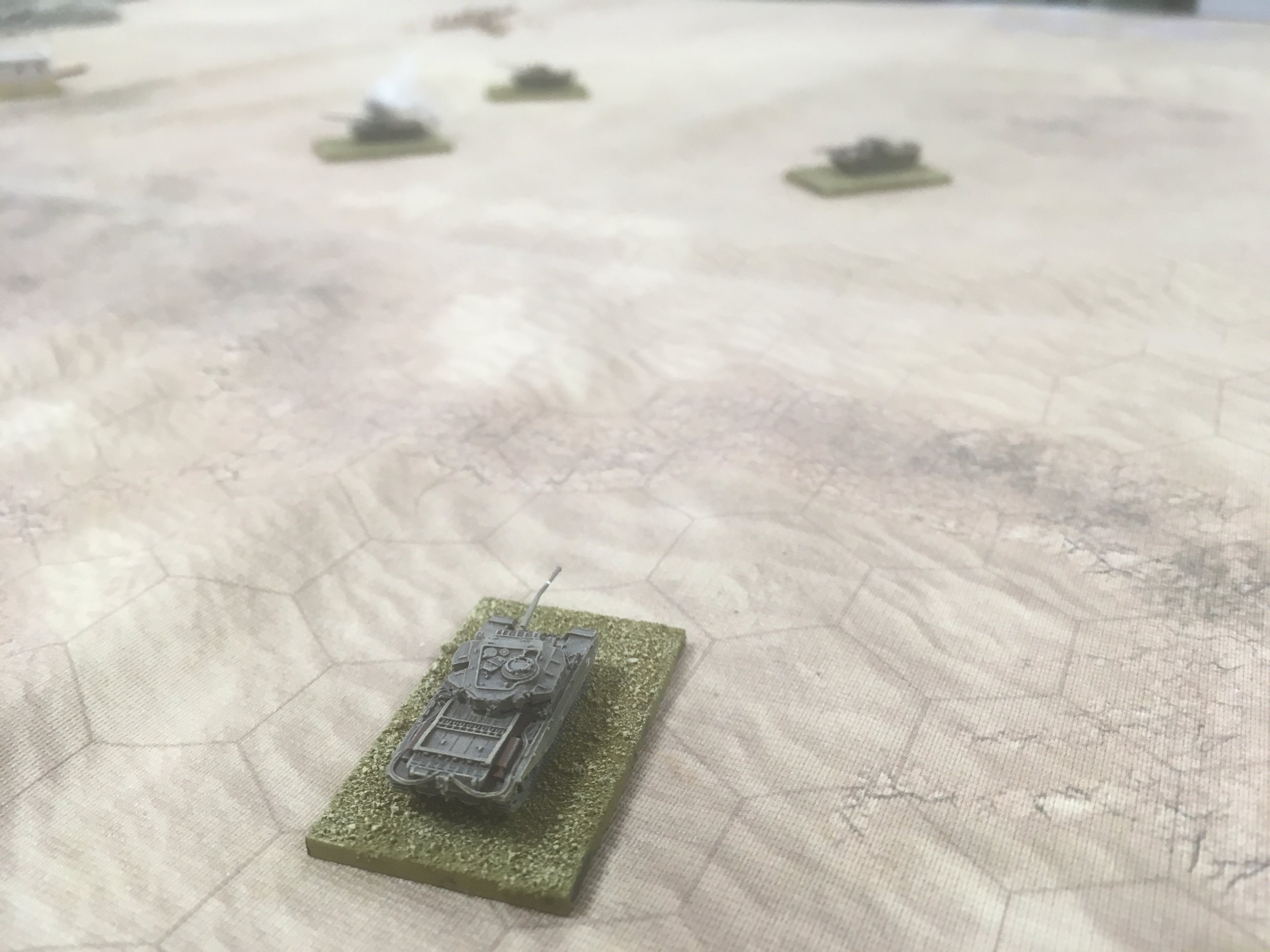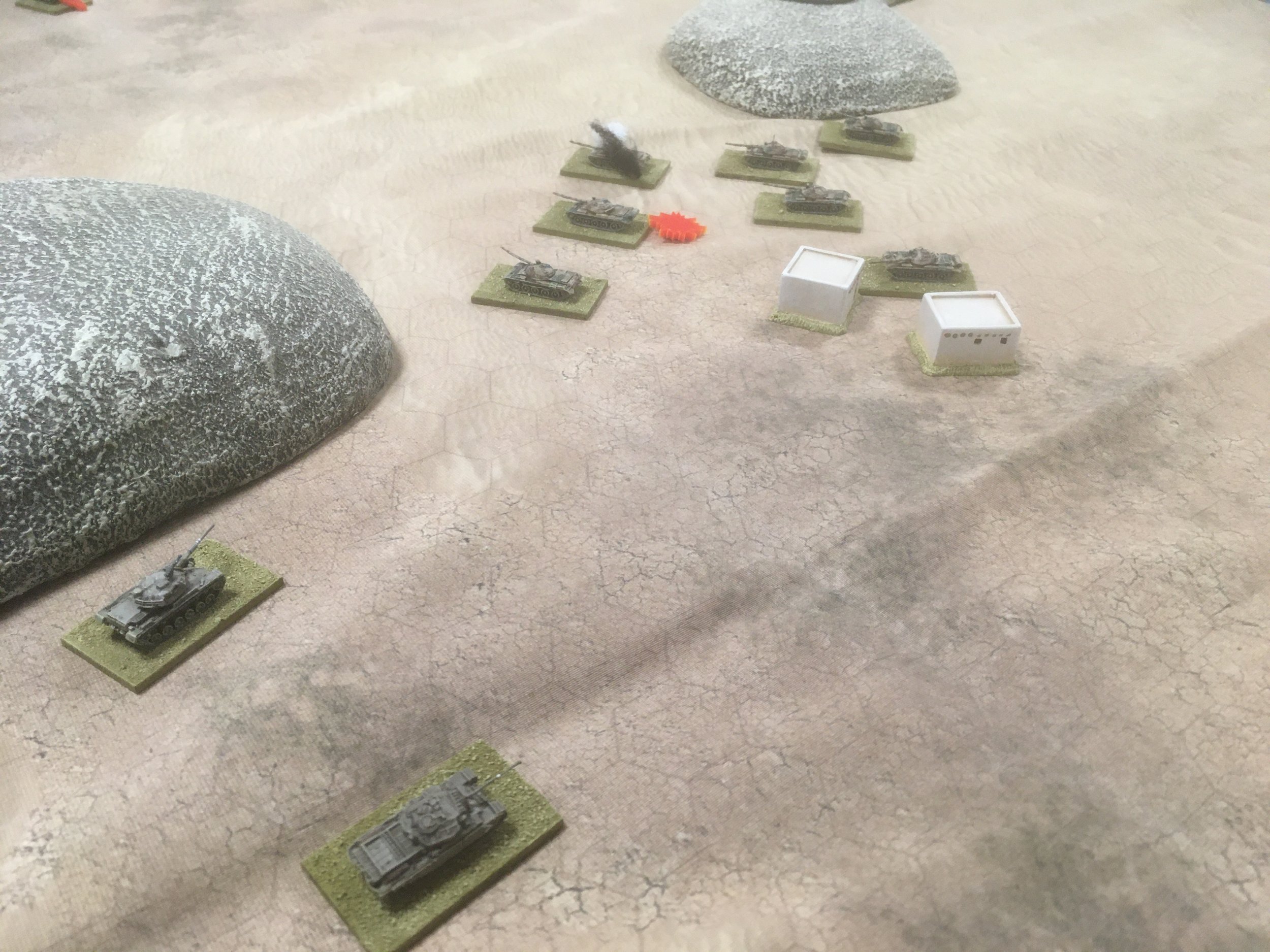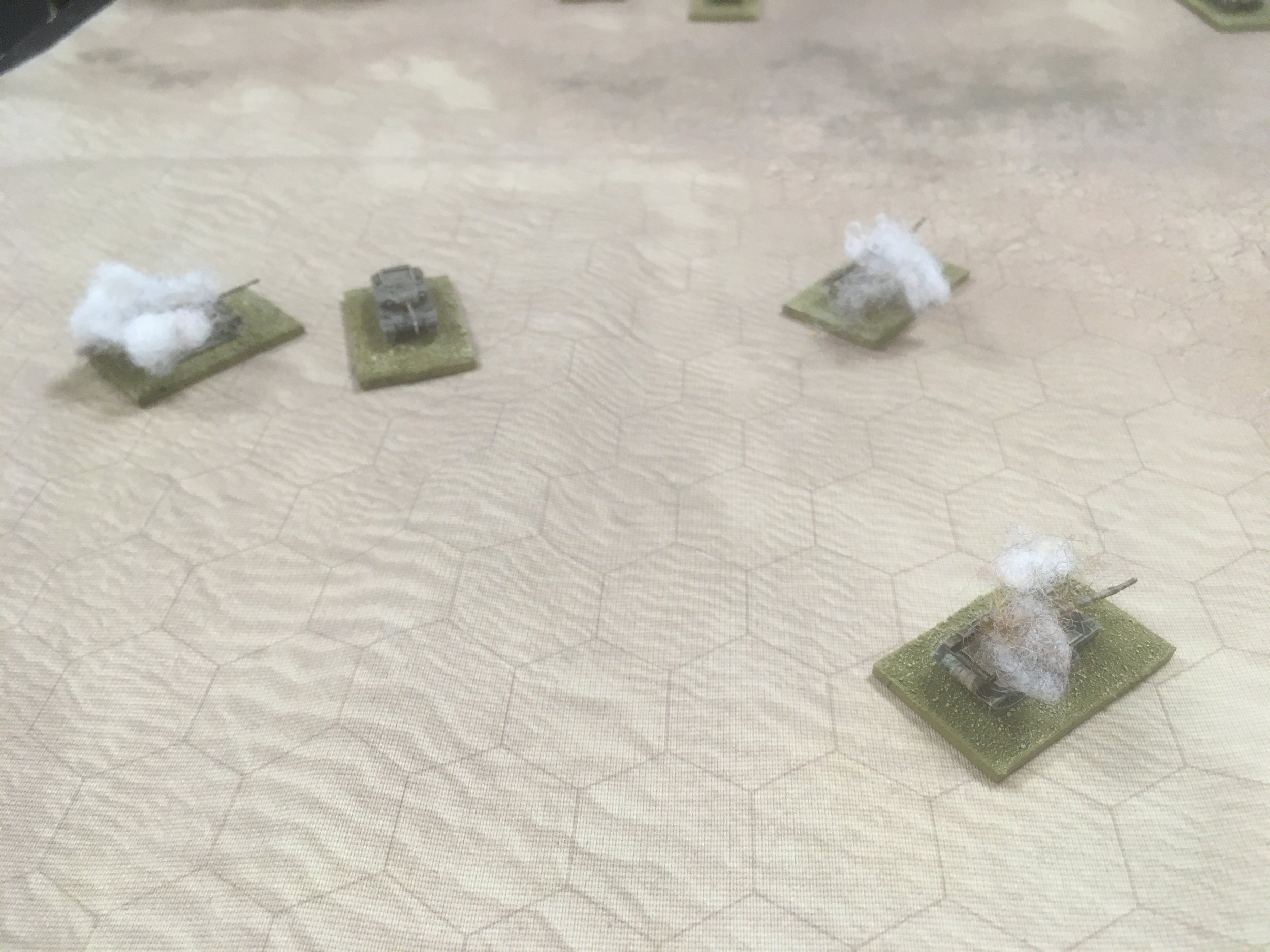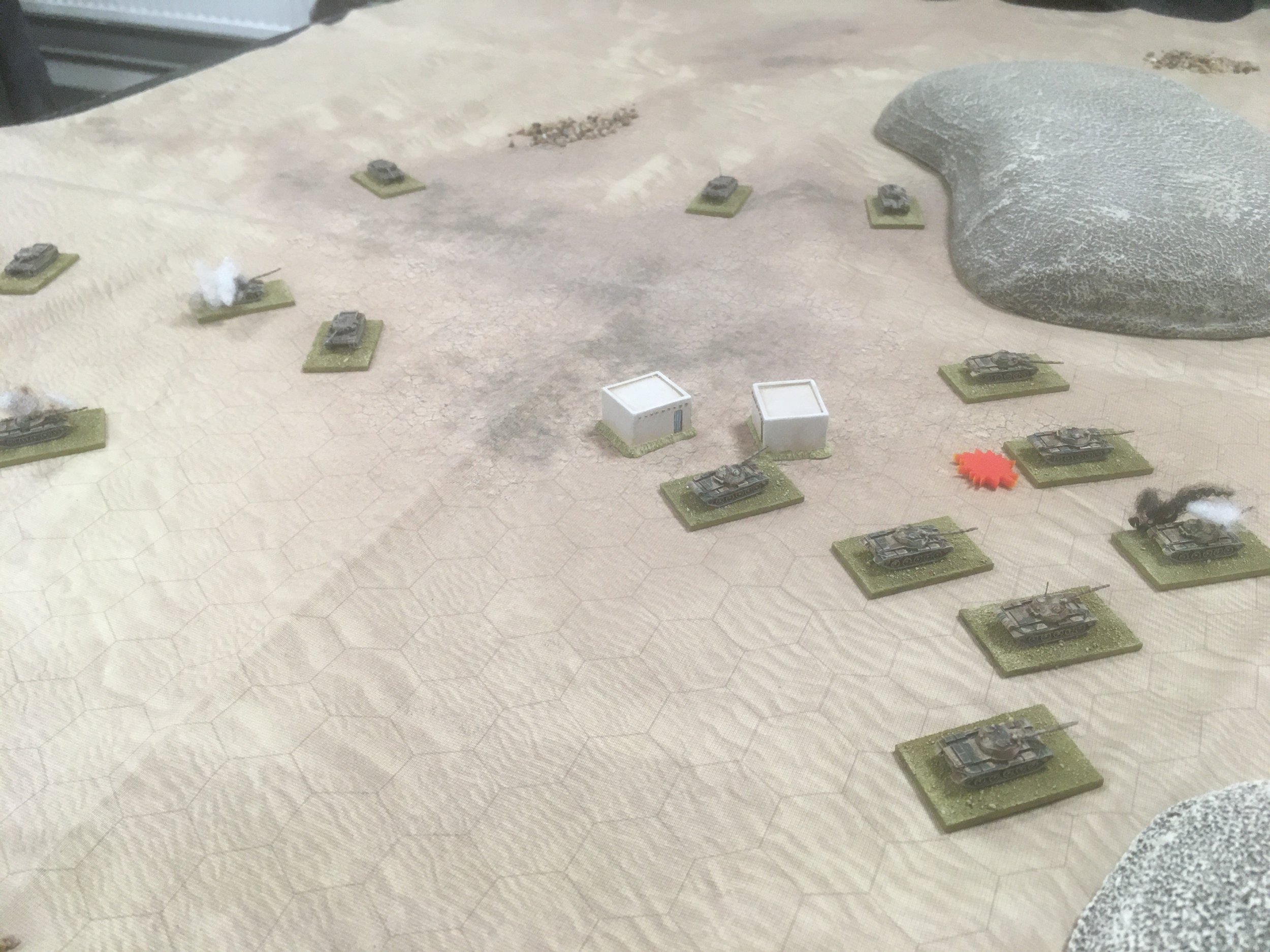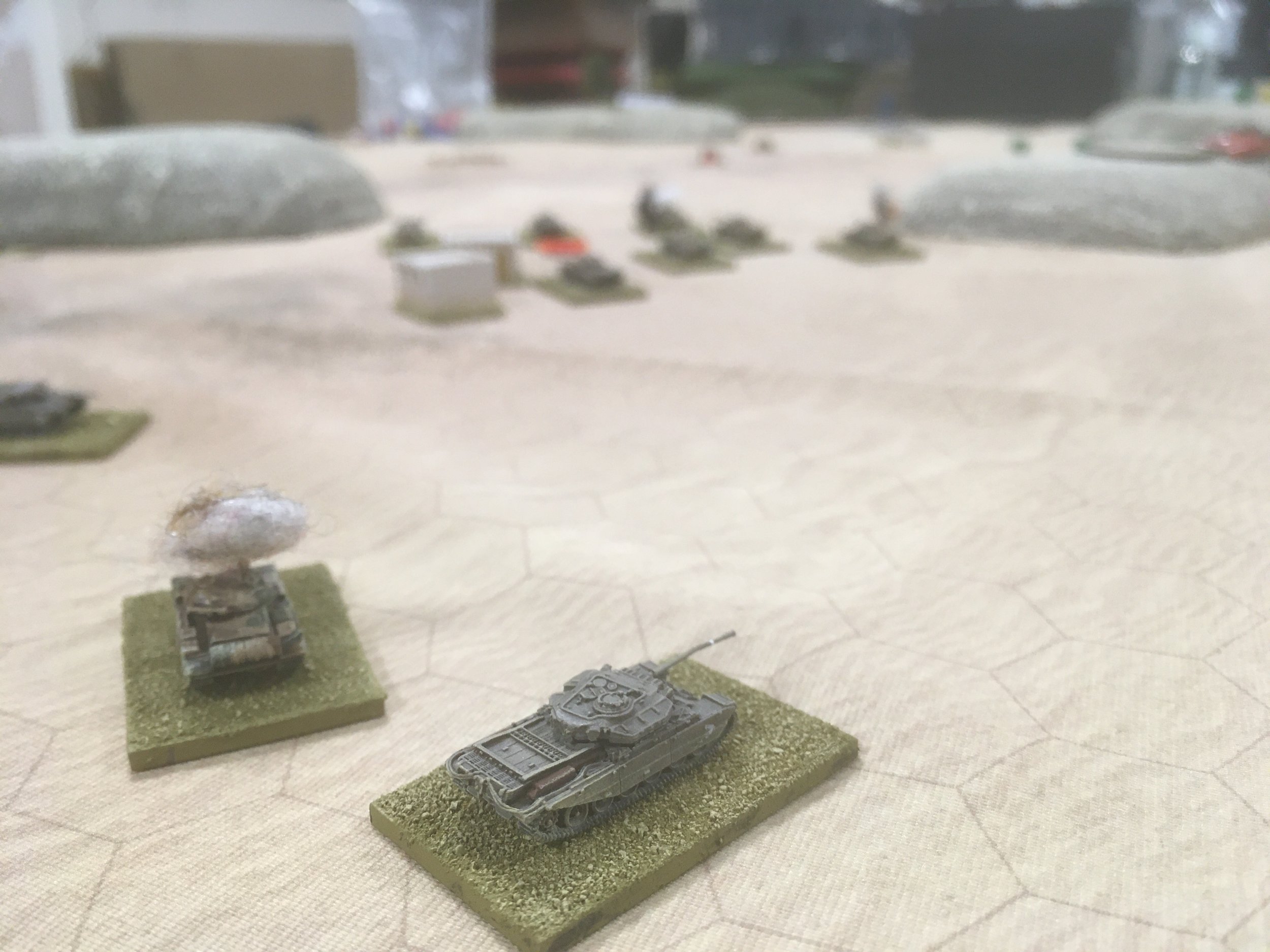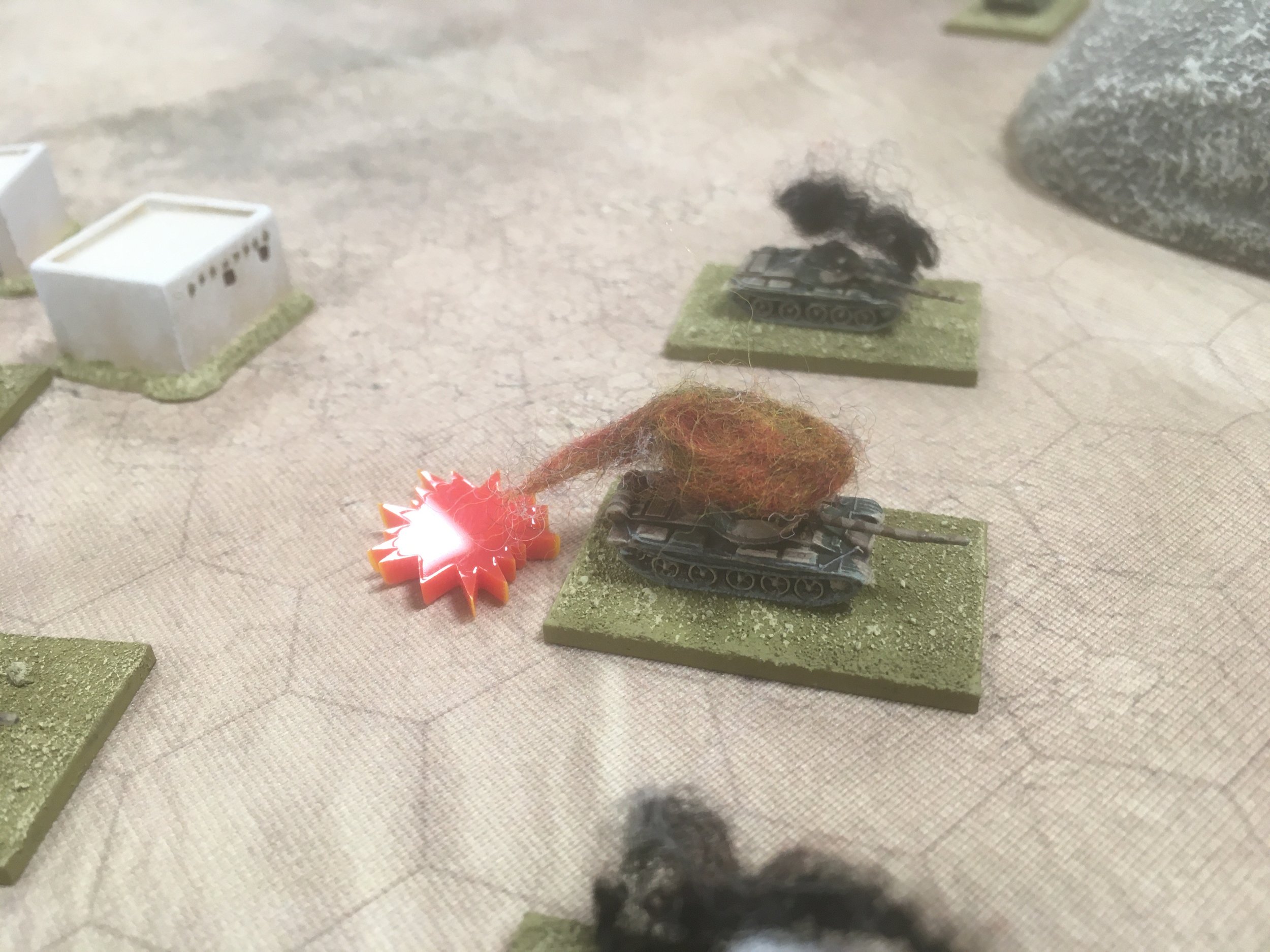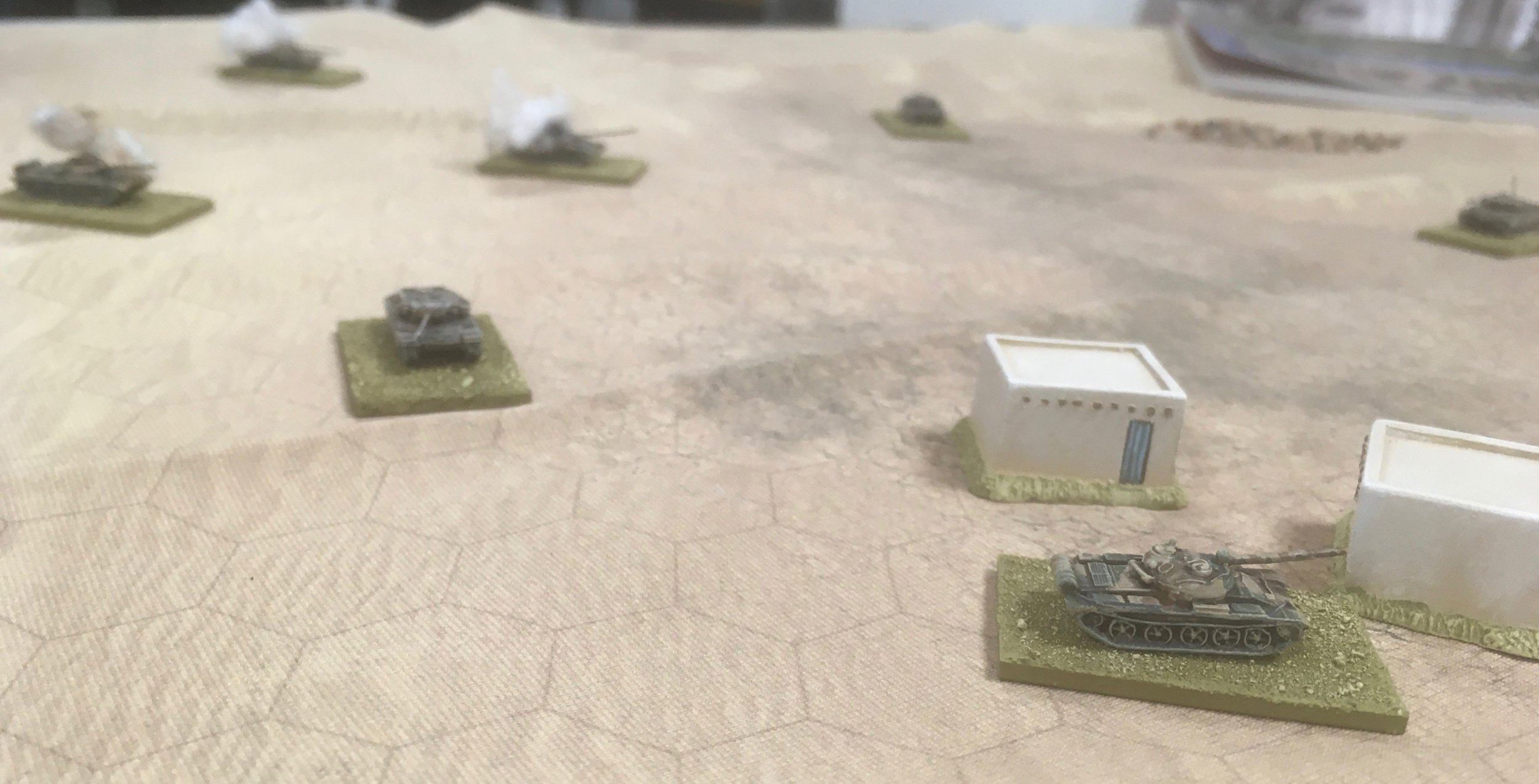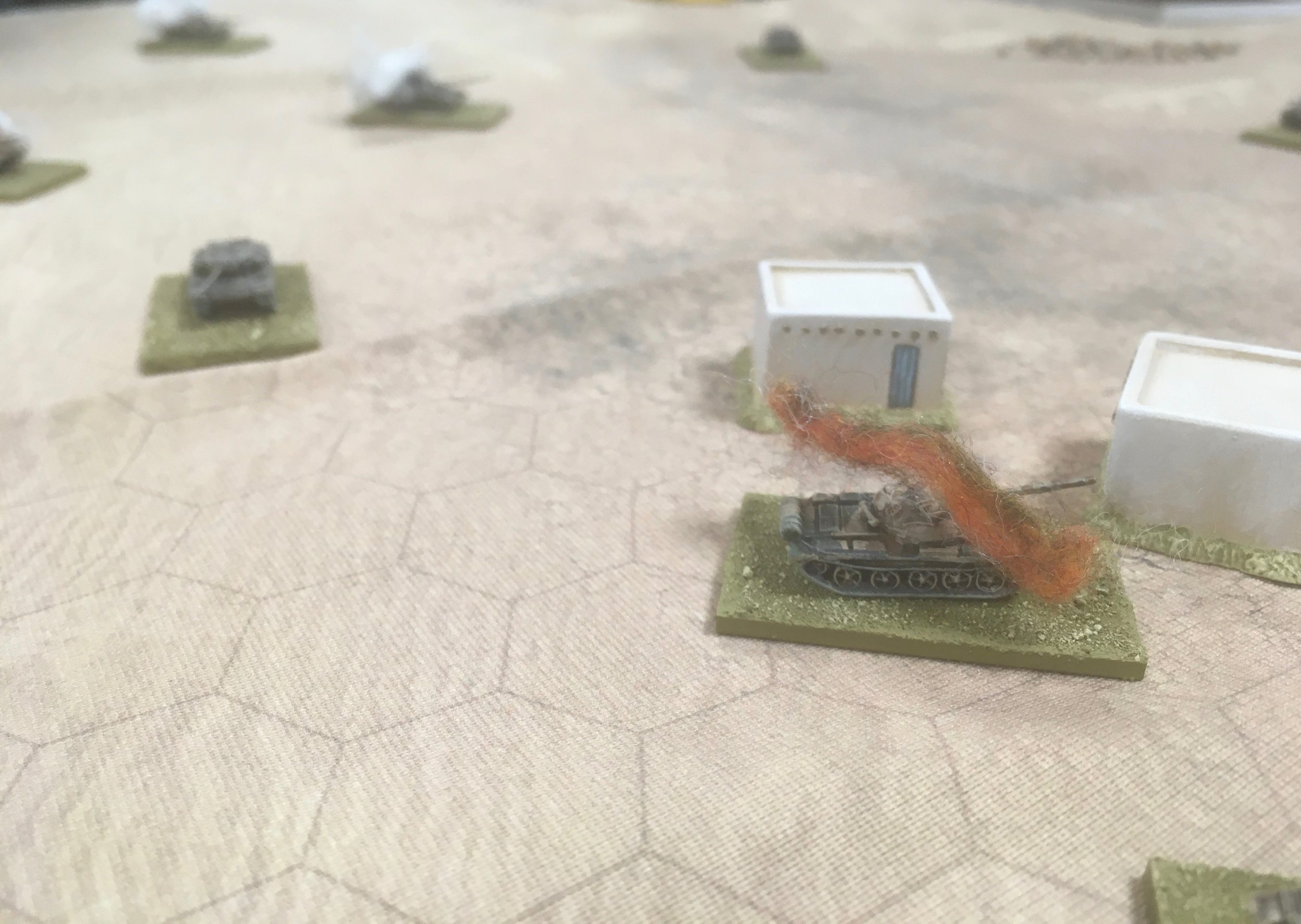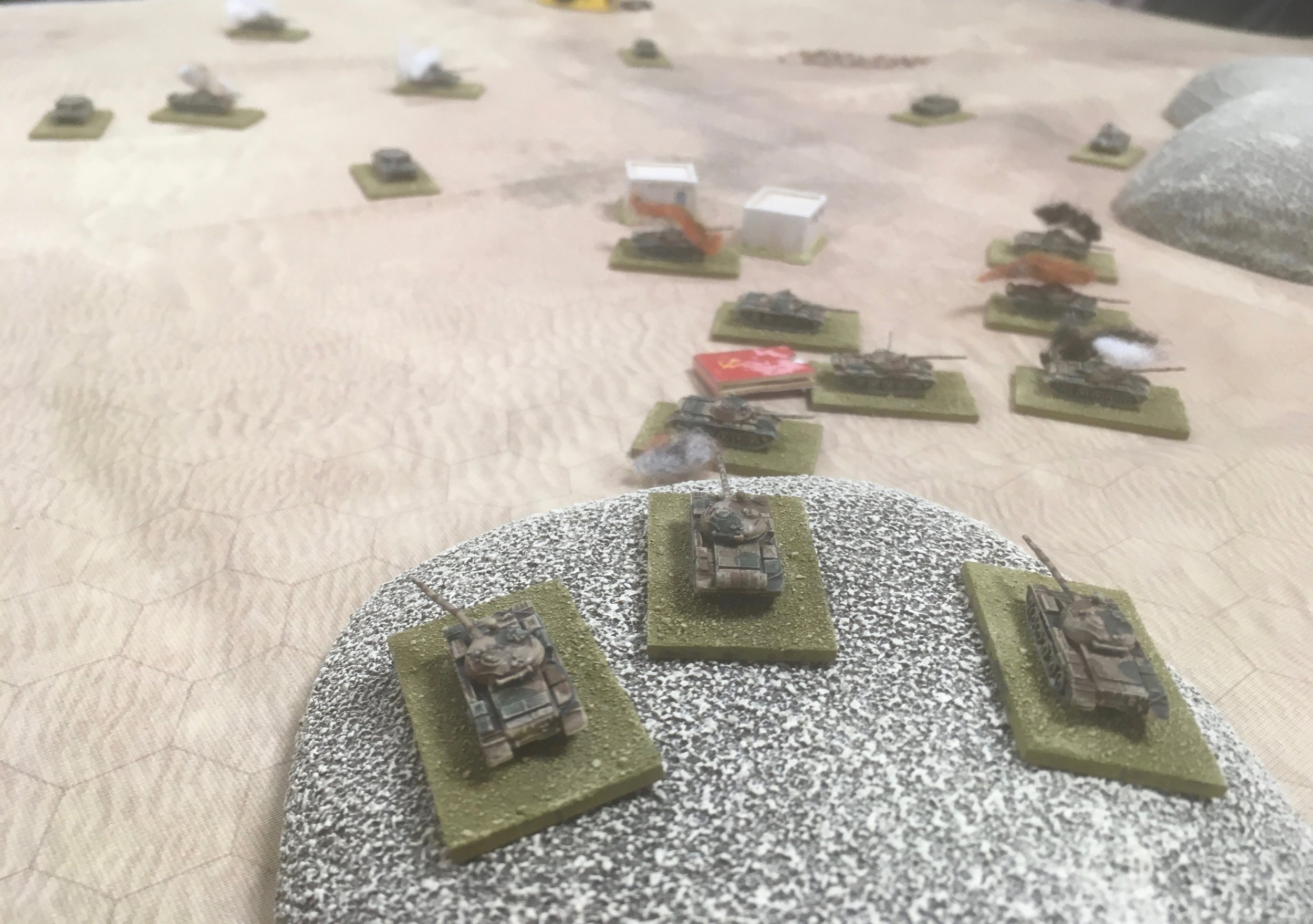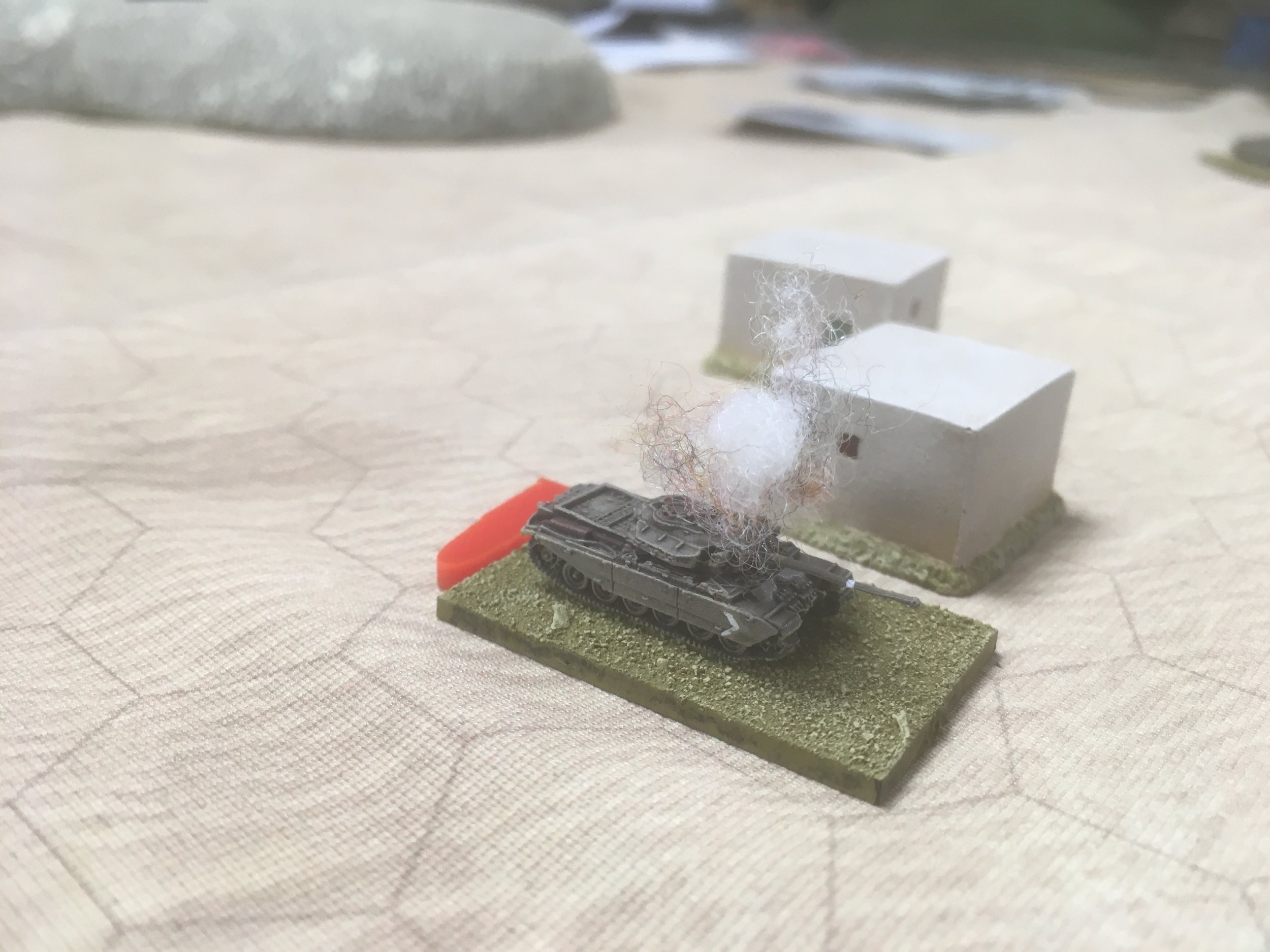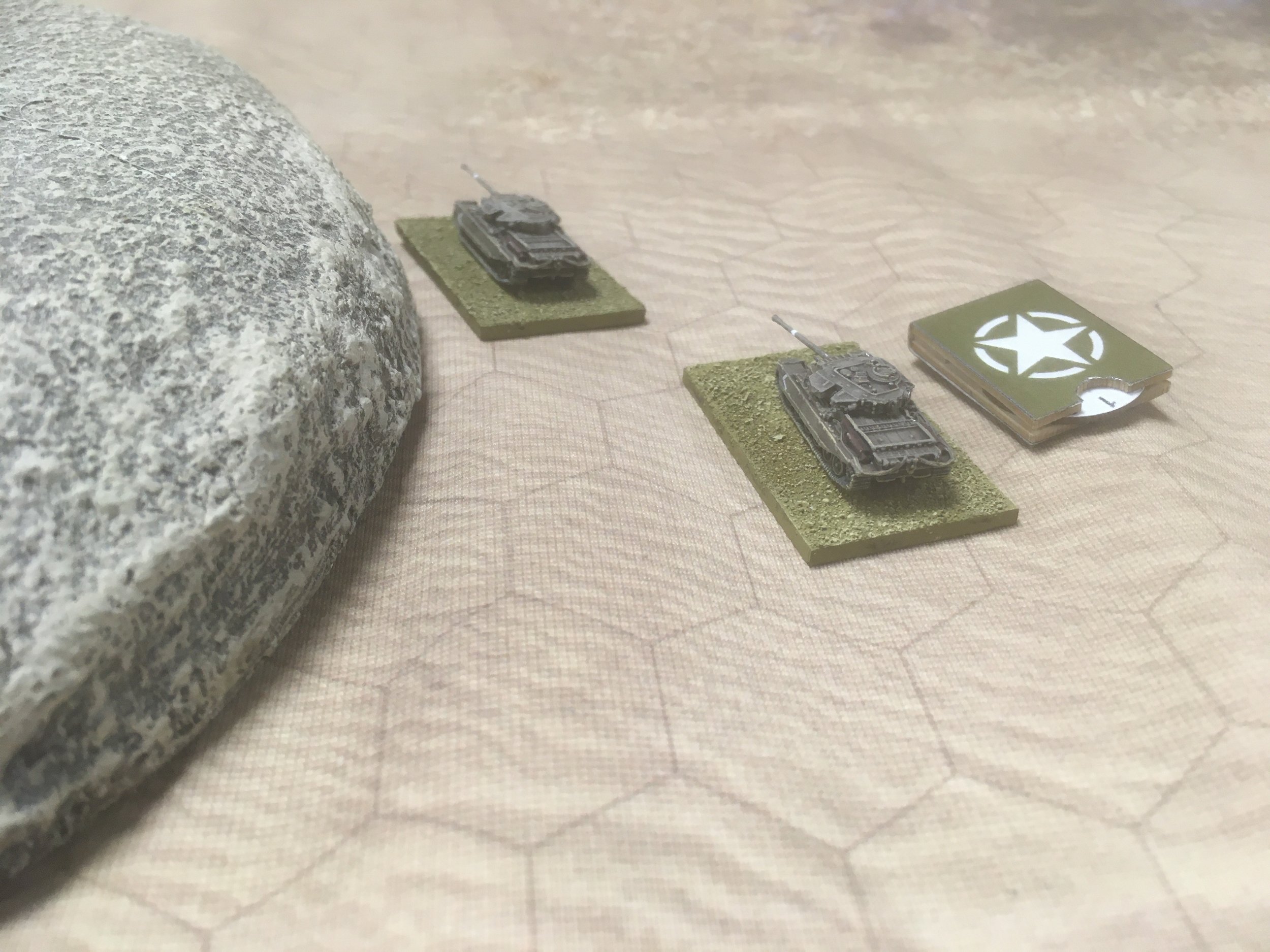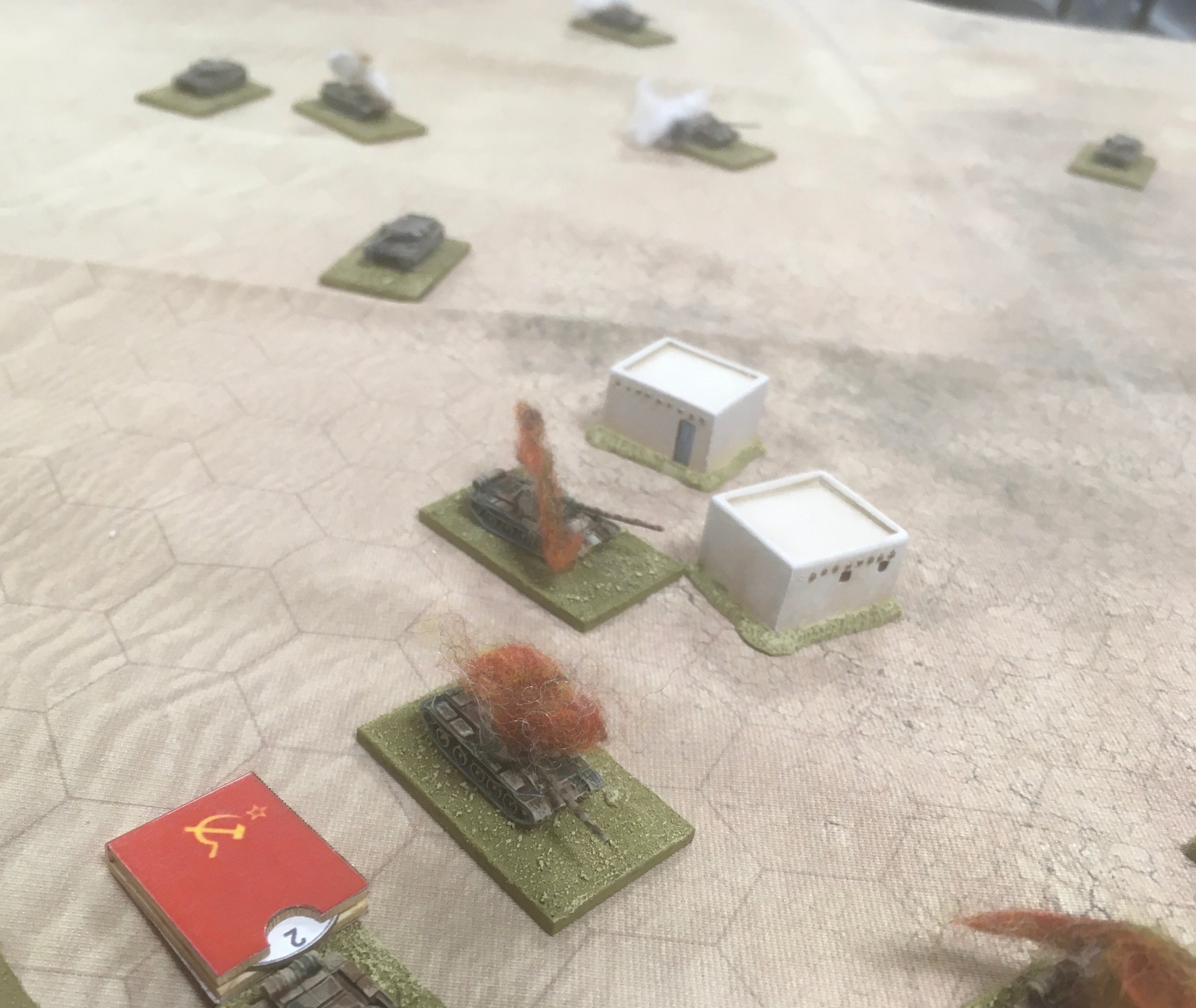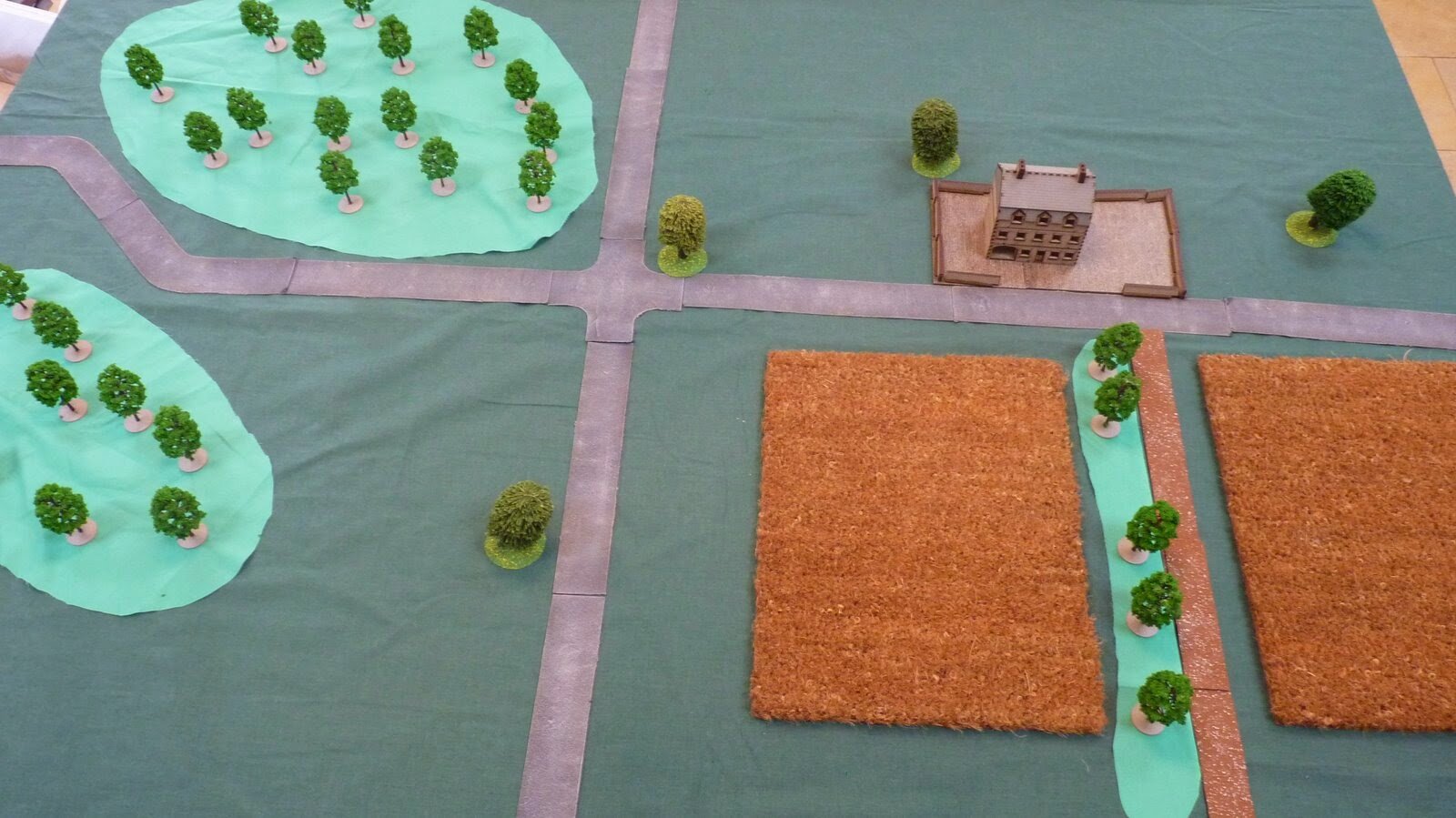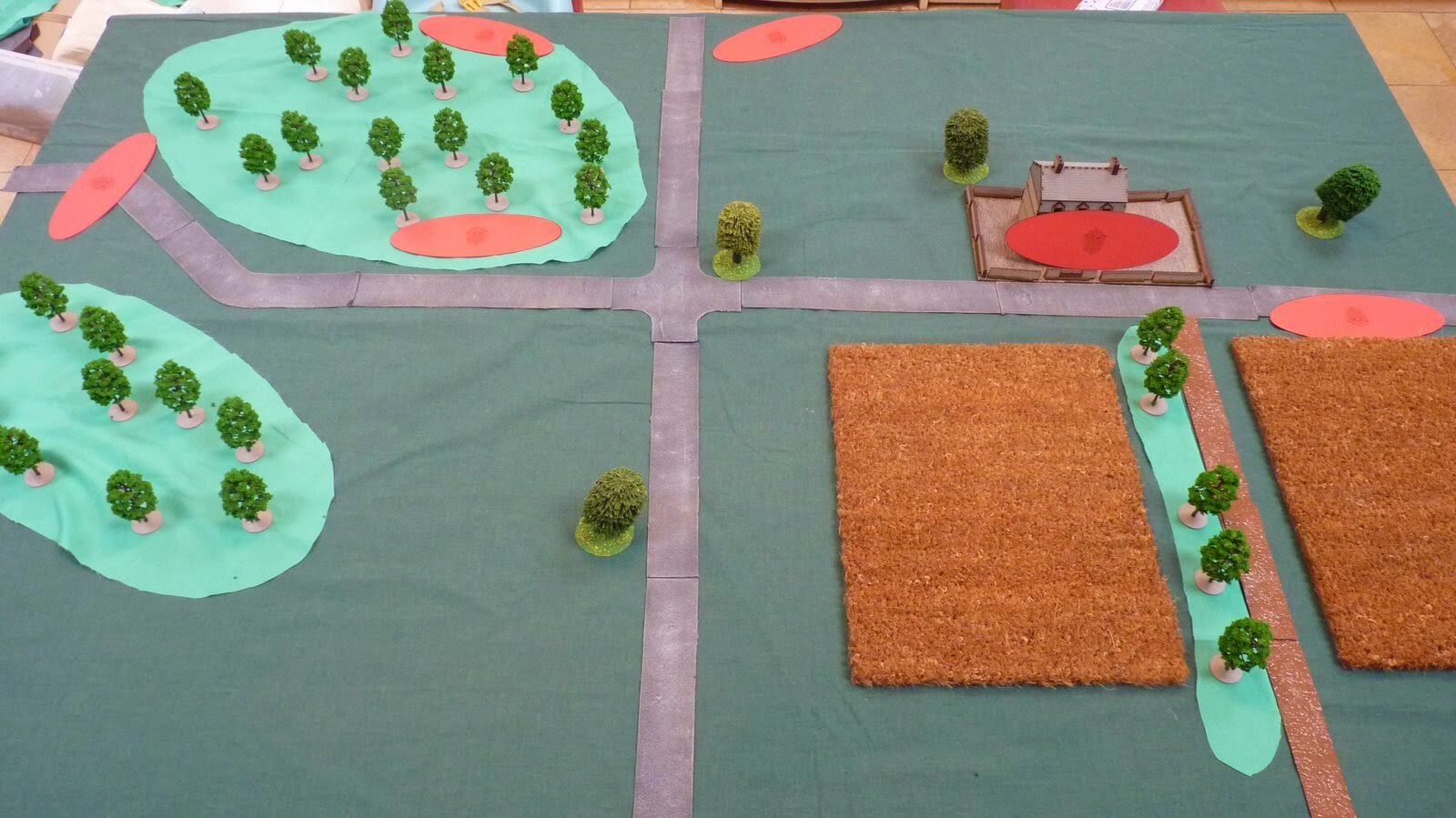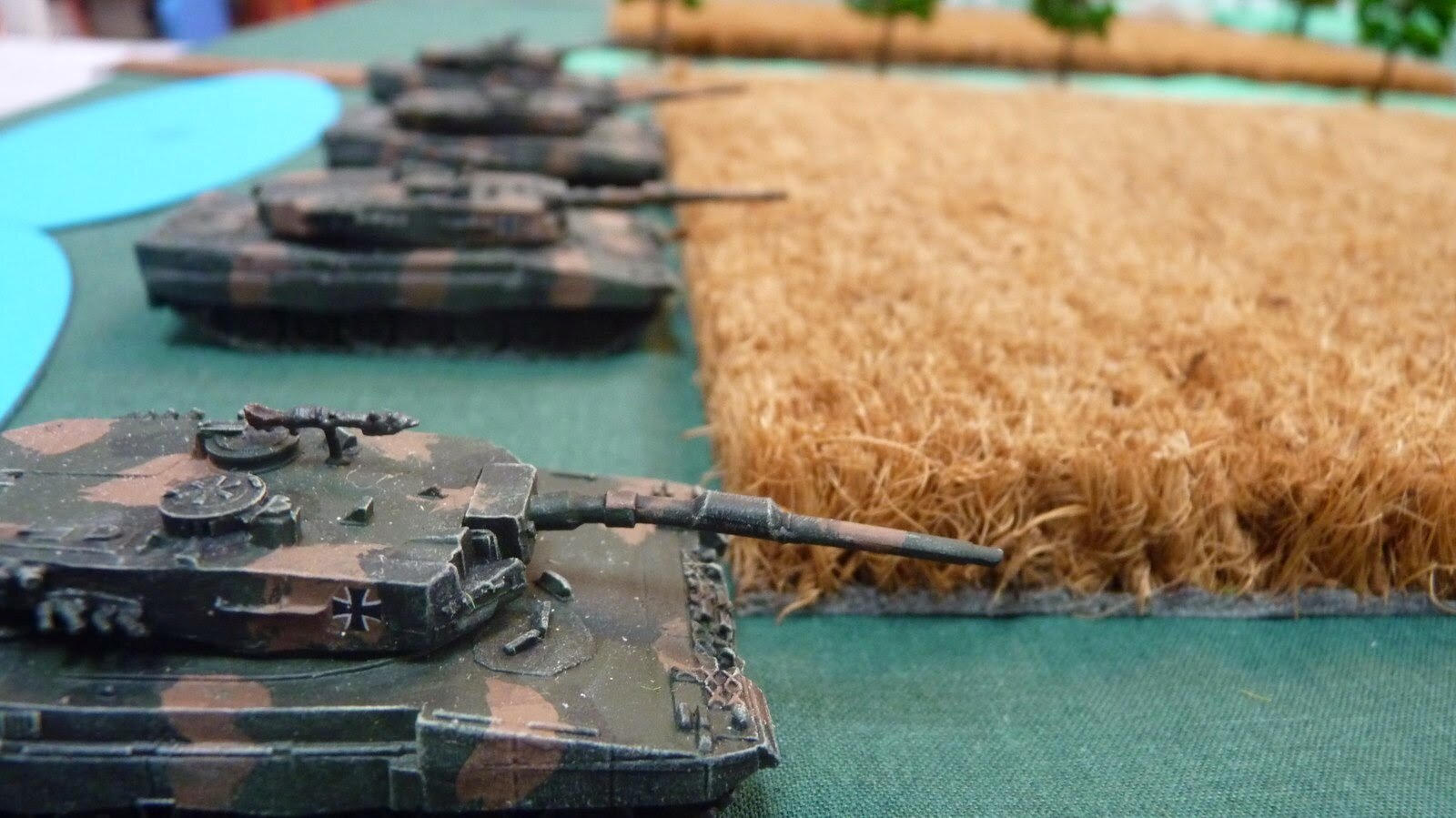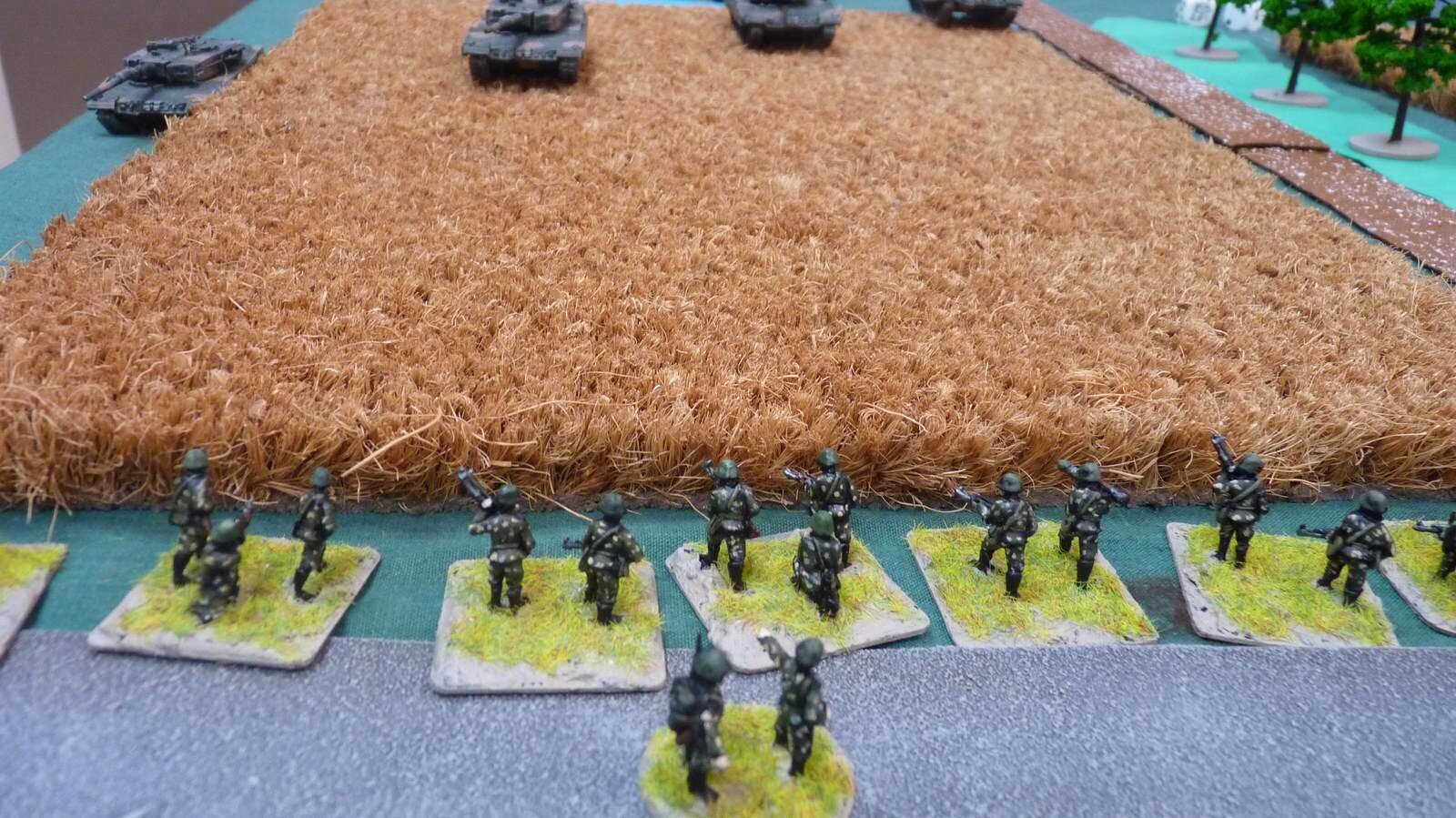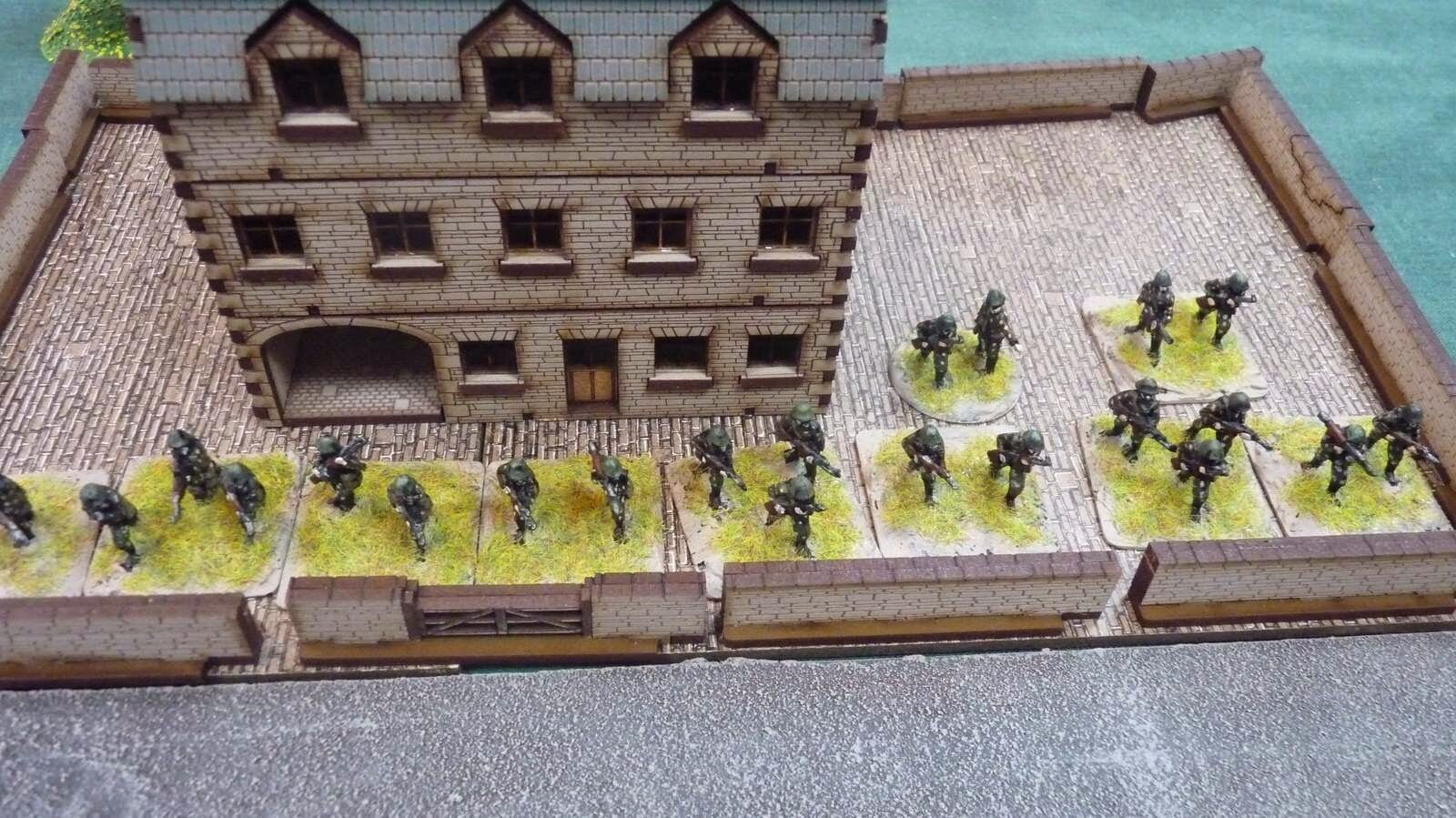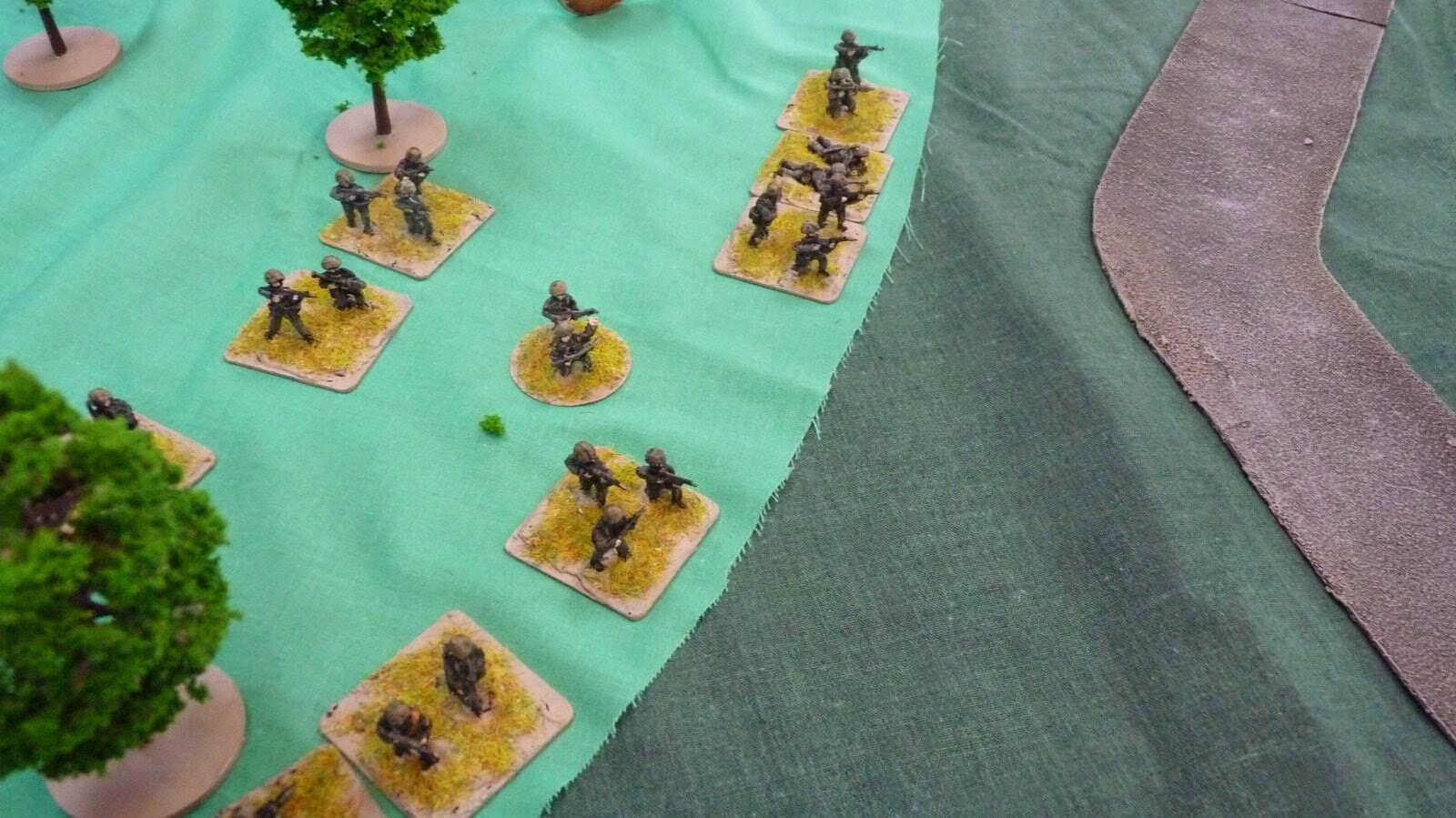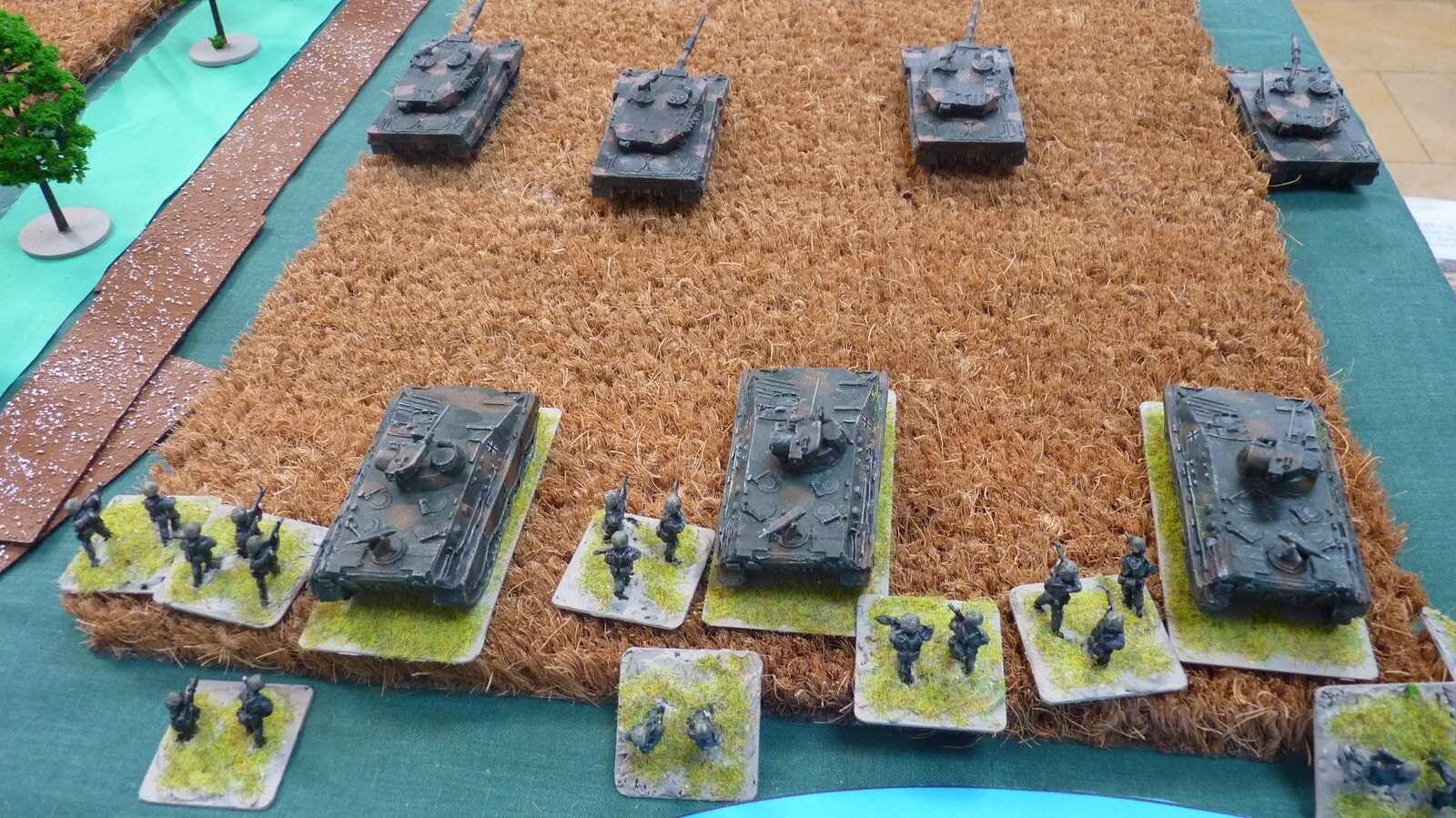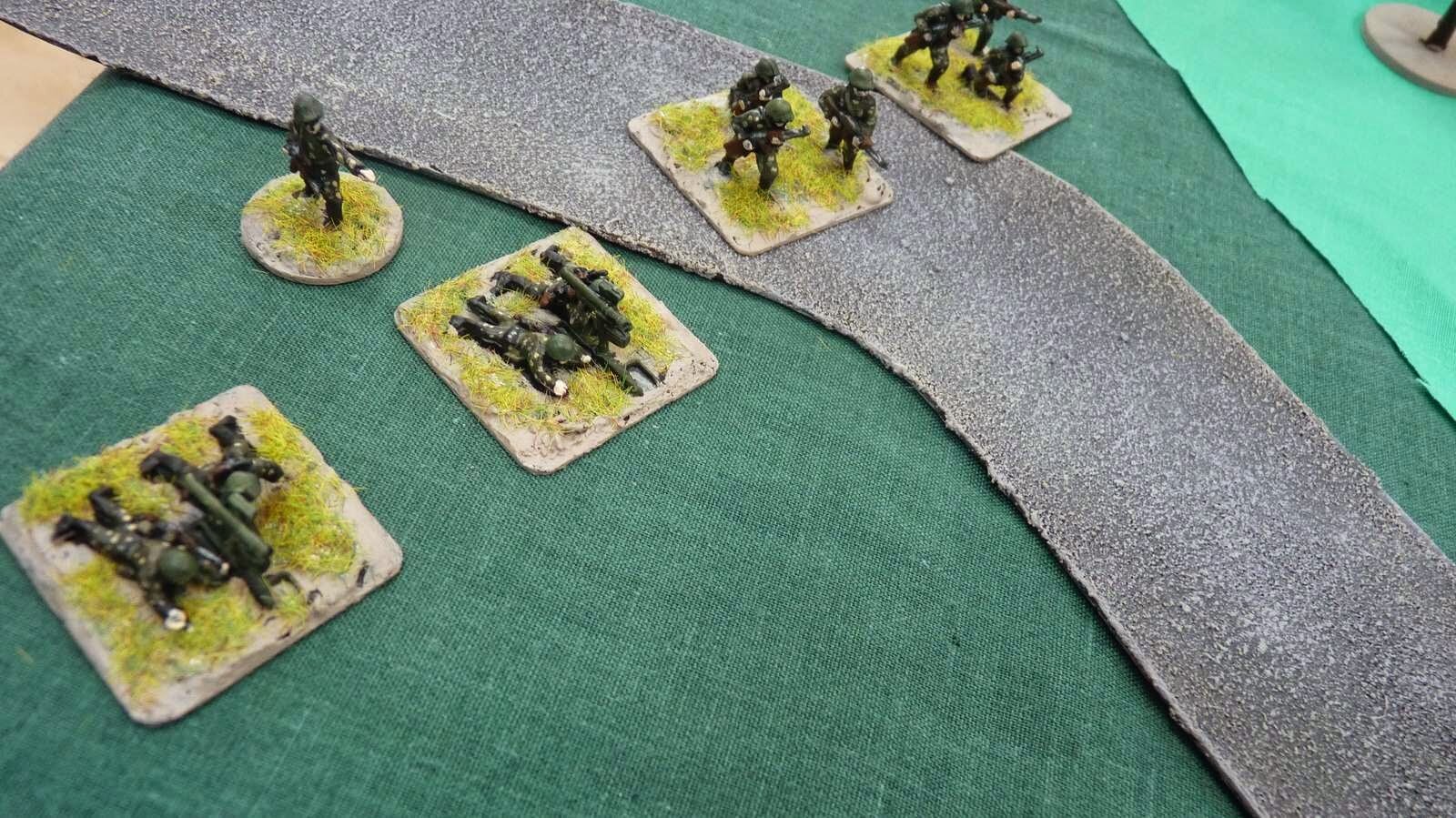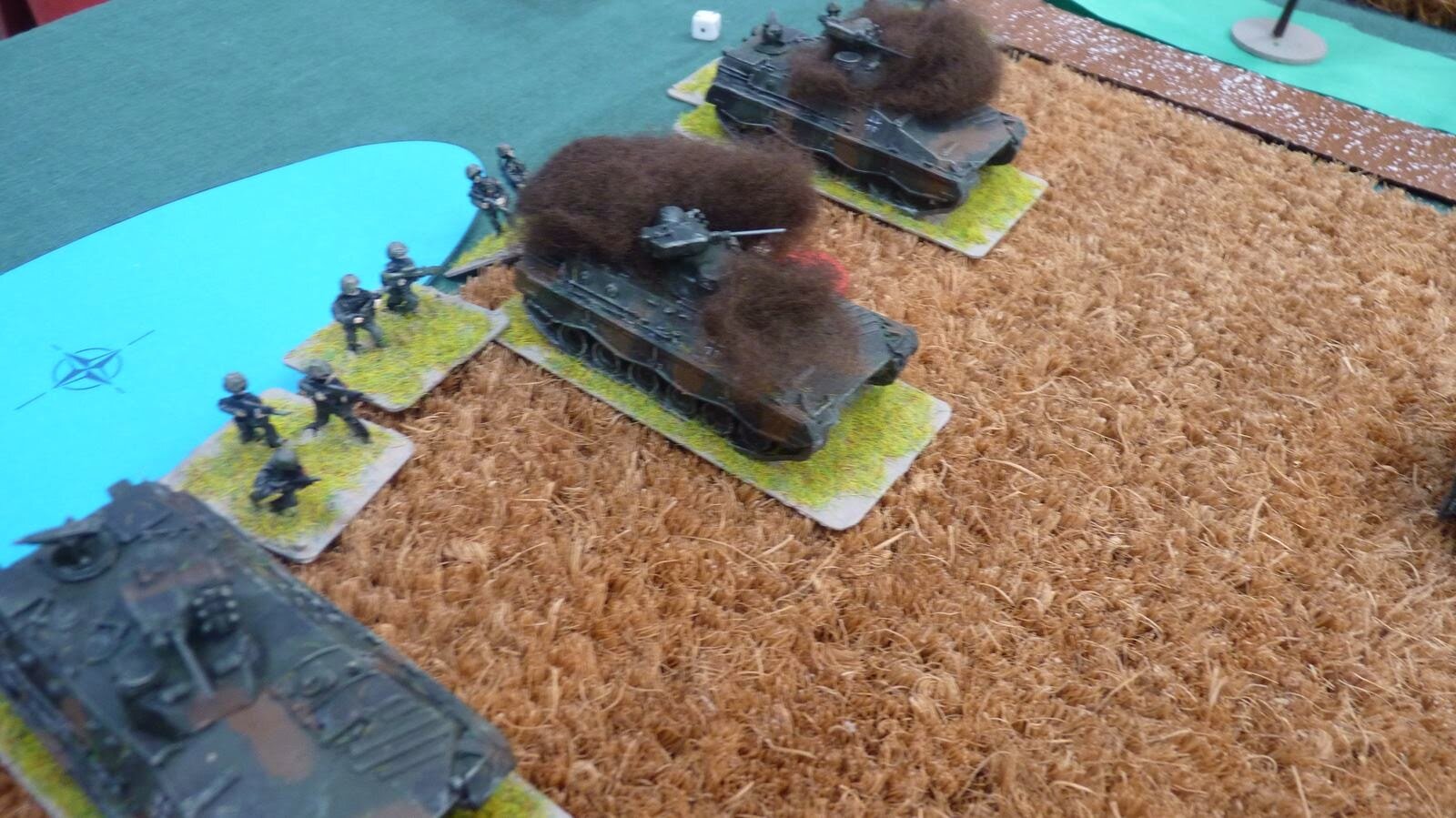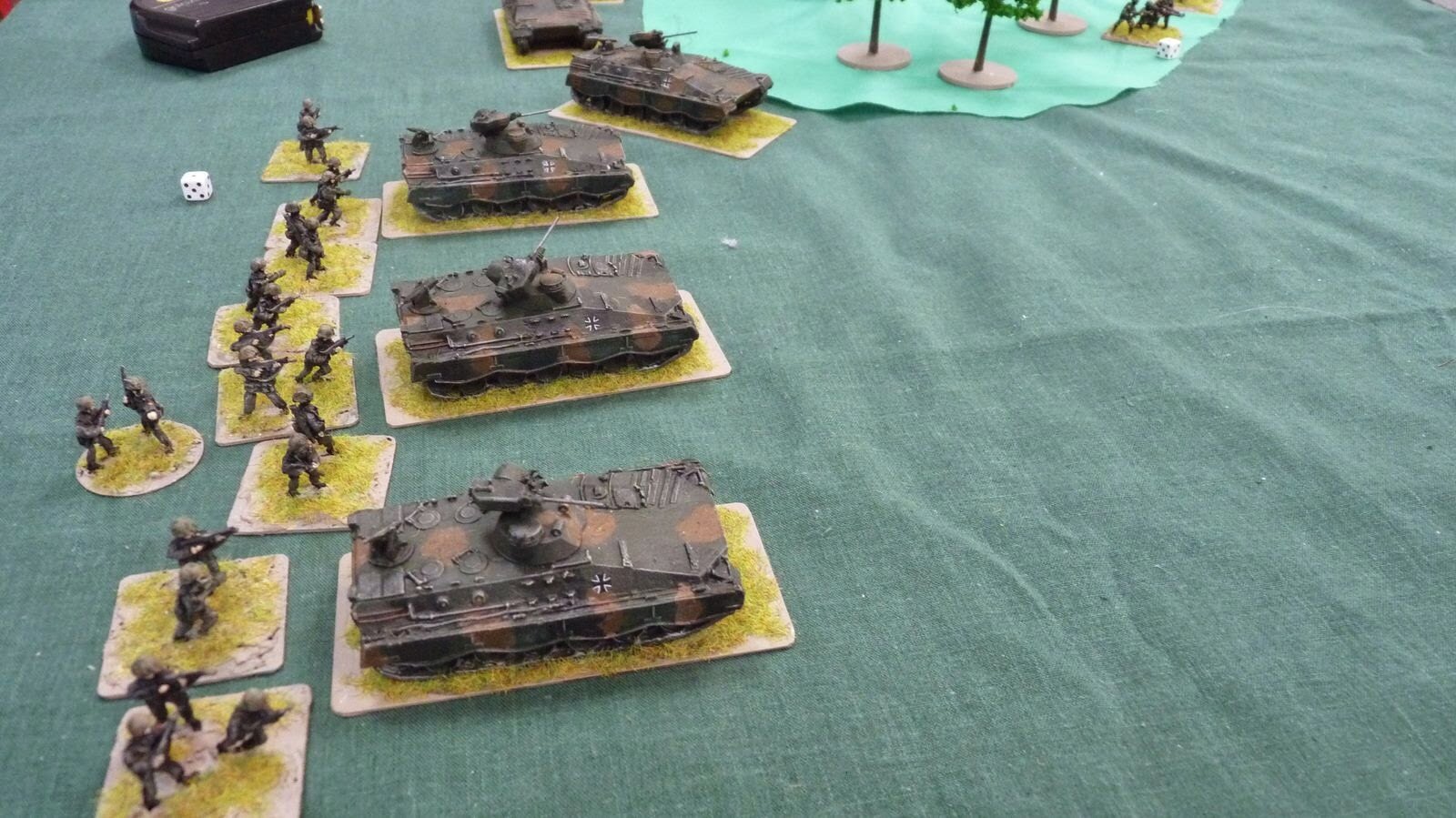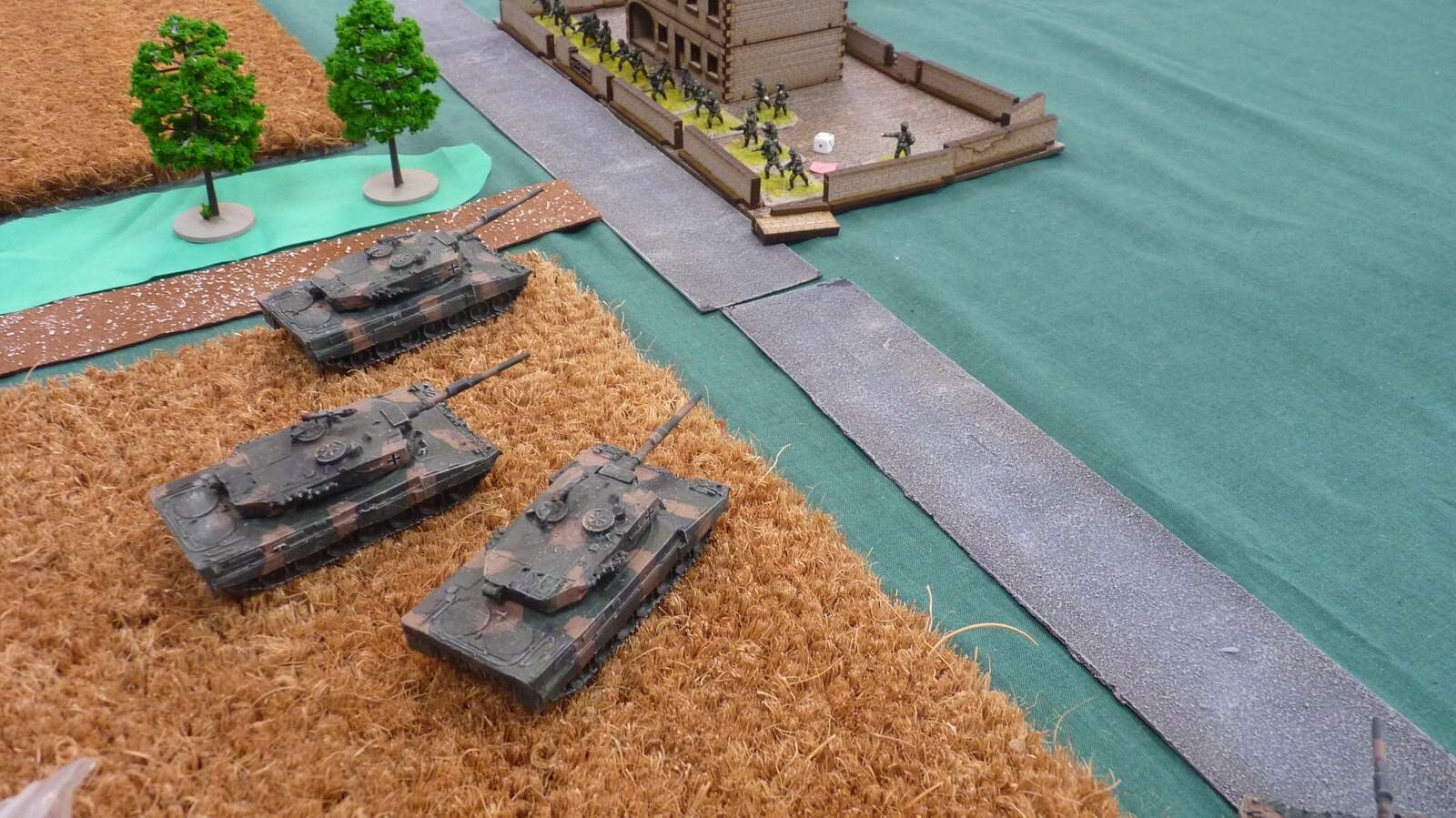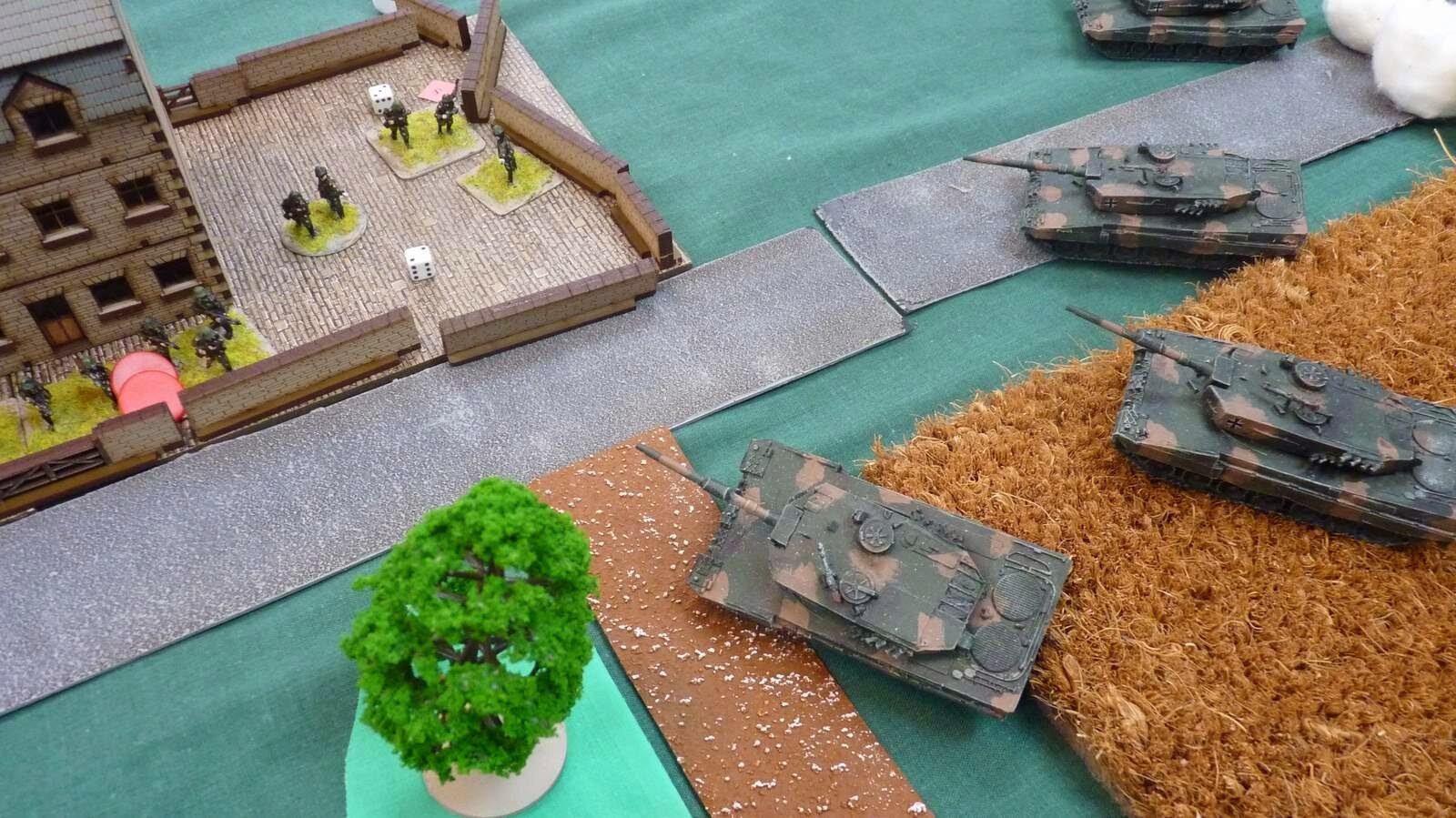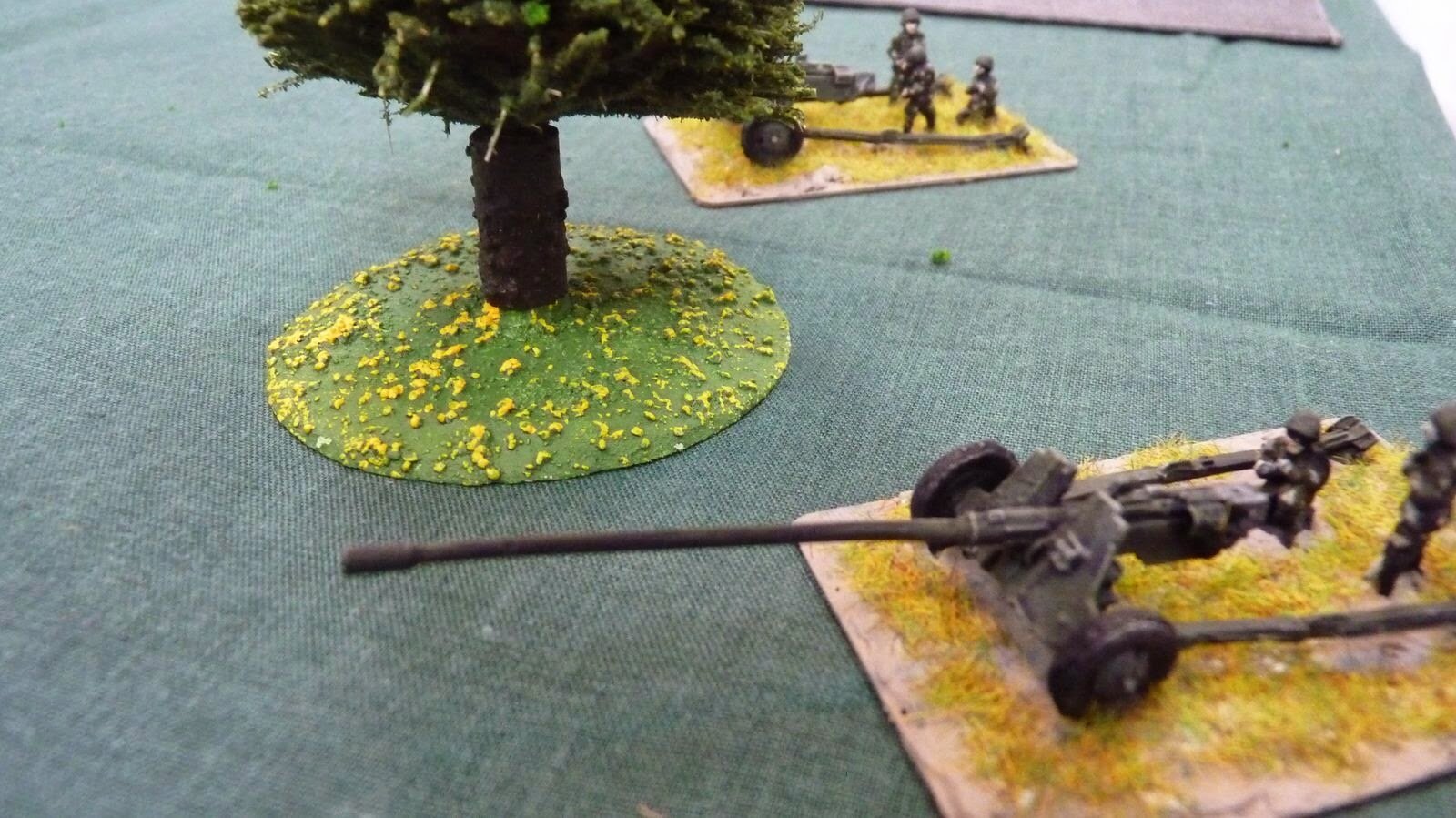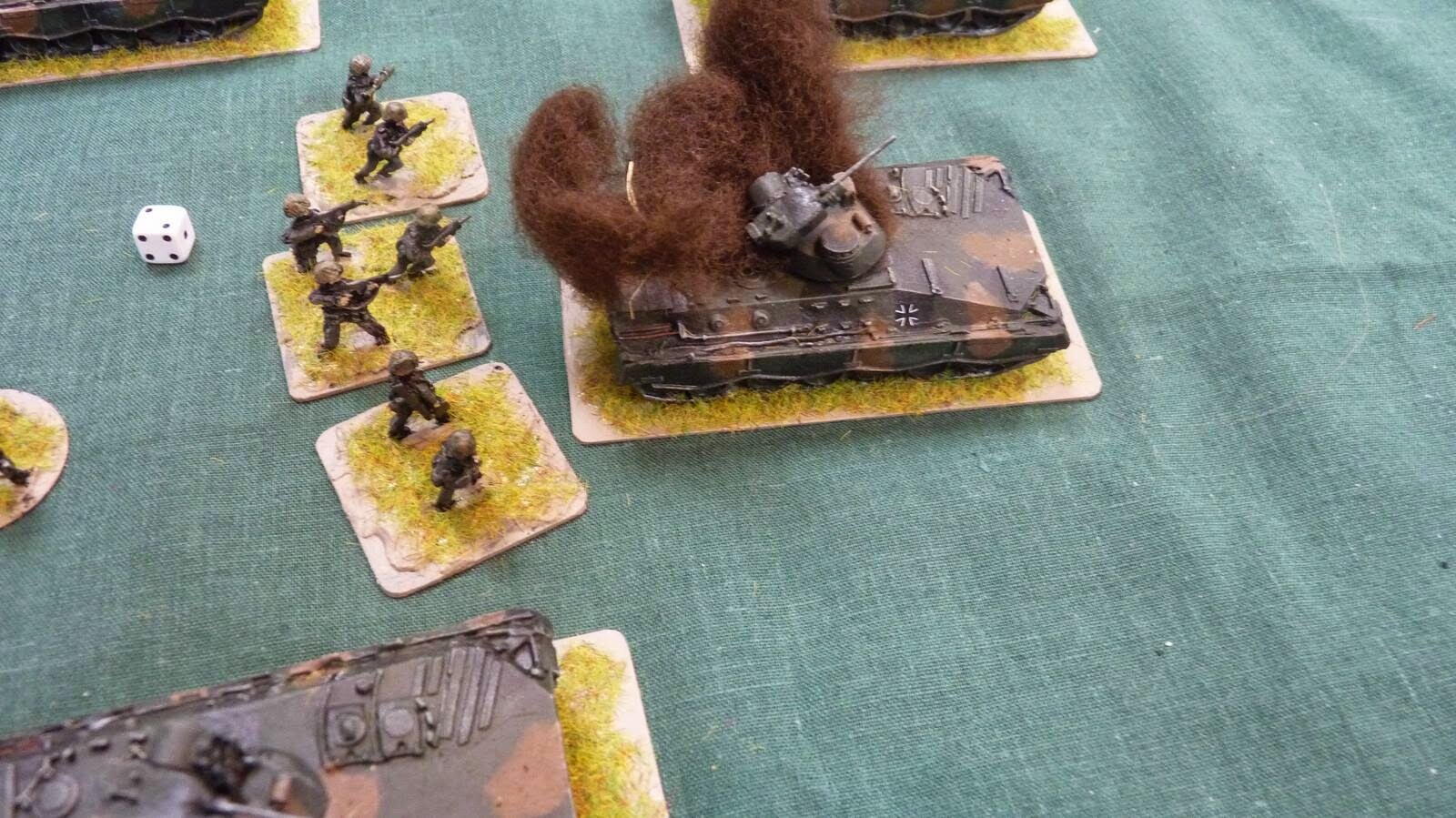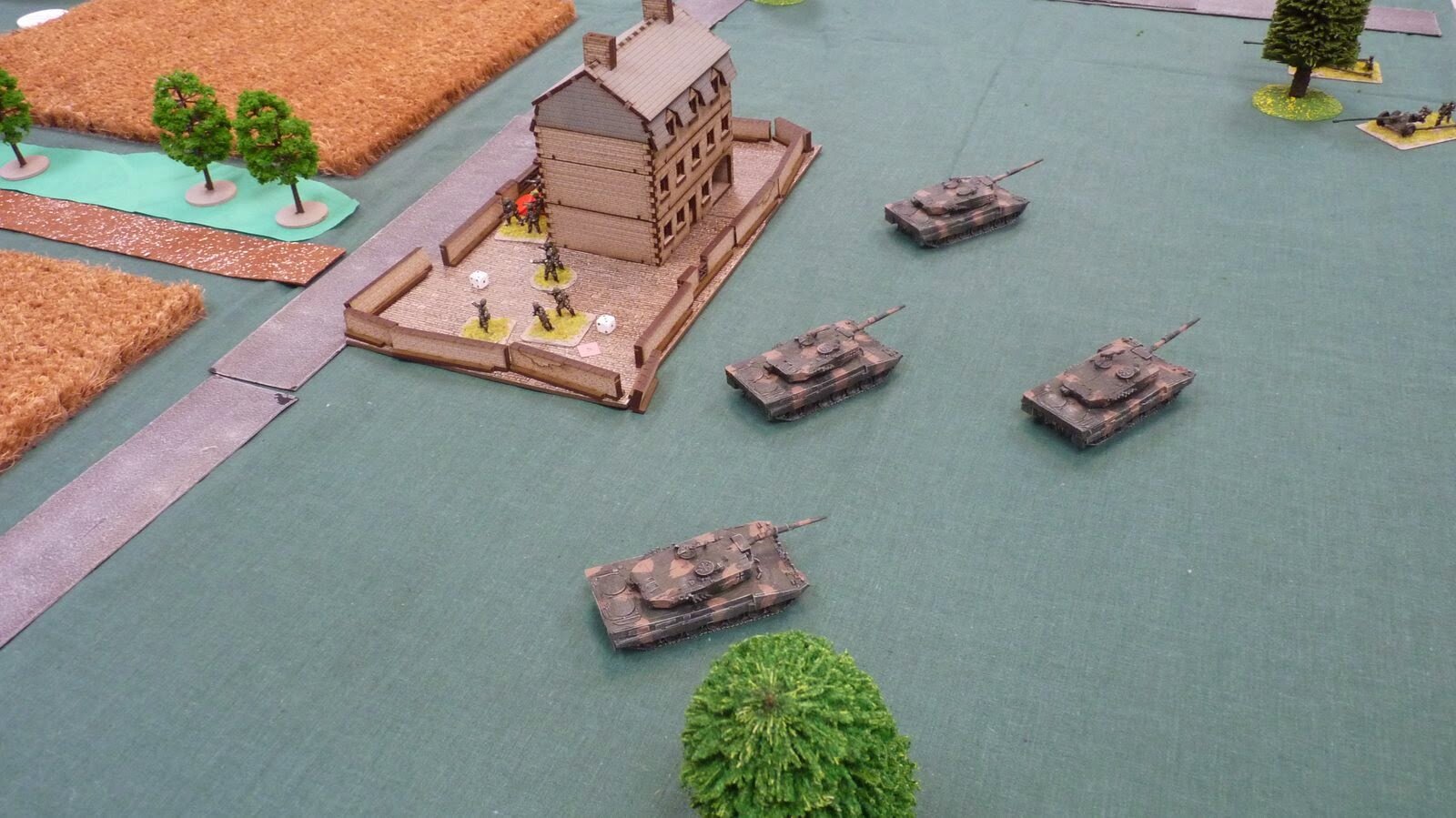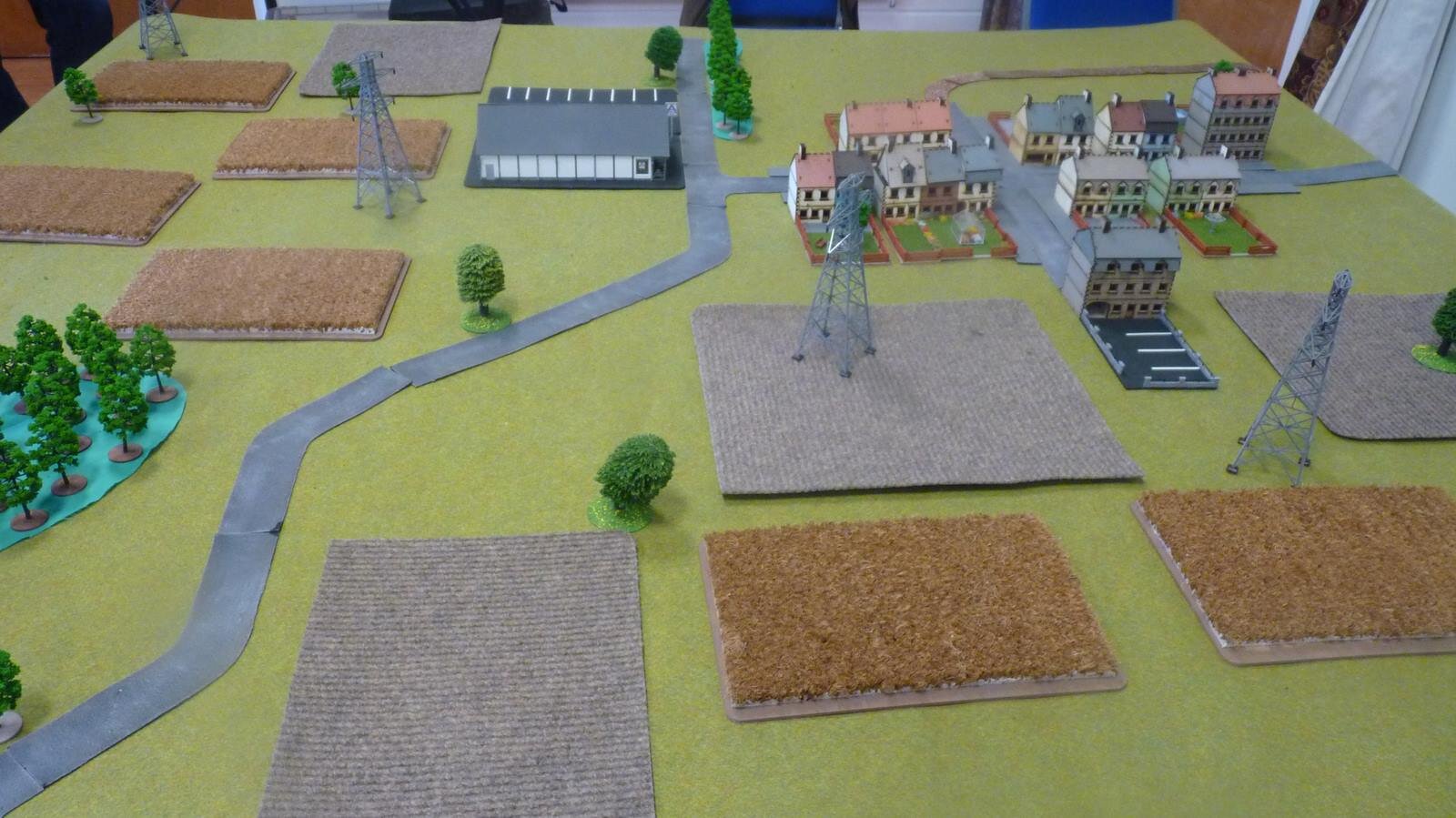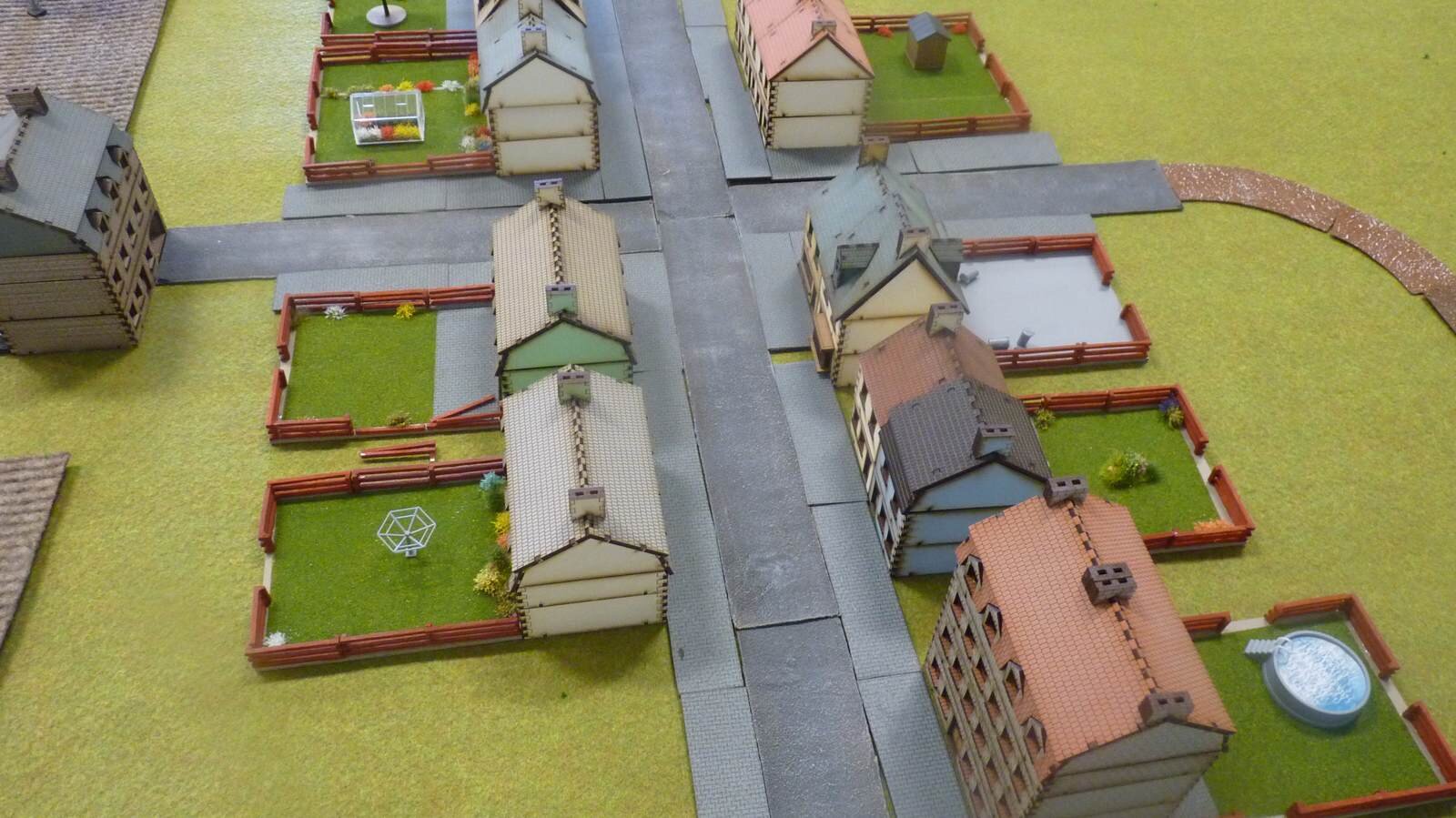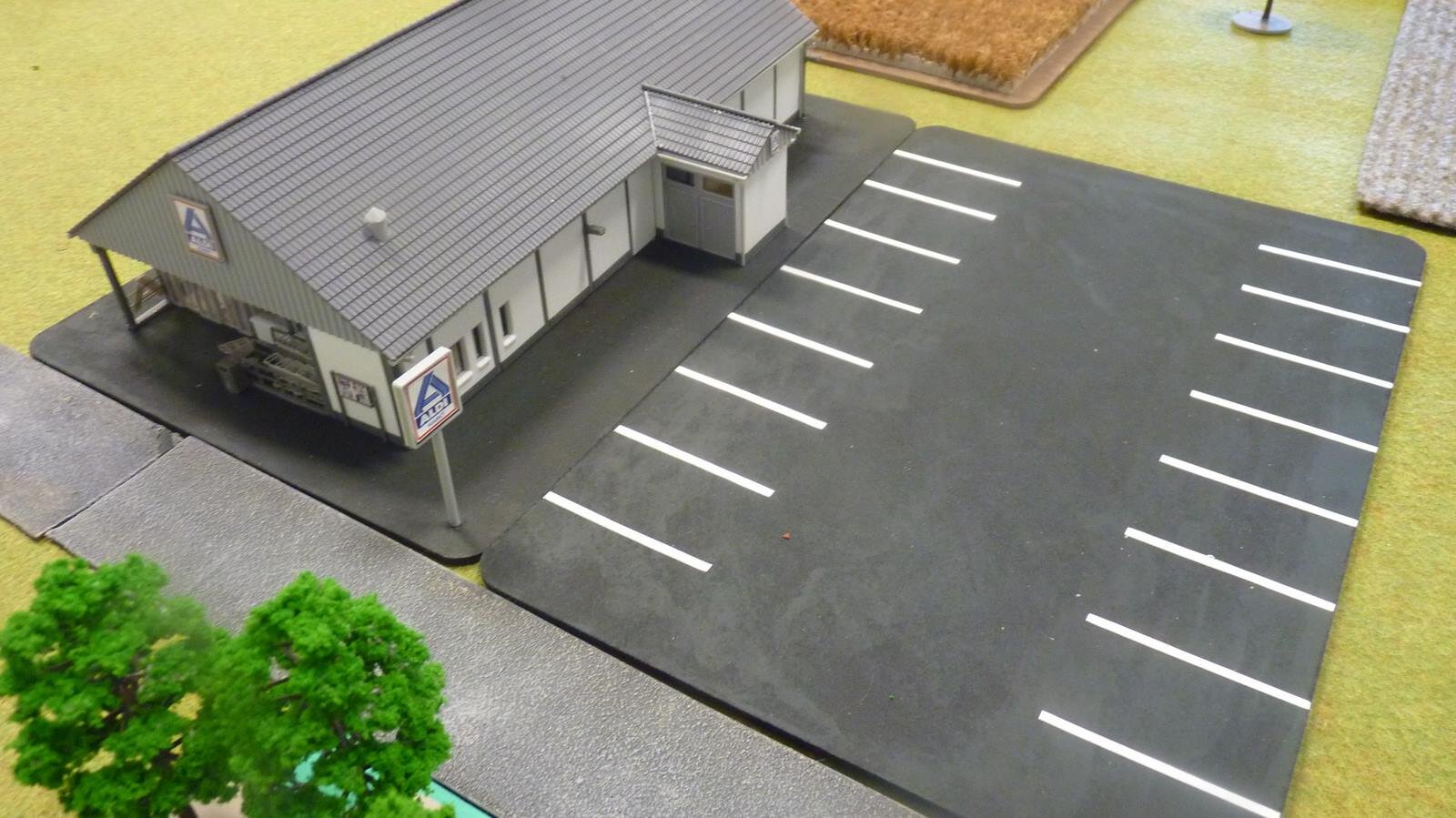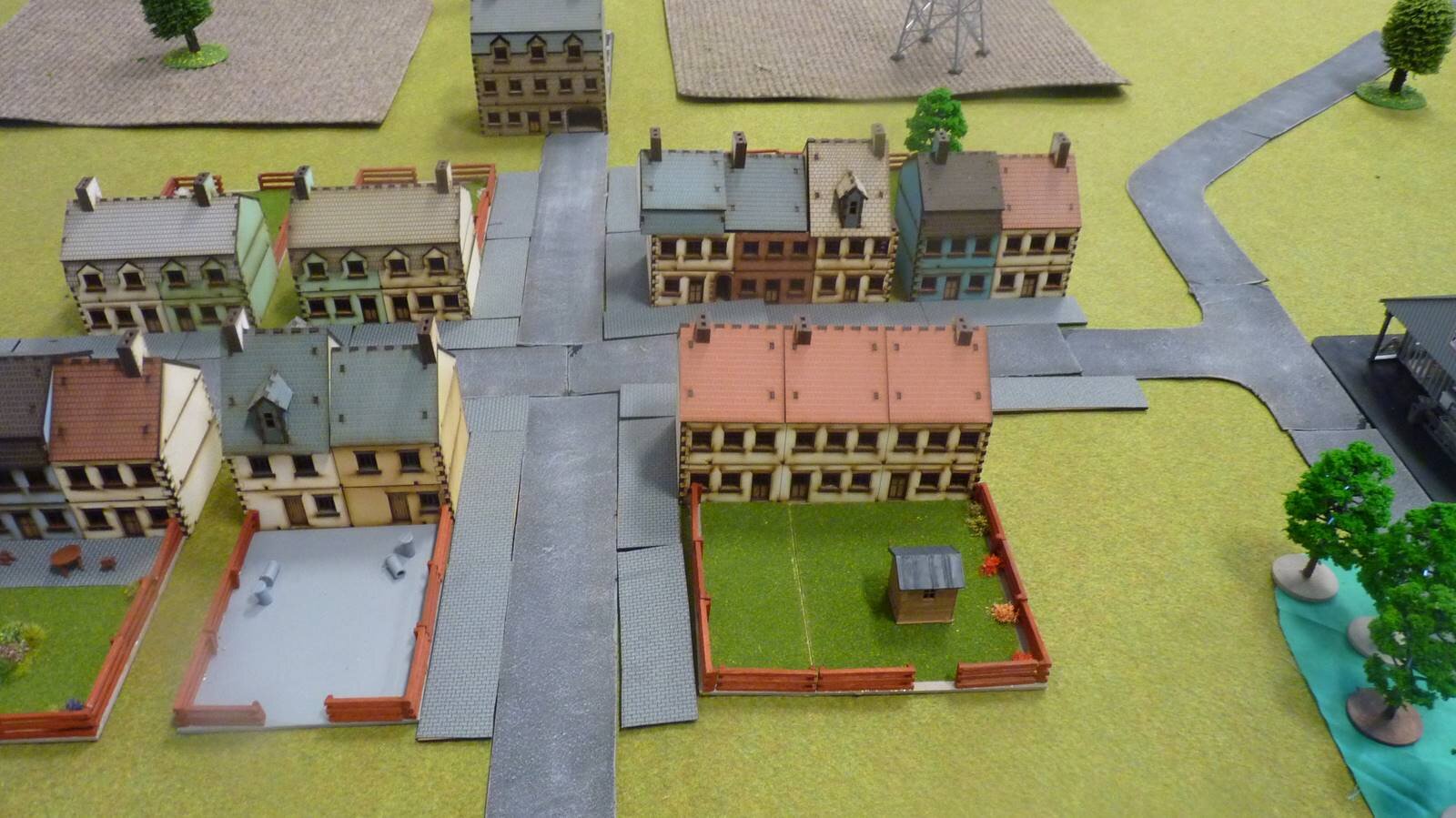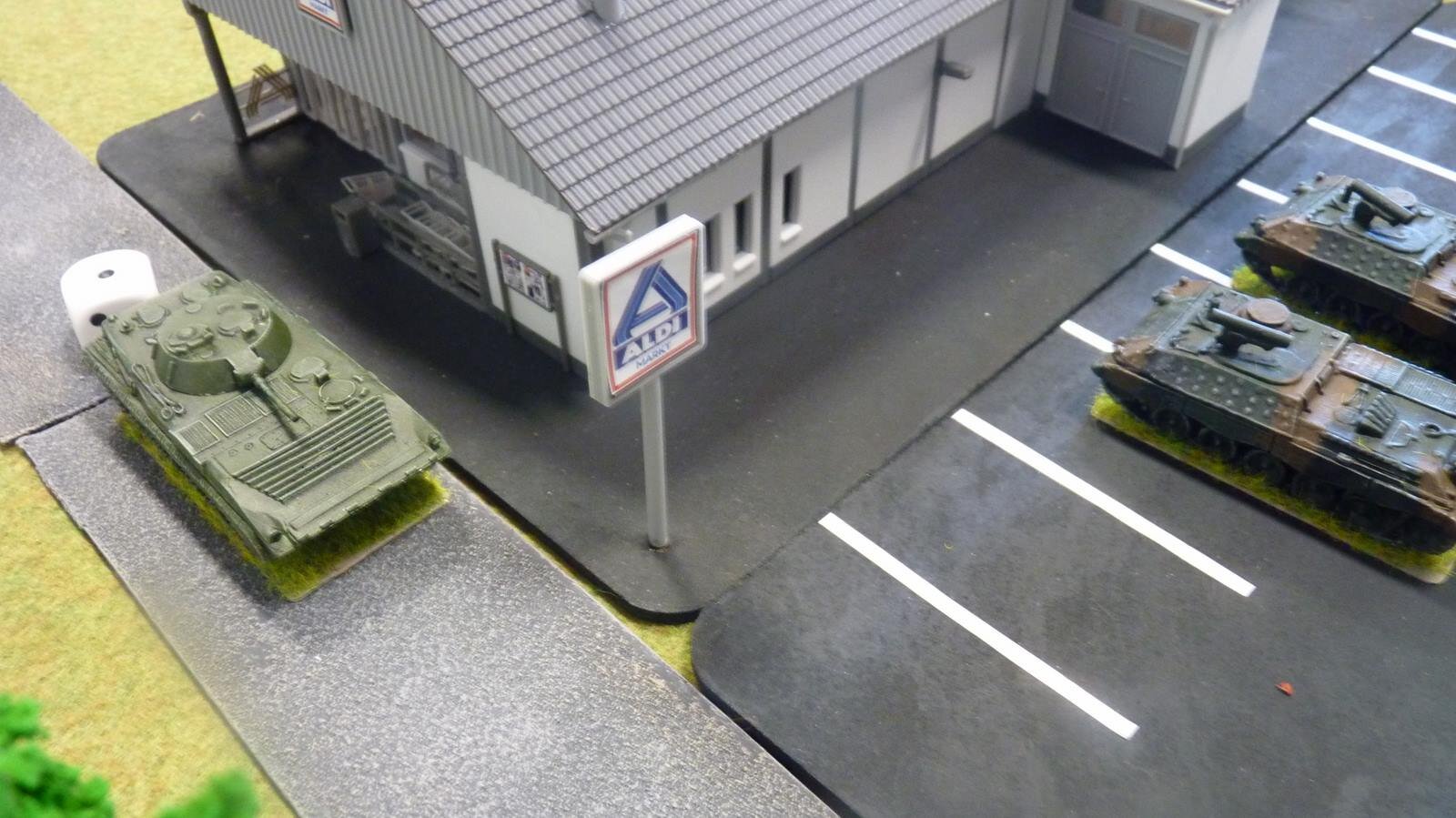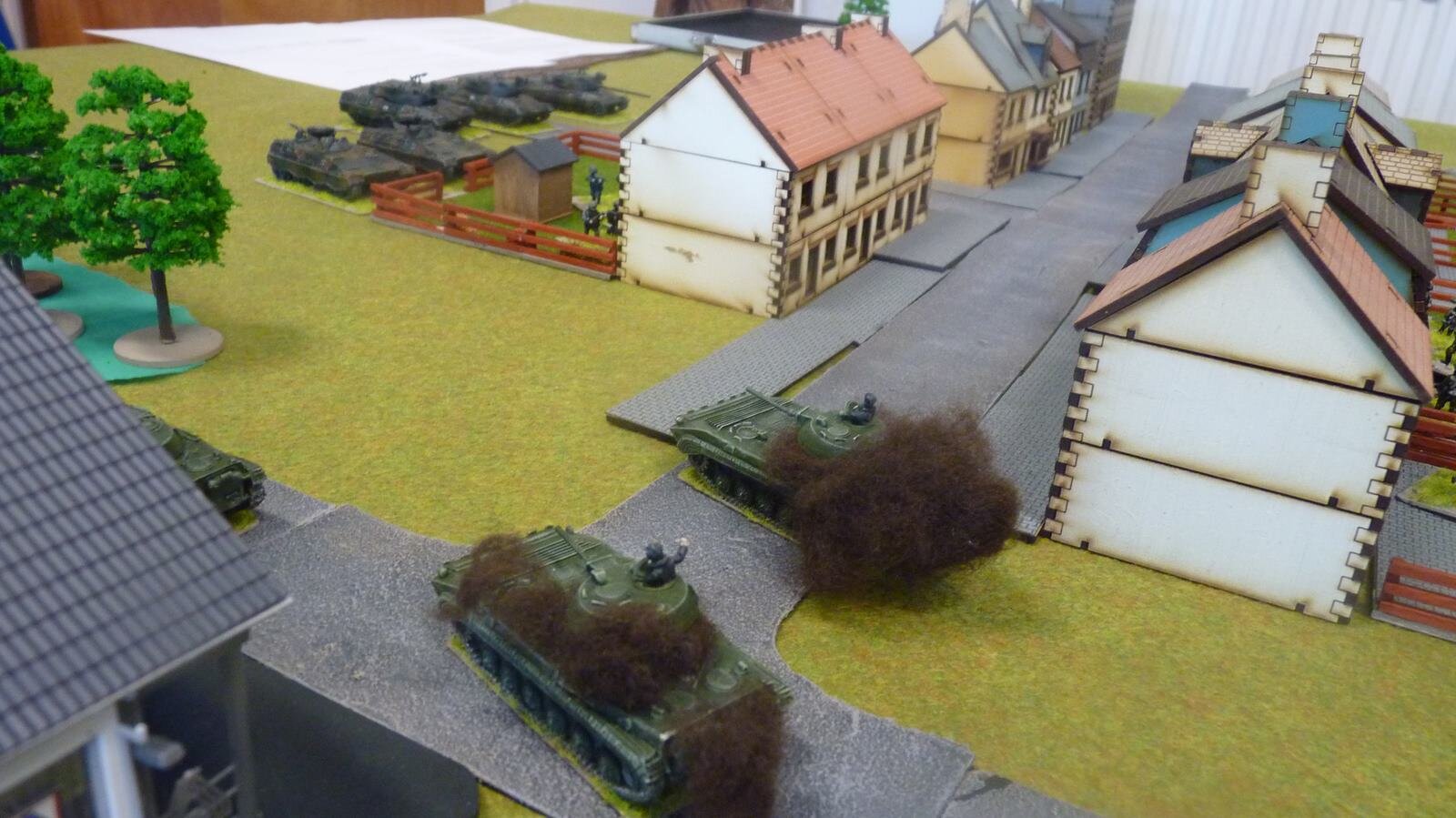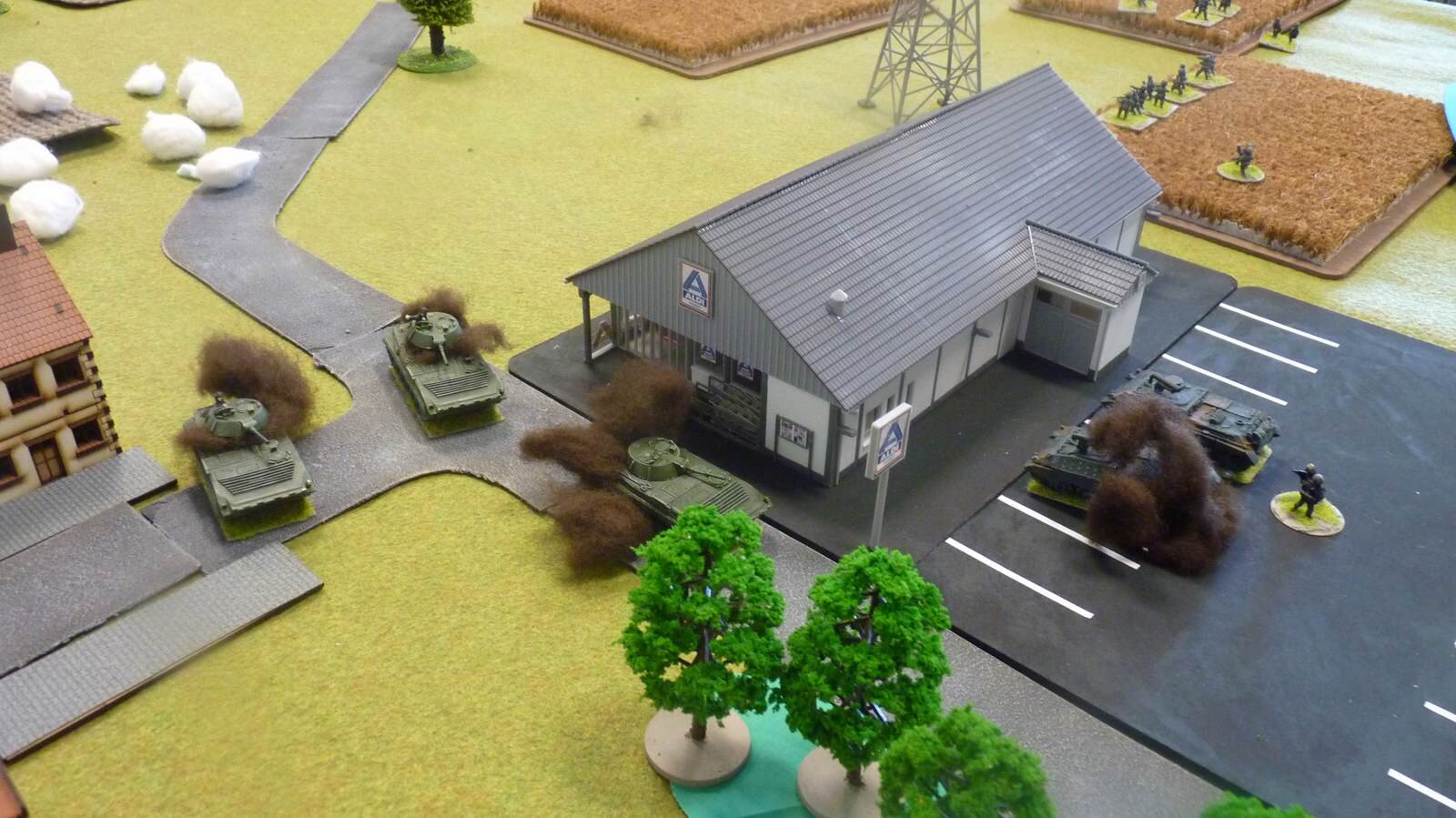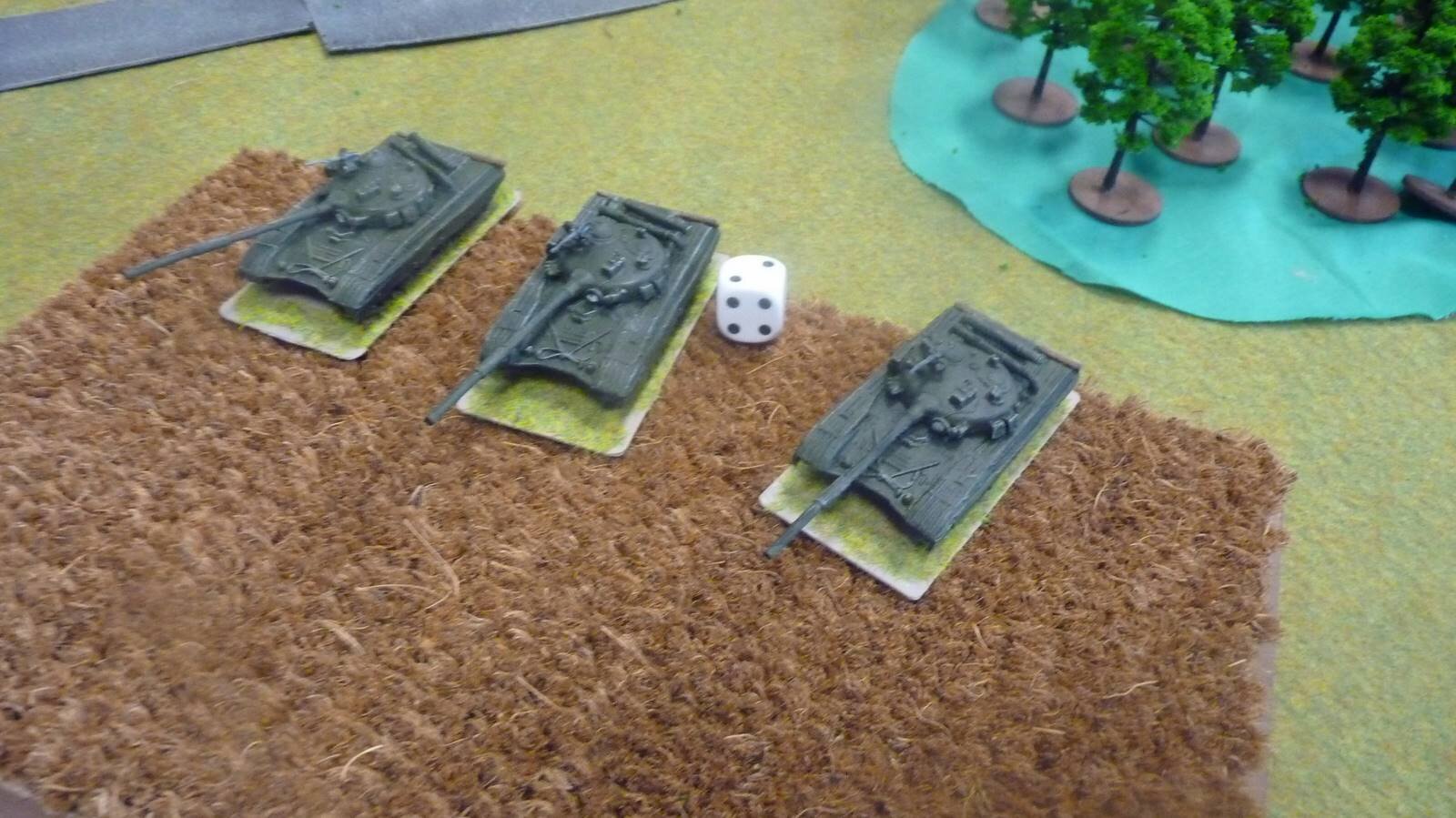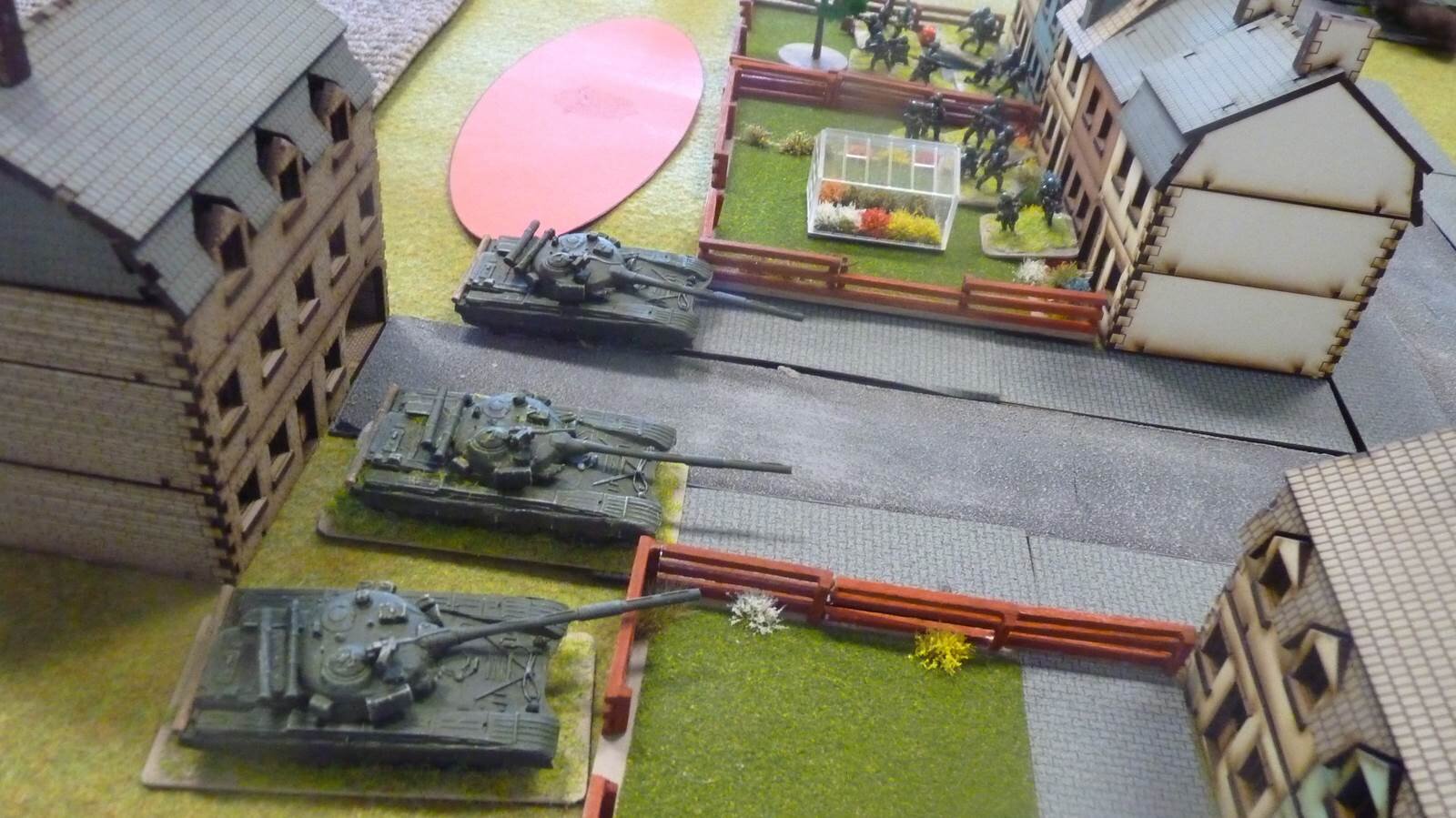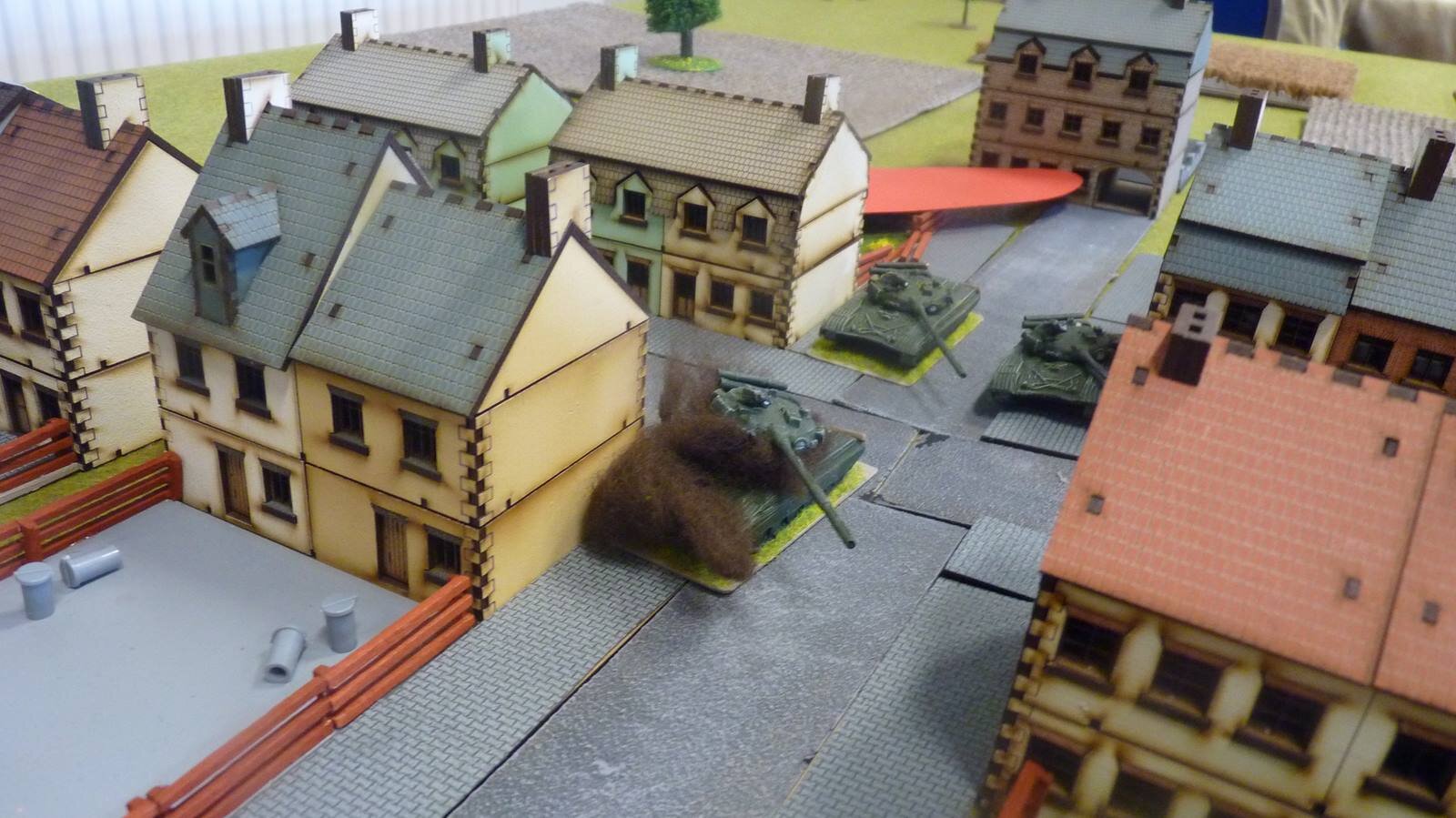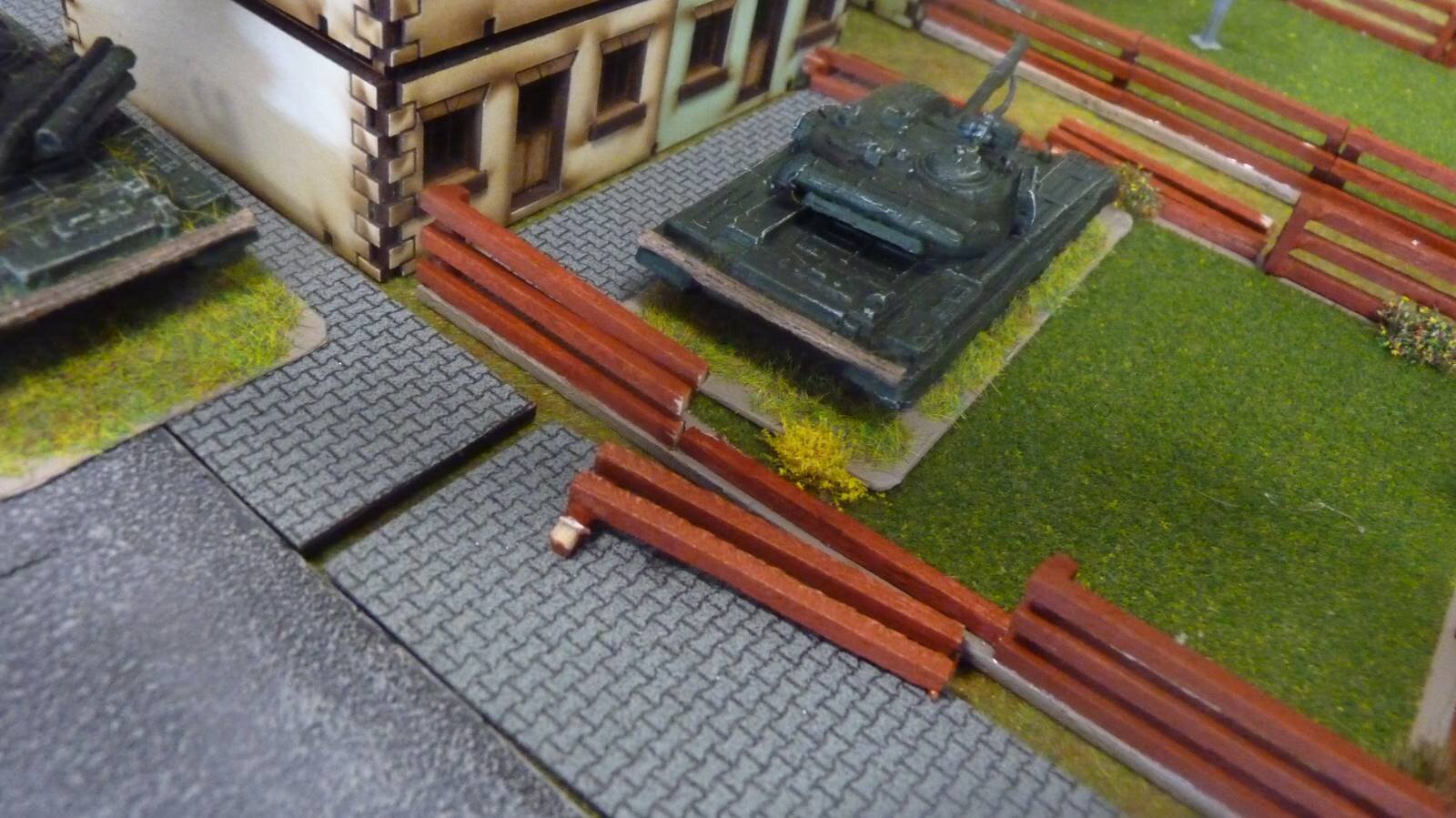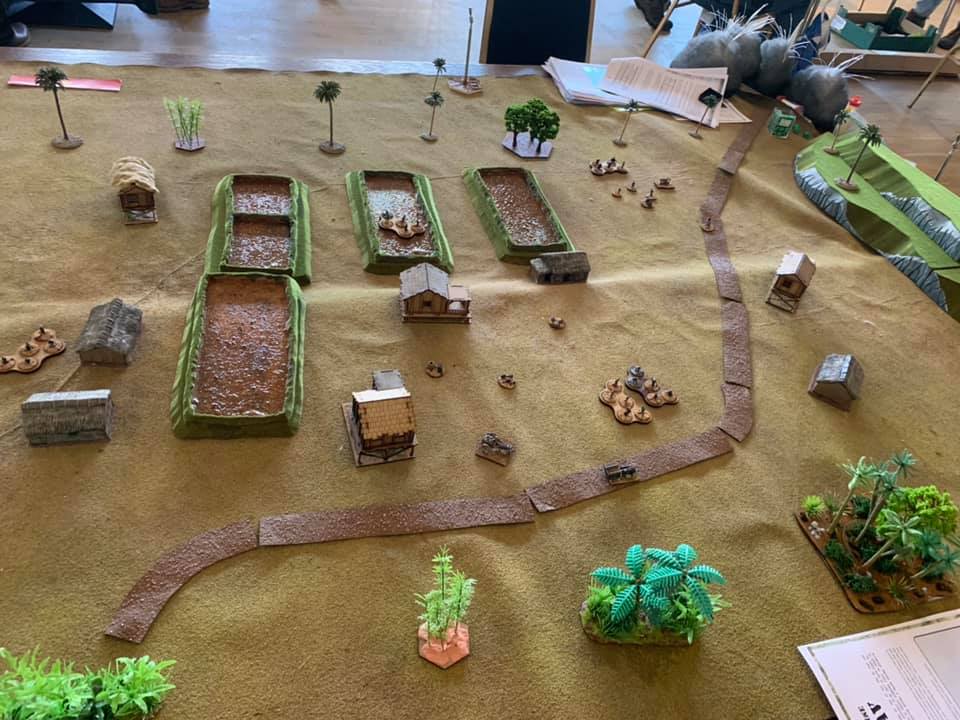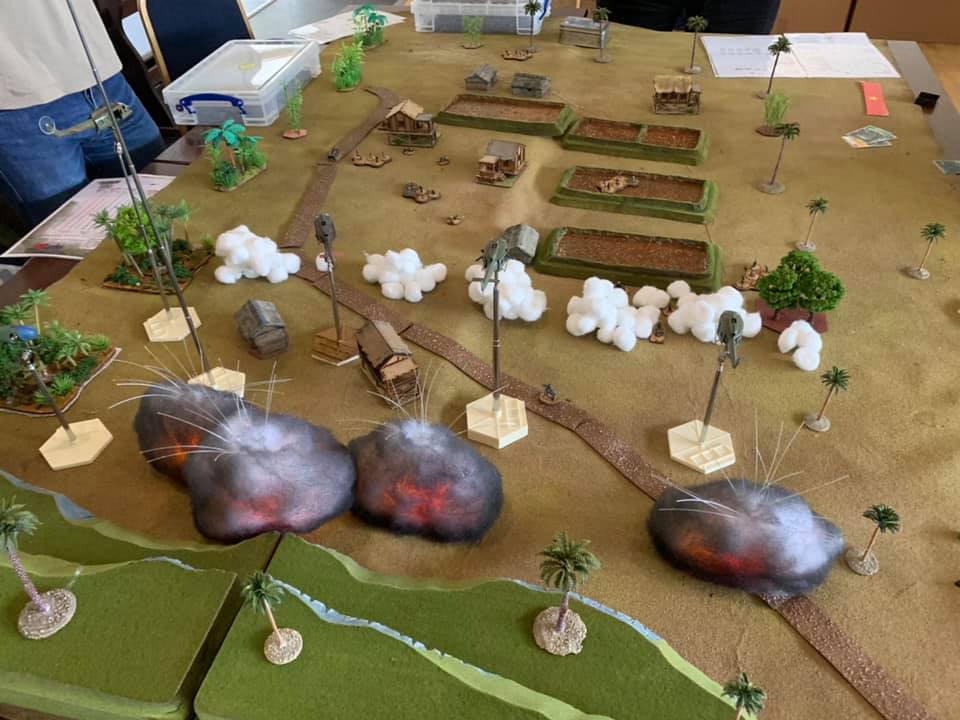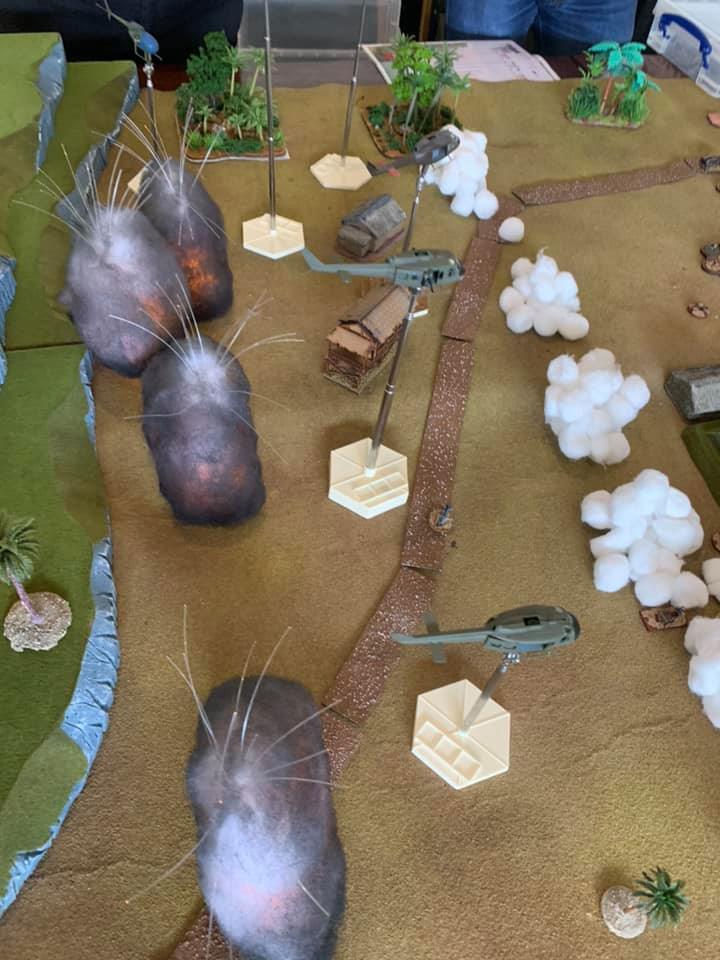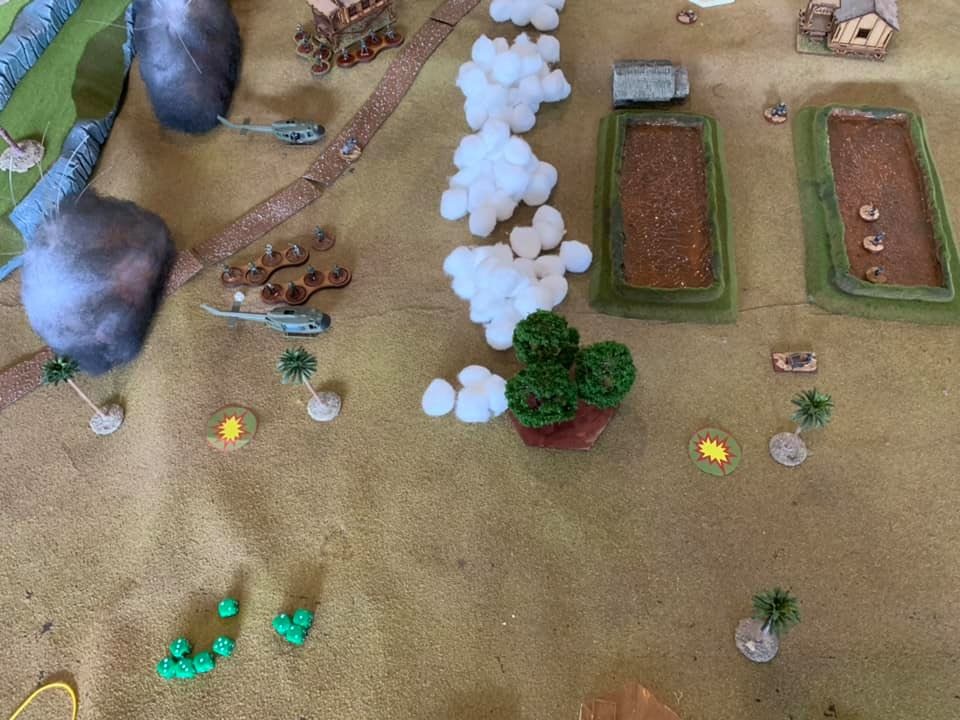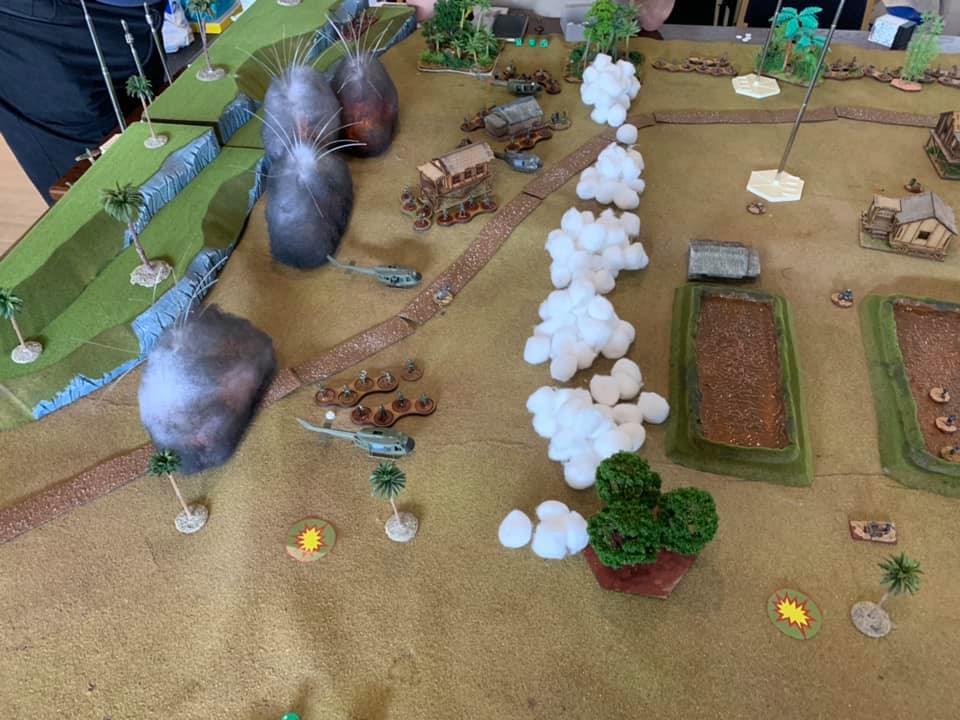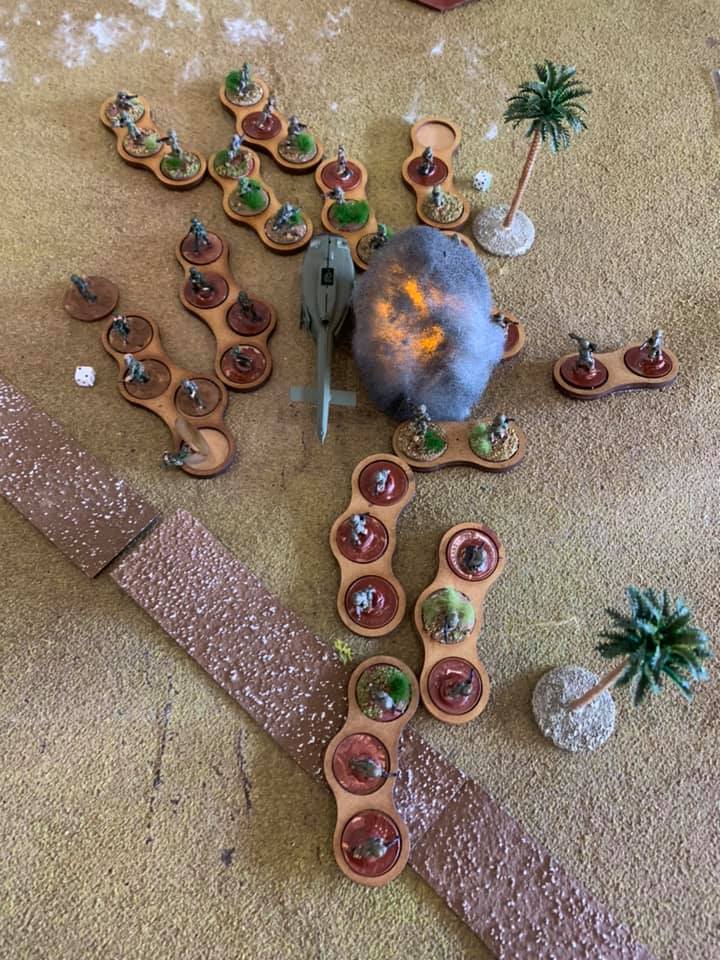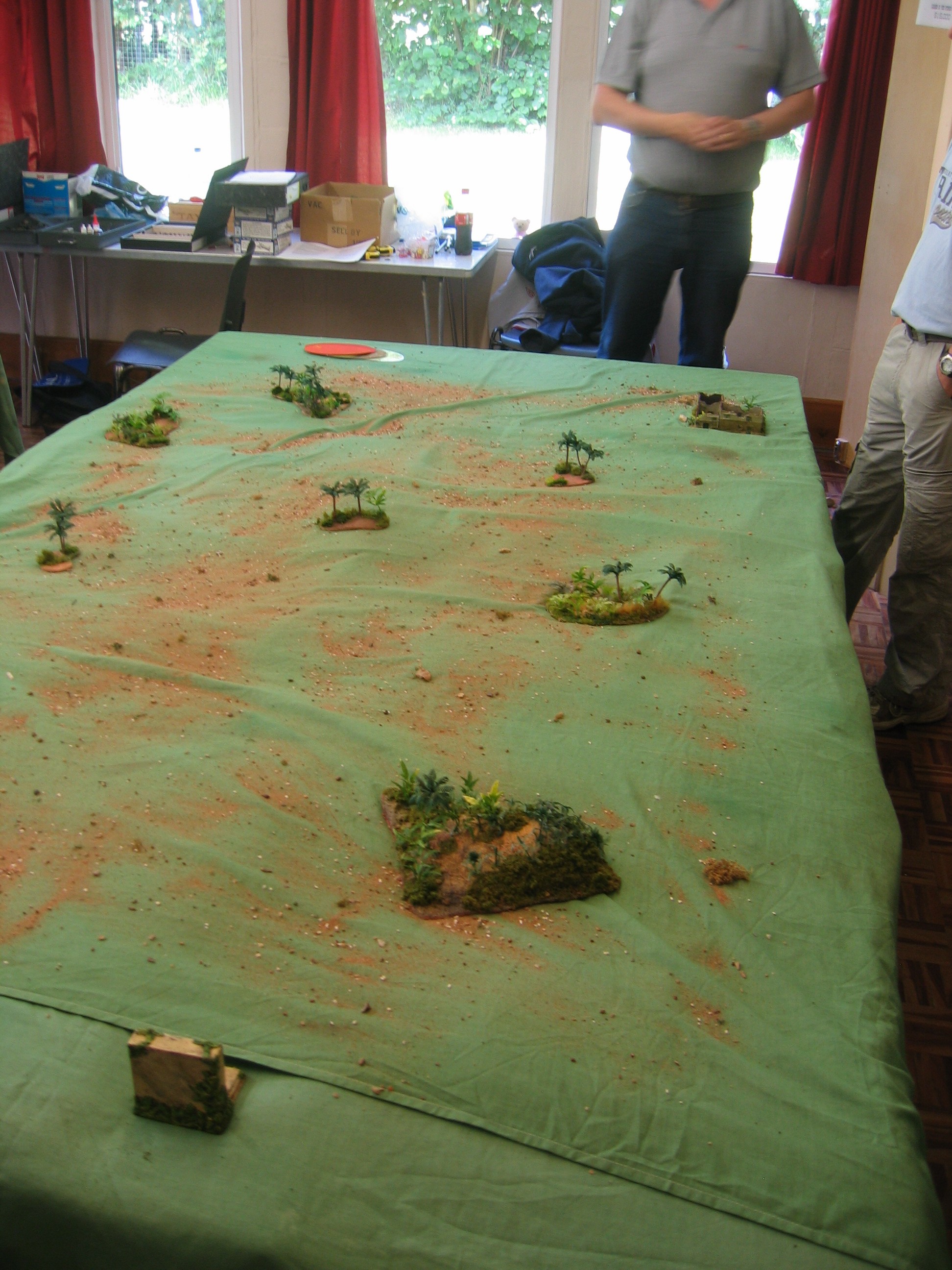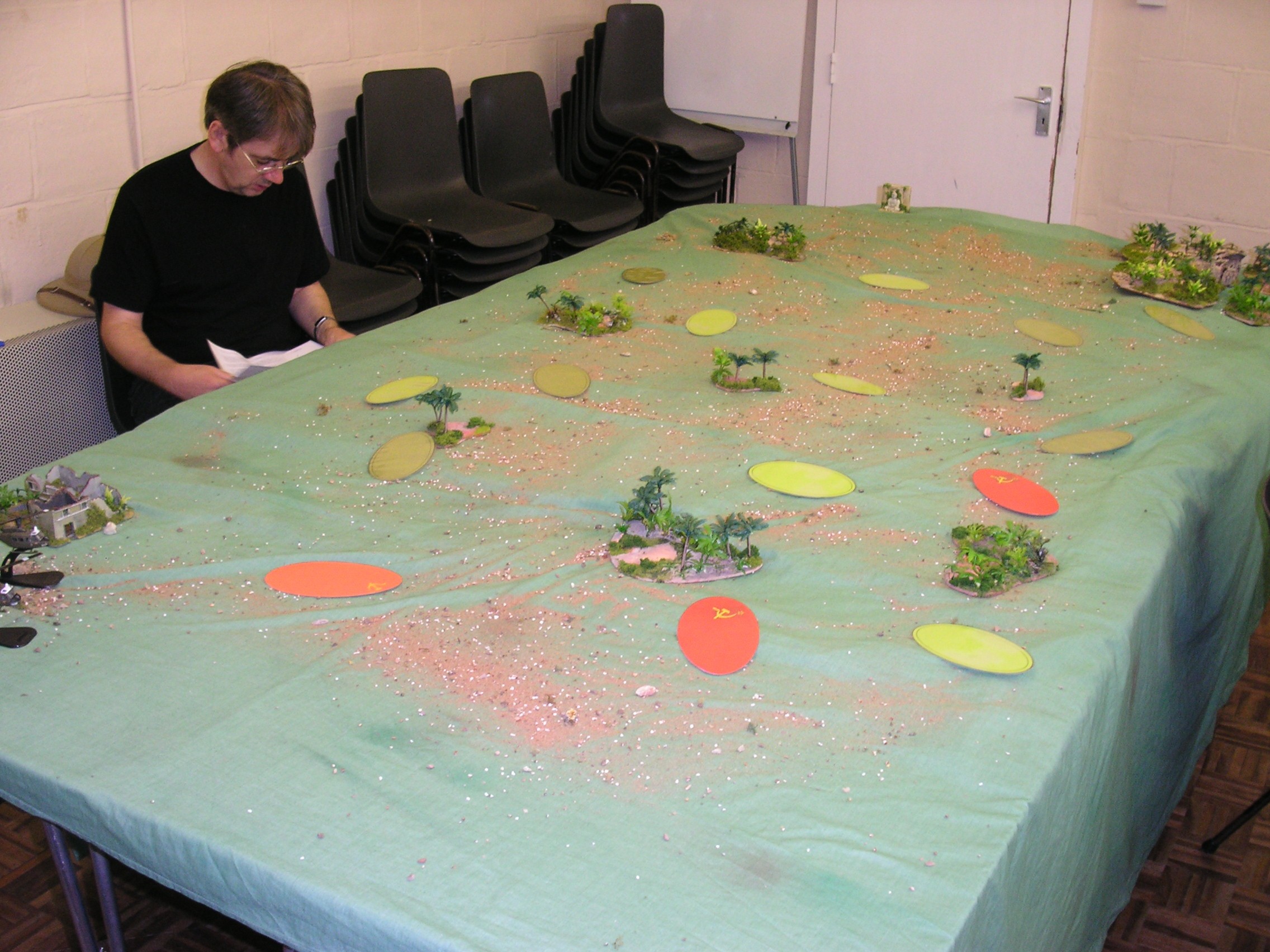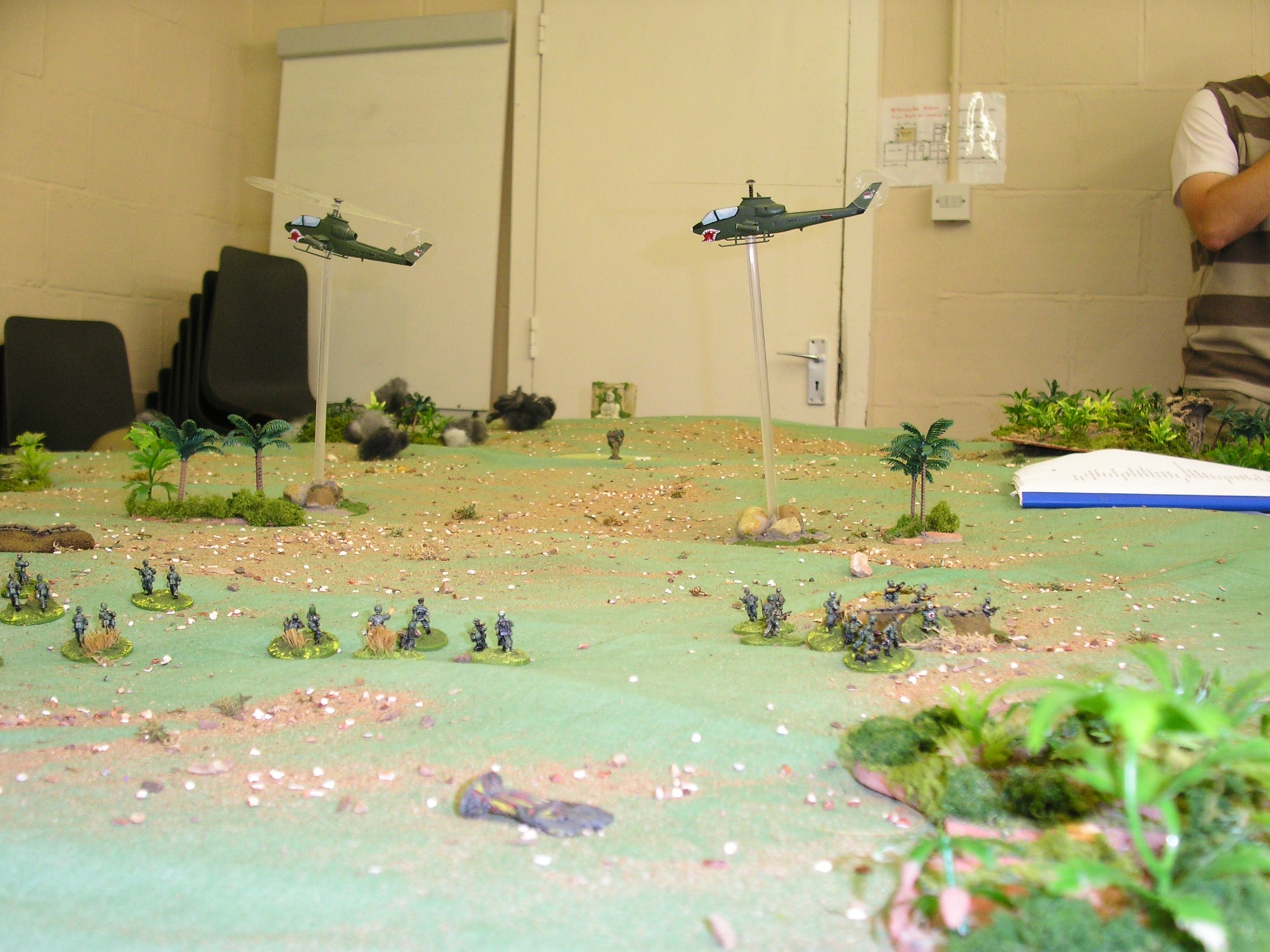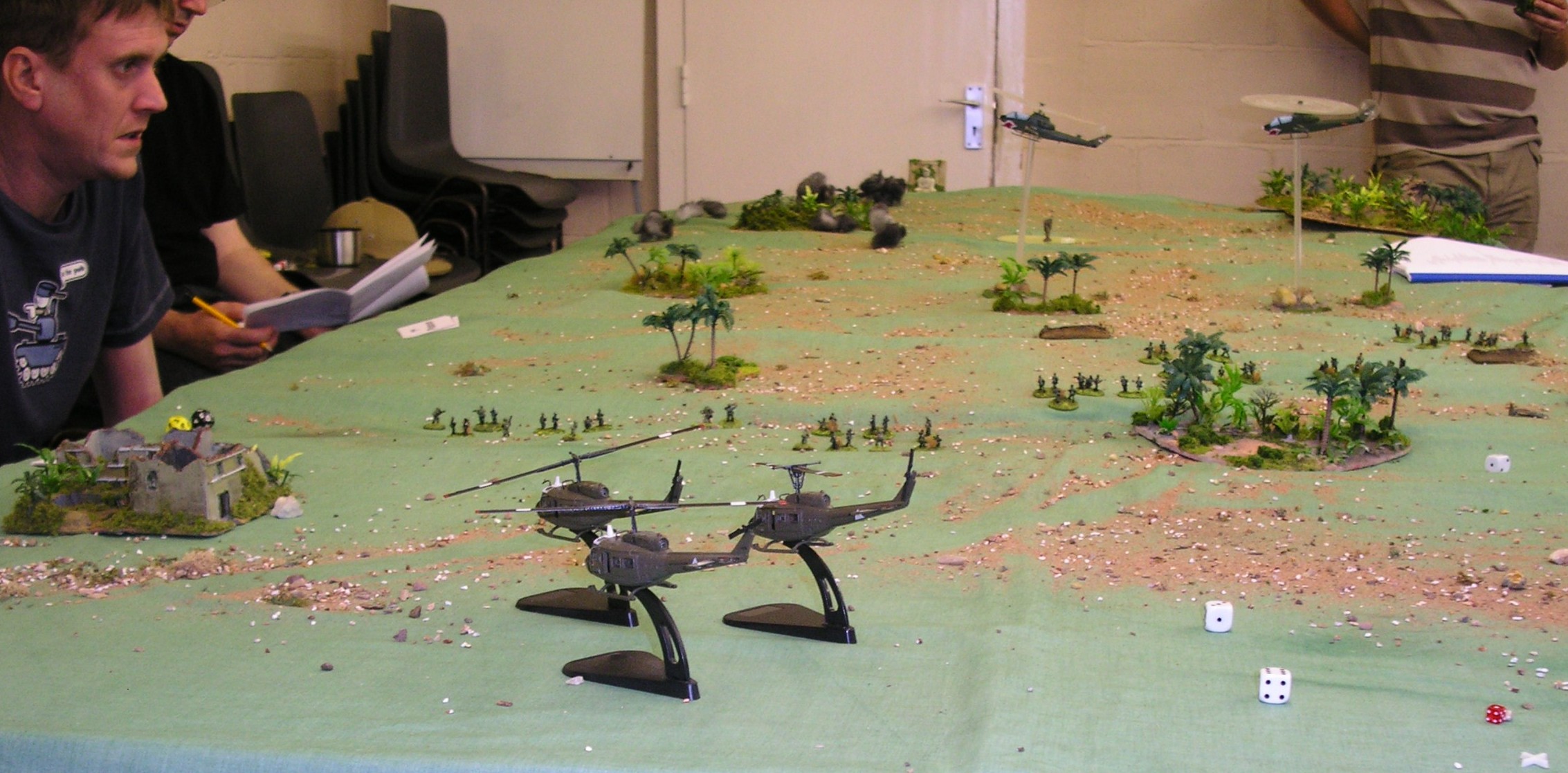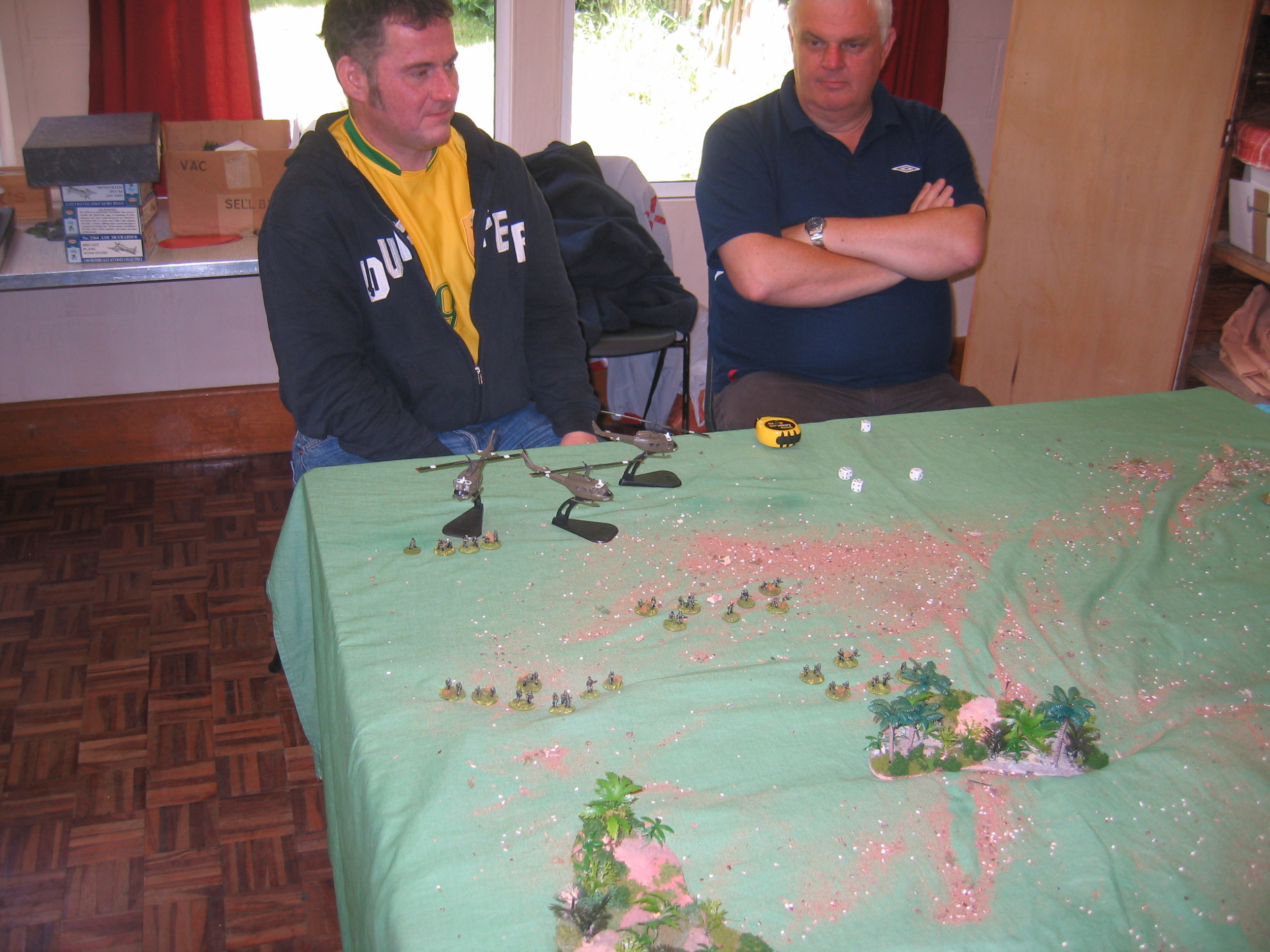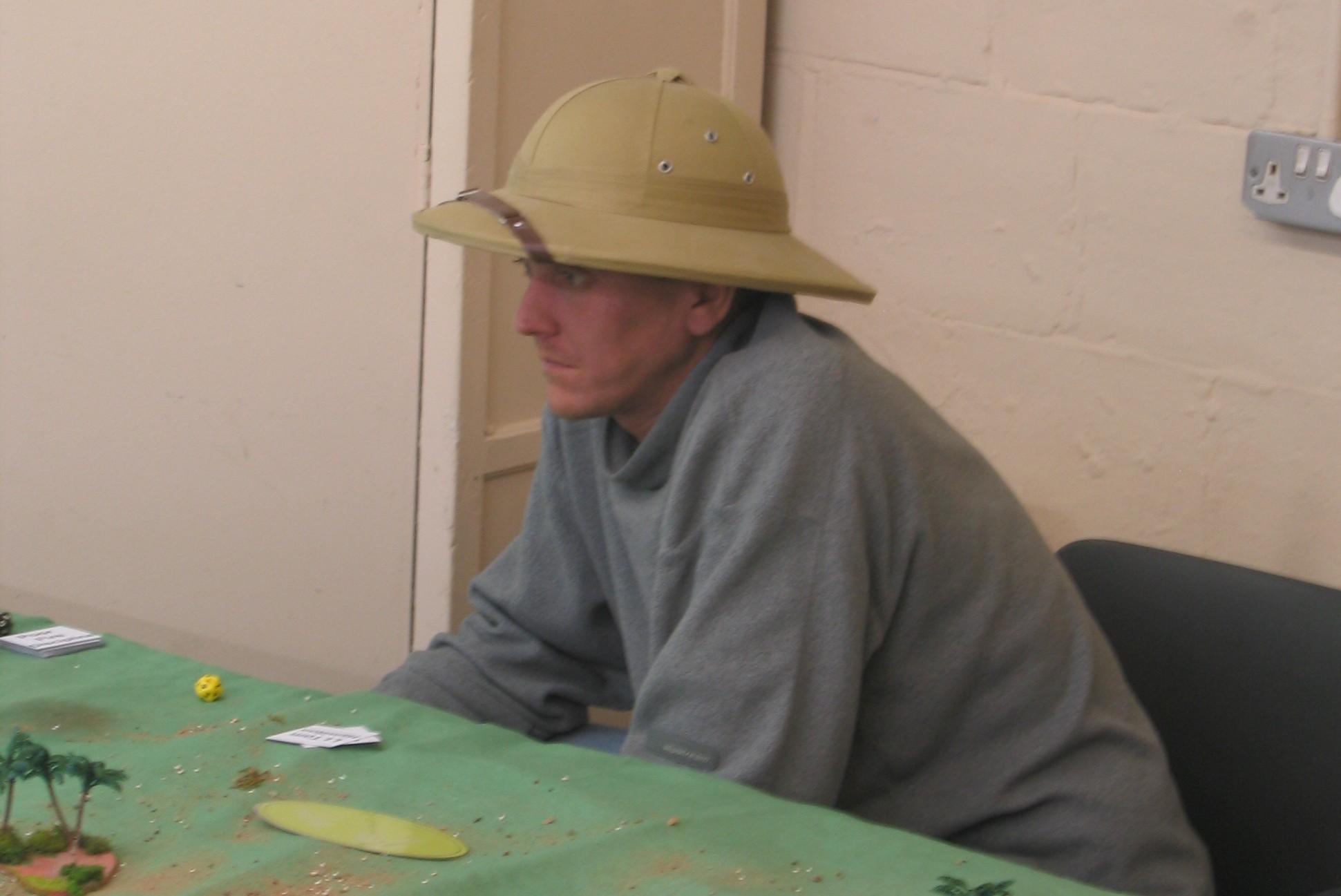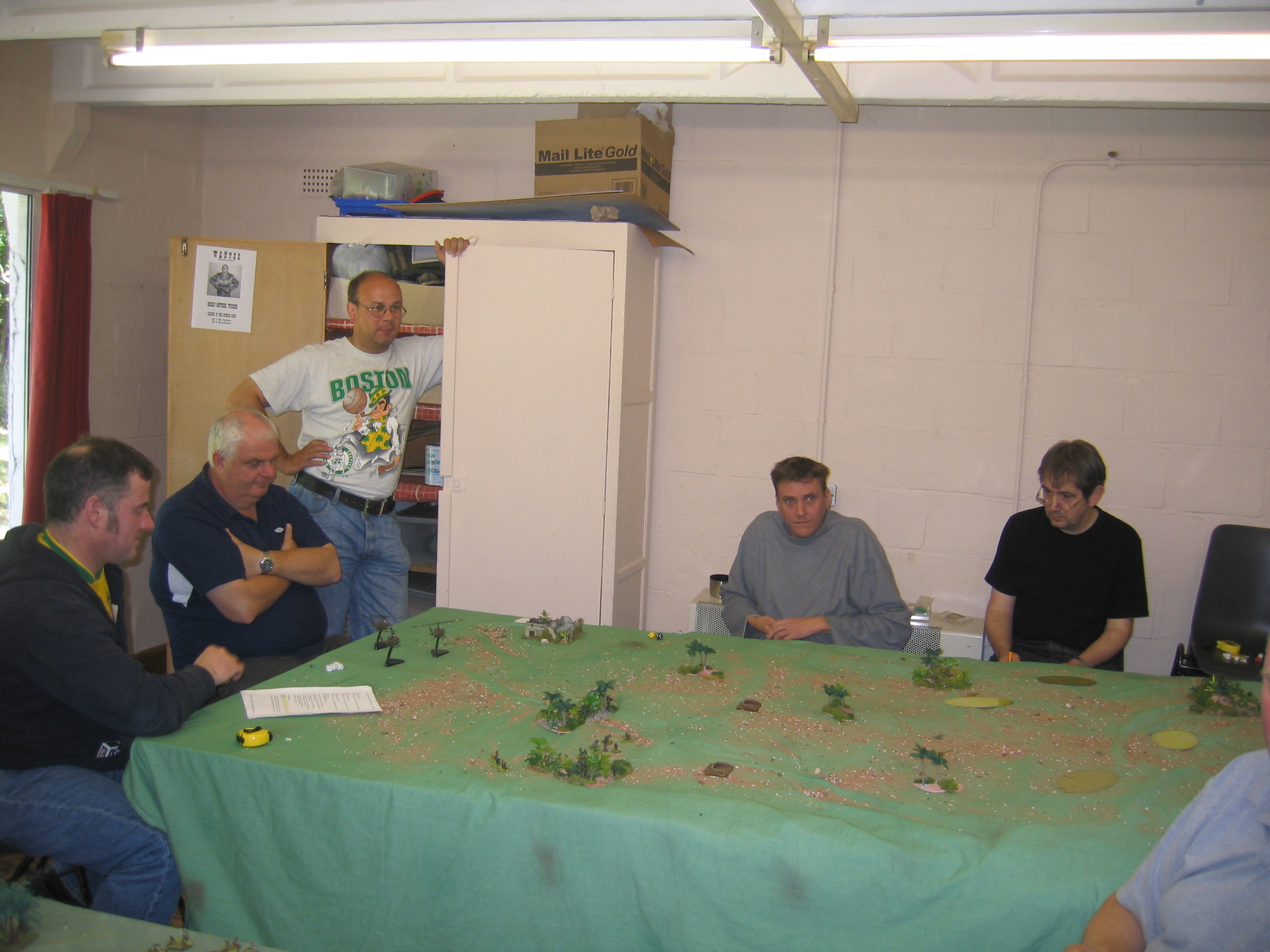Great game tonight - played through Scenario 5 from Surfs Up in full (last week we had a couple of trial turns).
ANZACS sent one platoon via the jungle side of the table and 2 platoons plus Company HQ toward the rubber plantation on the opposite flank. The VC security bravely raised the alarm before retreating very rapidly (Awe effect!) off the table.
The NVA then intercepted with a platoon on each flank. All went well on the jungle flank as dug in AA HMGs and light mortars supported the platoon and the ANZACs were forced back with casualties mounting.
Things were going reasonably well in the rubber plantation with the ANZACs aging forced back caring numerous dead. Unfortunately the Aussie Hog gunship support then arrived and caused bloody havoc. The ANZAC superior command played heavily as they recovered and pressed forward.
Where was the NVA third platoon I hear you ask - lost in the damn tunnel leading from the jungle to the middle of the village! They are probably still wandering……
So , just as the NVA were getting the upper hand on the jungle flank the artillery support arrived covering the jungle tree line where the mortars and AA HMGs were entrenched. Bang goes the NVA fire support.
A clear military victory for the ANZACs with two thirds of the NVA MIA or heavily shocked (beyond the point of Awe) and the VC having legged it,
However, a political victory for the forces of Communism due to the high number of ANZC dead and several dead villagers - killed in the attempt to clear the paddy fields of VC!
Great fun!
Nick Bellamy
A few photos from our first game - scenario 5 from Surfs Up. ANZACS advanced through the village and routed the local VC platoon - ending up charging one VC section in the rear as if retreated due to Awe. On the other flank Main Force came to grips with the ANZACs in the dense jungle.
Before the Game
The Game
Nick Bellamy
Egypt, noble are your children.
Loyal, and guardians of the reins.
Be we at war or peace
We will sacrifice ourselves for you, my homeland.
Bilādī, laki ḥubbī wa fuʾādī (Egyptian National Anthem)
Having played a couple of October War games using Seven Day To The Rhine I came across a blog where Robert Avery had been using Too Fat Lardies’ Vietnam rules, Charlie Don't Surf (CDS), for Arab-Israeli games.
This might seem a bit of a leap but CDS has its heritage in I Ain't Been Shot Mum (IABSM), the Lardies' company level WW2 rules, so I suggested to Andy we might want to see how it played as a large scale tank game which, given Andy's familiarity with IABSM and lack off with CDS (which he bought a couple of days before we played) led to us playing a fun hybrid we called Don't Surf Down The Suez, Mum (I'm sure such a catchy title will prove popular!)
Despite being on the receiving end of such a resounding defeat I actually enjoyed that. Cohen Don't Surf Down The Suez, Mum... gave a good recreation of the tank battles of the October War with the IDF tanks destroying a lot of Egyptian armour when not worrying about Saggers and Commando RPG teams.
The card system with the limited number of Big Men for the Egyptians certainly worked well. My only bone of contention was the stats from the 'briefings' on the Vis Lardica blog we used. The only difference between a T-55's stats and the next generation T-62 is one point - on its Strike (firing) roll, and the Sho't armour stat is 16 compared to the T-62's 10 which seems somewhat disproportionate (you wondered why they blew up so easily?) - oddly a Magach 3 (M48A3) armour is only 12 so I wonder if the Sho't's was typo. The Centurion was a good tank but not that good in 1973!
Steve Blease
Ed.’s Note: The Sho't/Centurian armour value is taken straight from CDS itself, but you're right on the T-62: armour value should be 13. R
"Bad luck? Our mistake was to play like regulars..."
Sooo...to Vietnam, the border with Laos and "Playing The Beanball", scenario six from Surf's Up, Too Fat Lardies' scenario collection for Charlie Don't Surf.
The Free World mission? Evacuate the village, then deny Communists the future use of the hooches. The Communist mission? Ensure that at least some of the Hooches remain standing when the Free World depart, preferably after launching three successful ambushes.
It was going so well for the VC. The RVN police platoon had deployed in the depths of jungle and exhibited a great deal of hesistancy in leaving the cover it afforded. Not one but two US platoons had been distracted and drawn by a pair of retiring VC squads to the south-east, away from the village that was to be evacuated and destroyed. The remaining US platoon was unwittingly advancing towards to what would hopefully be a second successful VC ambush.
It then went all Du Long* for the VC, in a fit of uncharacteristic hubris...let's rewind and look at events from the Free World's point of view.
As stated previously, on their very first turn of the Free World Blind chip, the RVN police platoon chose to come off their blind and attempt to advance upon the village from the east, but they made exceptionally slow progress. The controlling player (Jerry) rapidly realised the benefits on remaining on blinds, but sadly in the manner of one who shuts a stabledoor after the horse has bolted. To compound matters, the RVN police found themselves to be hesistant in the extreme, and so played no part in the ensuing events!
A pair of Free World Blinds confidently advanced towards the village from the east, but along a clearer part of the jungle to the south of their RVN allies. Unfortunately, they got no further than 150 yards before they were revealed as US 1st and 2nd Platoons (controlled by relatively veteran CDS player Mr. Bowman). The VC CO deemed the time right to launch the first of his ambushes, and US 2nd Platoon began to take shock. The Free World were clearly riled by this, and both the platoons' COs ordered them to divert from their route in order to plunge into the jungle and seek revenge. To add insult to injury, the VC CO deemed the time right to bring a sniper into play, to harrass the blundering US platoons.
Quite rightly, the time came for the VC CO to begin the orderly withdrawal of his sole platoon to be revealed thus far. Fire was exchanged as each side advanced and withdrew by turns. Soon, two VC squads had made it to the outskirts of some hooches set apart from the main village, with one remaining squad just breaking free of the tree line. Two US platoons had been successfully diverted from the focus of their mission, and (despite efforts of COs) were struggling with shock amidst the dark jungle. Clearly, the VC were poised to continue their withdrawal, in order to launch another ambush....
In the meantime, US 3rd Platoon actually stuck to the plan (they were also controlled by Jerry, and providing him with a good deal more entertainment than the RVN Police). Encouraged by their CO and NCO, they rapidly made their way across towards the village, and began the process of gathering the various groups of villagers in preparation for their evacuation. At the same time, slicks were called in by the Company CO. Unfortunately, it was at this point that a VC MG opened up upon them from a concealed bunker.
Two successful VC ambushesAll their forces still concealed bare one MG-filled bunker and one platoon. What could go wrong for the VC now?
The title quote for this post is a clue. The VC platoon which had so successfully distracted two US platoons took us all by surprise by going on the offensive, and trying to meet the US in pitched battle. Suffice to say, this did not end well for said VC platoon. The brace of VC players were also rattled by being on the end of a highly-successful bunker-bustin' shot from US 3rd Platoon over in the village.
Their morale appeared to snap with the prompt arrival of the slicks. With AA fire found to be ineffective, another VC platoon revealed itself to the west of the paddy fields skirting the village, and it attempted to close with the squad from US 3rd Platoon. Unfortunately, the chips did not fall (literally) in favour of the VC.
To be precise, the slicks left - albeit with only half the villagers - only to be followed with frightening speed by a Hog, which unleashed firey doom upon the VC platoon that found itself out in open paddy field. Unleashing its entire payload in short order, the Hog zipped off as fast as it arrived; the US players were clearly satisfied by the havoc it had wreaked.
By now, the VC resolve had crumbled, and they began to withdraw. Remaining VC aggression took the form of their sniper having a couple more potshots before withdrawing, and US 1st Platoon finally contacted one of the VC minefields, but came through unscathed. It was time to consider victory, military and political...
Aftermath
In the end, military victory was deemed by all to have gone to the VC. Whilst terribly blooded, they had- by close of play- undertaken all their ambushes, and most of the village was still intact, perfect for a base of future operations. By contrast, the US had only evacuated half of the villagers, and only two hooches had been fired.
Politically, the US had this in the bag. They successfully policed the battlefield for various intelligence markers and managed to turn a number of estimated kills into confirmed kills. By comparison, for all the Shock successfully inflicted, the VC had very few kills.
Lessons learned? Well, to paraphrase the players...
Jerry: "Stay on blinds for as long as possible for cohesion; make sure Free World Big Men are where they can coordinate as many of their men as possible!"
Mr. Bowman: "Stick to the Free World mission, man! Don't be afraid to pour on the direct fire support when civvies aren't about"
Smallridge & Sharman: "VC are not Regulars; VC are not Regulars; VC are not Regulars**..."
*Not sure this is the correct spelling, but it does scan for the purposes of Mockney rhyming.
**Repeat as required.
Penfold
The build up of US forces in the spring of '65 was followed by a summer of increasingly aggressive missions.
Captain Miller Tyme (a level III Big Man) was ordered to take his company to the village of Go Long on the Smelly Fish River, evacuate the civvies, seize anything of interest and destroy the village, known to be strongly communist.
Commander Van Go (IV) is a Viet Minh vet. He has been warned that US forces will be visiting Go Long and Commissar Tru Wok (II) insists that a welcome be arranged as the village is a major rest and supply location.
The VC stronghold has three bunkers and six mined strips. The village is on the river and receives supply by sampan. There are rice paddies along the river north and south of the village. The approach to the village is through light terrain with heavy terrain dotted about.
Comrade Van Go obediently planned a double layer of defence with his three guerrilla platoons well forward of his bunker and mine defences.
Lieutenant Johnny Walkers' (IV) 1st Platoon advanced on the right with Lieutenant Jim Beams' (II) 2nd Platoon on the left. Captain Tyme and the FO were with Lieutenant Bud Wizers' (II) 3rd Platoon in the centre rear. Walkers' 1st Platoon immediately got into trouble, being ambushed by Tran Van Cas' 2nd VC Platoon with serious losses including one critical requiring immediate Cas-Evac.
Meanwhile Lieutenant Beam spotted Chucks in heavy going and drove Nguyen Van Trocs' 3rd Platoon back with losses. Hearing the dustoff call he turned his 2nd Platoon to the right and took the VC 2nd Platoon under fire, killing Tran Van Ca.
By Turn 5, the VC 2nd Platoon has been hit hard, and Walkers' 1st Platoon got its revenge in a close assault that sent the VC 2nd Platoon survivors running. The VC 3rd Platoon was hit by artillery called in by the FO, with the fire killing Van Troc. Two of the three VC platoon commanders are now down, the two most effective.
Beams' 2nd Platoon returns its attention to the VC 3rd Platoon survivors while Walker cleans up the ambush site and Lieutenant Wizer takes 3rd Platoon to clear the woods in the centre. But Wizer is killed by fire from Vo Tranhs' (I) 1st VC Platoon. Sergeant Sandy Mann (II) gathers a 6-man squad from 1st Platoon and advances on Van Tranhs' position but is hit by accurate sniper fire and is driven back with loss. The rest of 1st Platoon drives Van Tranhs' men off with losses, only two squads escaping.
A lull occurs at this point while both sides reorganize. The US forces have met with heavier resistance than expected, is just less than half way to the village, and has not yet encountered the bunkers and mines. The VC are also badly hurt: Van Go is only able to organize one strong platoon. Comrade Tru Wok orders the civvies to load supplies into the sampans. Captain Tyme now personally commands 3rd Platoon and requests reinforcements due to the damage taken by 1st Platoon.
While waiting for assistance Lieutenant Beam spots one of the bunkers and gets artillery on it. Fire is again rapid and accurate, and the bunker and an HMG are history. But the two US reaction platoons are slow to arrive and "Eagle Eye" Beam and his men fail to spot Comrade Van Go leading the composite VC platoon around to their rear. The VC locate the US 2nd Platoon and launch an assault into their rear, driving the US platoon sixty yards towards US 3rd Platoon. Eight US bodies are left behind. But even as the VC try to follow up their success, Lieutenant Jim Yellow Sky and a reaction platoon arrive on their flank. Comrade Van Go cuts his losses and leads the survivors off the VC tactical edge.
By the time that the now five US platoons pass the now abandoned bunkers and into the village, Comrade Tru Wok has gotten the supplies loaded and escaped by sampan.
Policing up acquires some forgotten documents and a well informed prisoner, but another man from 3rd Platoon is lost to a booby trap. The VC have a third of their survivors dispersed. The final tally gives the US the military victory, but the VC gain a minor political victory mainly due to the ambush of 1st Platoon and the rear attack on 2nd Platoon.
The game was challenging, a good time was had by all and we consumed a good deal of booze with the AAR that followed.
Charles Eckhart
Commander Ly Chi looked down from the veranda of the Pagoda towards the river. Several members of the local community were working to get the river water through to the new rice beds that would soon be feeding his men. Chi was commanding the advanced guard of the 37th Main Force battalion of the Viet Cong. The main body of the force was still in Cambodia waiting for news that their accommodation was ready, and that would be very soon. Already the arms cache in the village was being moved into the freshly dug tunnels. It would not be long before Ly Chi and his comrades would be able to take on the imperialists and free the South to enjoy the benign rule of the Communist Party. Nothing could go wrong.
Even from many thousands feet the jungle clearance and the excavation of new paddy fields was clear to Major Milton Clamburger in his OV-10 Bronco, the freshly dug red soil a visible scar on the landscape, and fresh paddies could only mean one thing, more mouths to feed. VC mouths.
Captain Butch Taylor moved along the sweep line, words of encouragement came easily and his men responded well. Butch was a soldier’s soldier, and Charlie Company appreciated that, and yet a sweep through an area know to be occupied by the VC was always a mission fraught with danger. Men smoked, swapped jokes and laughed, and yet the tension could be read on their faces. Then the word came.
“Let’s move out”
Lieutenant Hung Lo looked down from the Huey, his eyes scanning the ground in an attempt to read the terrain. There were several LZ near the Pagoda, all of them potentially killing zones, choosing the right one and getting his men on the ground would be critical to the success of the operation. If Charlie was allowed to just melt away then the press would have a field day. Again.
In the Hog Lieutenant Walter Greenbaum made his approach, flying in a shallow dice through the fire that was coming up from the treeline. He watched the rockets as they flew straight and true and exploded with a shattering impact among the shadowy figures in black pyjamas.
Lieutenant Carter Beauford jammed another magazine into his M16 and fired again. He could see very little, but the firepower produced by his platoon must mean that he was winning the firefight, and that is just what they’d told him to do in OCS.
To the right of Beauford’s platoon Lieutenant Randy Buckmeir had already won his firefight. Well, he presumed he had as Charlie was no longer firing at him. He had brought his men forward to the edge of the clearing, but with the firing continuing to his left he was loathe to cross the open space. God, this war is Hell.
Movement down to the right. The pilot was signalling to Sergeant Gi as the Huey descended. This was the moment of truth. They were landing very close to the fringe of the jungle, ripe for ambush, but there was no choice in this small clearing where only one slick could drop its men at a time. The first squad of ARVN Rangers leap down as the chopper hovered eighteen inches above the ground, the door gunner liberally spraying the edge of the jungle. In seconds they were gone, the squad forming up and deploying their weapons as the Huey lifted off. Almost immediately fire came from the far side of the clearing. The pilot had been right; VC. Gi tapped the M60 gunner on the shoulder and pointed towards the muzzle flashes, and a stream of bullets stitched their way across the clearing even as the next Chopper approached.
“Burn the Goddam place” Lieutenant Brad Whitford looked at the pile of AK47s and ammunition that had been found below the floor of the hooch. In the previous building they had found stocks of rice that were suspicious, but could have been the store for the hamlet, now there was no doubt. Sergeant Leroy Burlesque flicked his Zippo and enjoyed the momentary aroma of fuel. They light every time.
“Move you mothers!” Captain Butch Taylor had never been know for his patience and he was convinced that a charge with the bayonet would overwhelm Charlie. It was a matter of a dozen yards, but in this terrain it was slow going. Three men were killed as they crossed the intervening ground, and when they got there Charlie had gone. Mind you, he was clearly beaten as he had abandoned the bodies of three of his dead. Taylor grabbed the radio. Nothing. He swore. Little did he know that the bullet that had destroyed his PRC 25 would otherwise have killed him.
“Holy mother, the artillery”. He ran across to Lieutenant Buckmeir, with the first ranging shot coming in from Firebase Hillary he needed comms!
Lieutenant Hung Lo was forming his sweep line now. The clock was ticking. If he could move across behind the pagoda he could cut the line of retreat. From the radio traffic he knew that Charlie was starting to move out, and he was sure there was movement to his front, he did not want to walk into an ambush.
Pac Choi emerged from the tunnel. Yes, they were behind the Americans. His men spread out silently as Choi watched his enemy preparing to move on. The volley was violent and brief, the effect of the AK-47 fire more shocking than anything else, and the American troops dived for cover. Pac Choi and his men ran. They had done all they could, they had been betrayed by traitors, lap dogs of the American Imperialists. They would pay with their lives! Now his objective must be to keep his force intact and reach Cambodia.
Up to this point the US and ARVN forces had killed six VC and lost five men dead. They had discovered weapons and food in the hamlet and most importantly the tunnel complex. The discovery of the latter was solely due to Pac Choi’s emergence and parting ambush before he ran for the border. Had he simply slipped away it is likely that the Free World forces would have missed the tunnels. A further dozen VC were cut off from their exit route, six being captured by the ARVN Rangers. So the operation was a military success for the Free World Forces, but verging on a political victory for the VC due to the losses they inflicted. Had Butch Taylor relied on his firepower rather than going in with the bayonet he’d have saved the lives of three men and won a complete victory.
The game was designed to test some of the victory conditions in the rules which, as suggested above, are two-fold; military and political. One of the things that has taken the time with developing Charlie Don’t Surf is getting the game to tick two key boxes that are interlinked. It must represent the reality of the war in Vietnam without being a parody, and it must give both sides a real challenge and an opportunity to get a victory on a very uneven playing field. It would be easy, far too easy to produce a game that is a parody of this complex conflict, and even easier if that parody was that seemingly appealing winner – the war as it “should” have been rather than the war as it was.
What do I mean by this? Well, one of the frustrations of any counter-insurgency campaign is that one side generally won’t play fair. The Free World forces in Vietnam were, above all else, seeking to bring the enemy to battle and defeat him. Had Charlie played ball and done the decent thing, standing up and fighting, then he would have been in big trouble. So quite naturally he stuck to his own game plan.
This can be a real issue for wargamers and in particular game designers. We could make the assumption that in our games Charlie is particularly rough, tough and nasty and ready to play the stand-up fight game, and then the Free World forces could deploy all of their very sexy assets to gun him down wit style and aplomb. Easy rules to write, easy game to play, probably very popular, but frankly a complete load of hog wash. Nothing more than a Vietnam version of ‘Whack a Mole’, with Charlie popping up from his tunnels and Rambo blasting him to the Stone Age.
The real challenge in designing Charlie Don’t Surf has been to develop a game where both sides can fight their own war; where both have strengths and both have weaknesses and both need to attempt to dominate the battlefield by developing their plans to take these into account. The net result this far is a game where the double whammy of a military and political victory is hard to achieve, where there is frustration on the ground as the enemy won’t do what you want him to do, but where by playing to your own strengths, by clear thinking and careful planning either side can dominate the battlefield if his opponent allows him to.
Critique
This was a “nearly but not quite” operation for the US forces. They lost too many men, largely due to the lunatic charge when firepower would have done the job better. They were too late bringing in the ARVN platoon; in essence the hammer was striking before the anvil was in place and that allowed many VC to leave the table unchallenged. Part of this was the limited size of the LZ stopping a fast deployment. All the more reason for putting the ARVN in early.
For the VC a failure to concentrate their forces meant that they never really hit hard in any one place. They did, however, take full advantage of their ability to sneak off and set up another ambush. Bizarre they left two HMGs they had in the tunnels, the extra firepower could have really hurt the US forces. What has been interesting over the months of playtests has been watching the players learn to use the correct tactics. The US forces are aware now that avoiding ambushes is almost impossible, so you move tactically to limit their effects when they are sprung. You also make sure that the supporting troops are close enough to add their firepower when it is needed.
The VC players are really learning to hit hard and then slip away. They now know that in the confusion after the ambush the US player’s knee jerk reaction is to form a base of fire and get himself organised, providing the VC with valuable moments to simply disappear. Our game saw a full company of US forces (the weapons platoon was off-table with its mortars) plus an airmobile platoon of ARVN Rangers and a Huey Hog gunship in support faced with just two platoons of Main Force VC imbalanced game if we were to use any points system, and yet the VC came very close to winning a political victory, and could easily have avoided handing the US a complete military victory if they had not given away the position of their tunnel entrance in the final moments. What was more both sides really enjoyed the game.
Great game for me as umpire. My enthusiasm for these rules is almost boundless at present and I get a real sense of satisfaction as we finally declare the rules watertight and now move on to work on the final presentation and wording. After eight long years it seems that Charlie will, at last, surf. Projected release date is May.
Richard Clarke
October 12th is a national holiday in Spain and what best to celebrate than playing another game in Vietnam. As usual, we used Charlie Don`t Surf from the TooFatLardies factory and its companion scenarios book Surf's Up.
The scenario chosen was "Combat Engineer" and involved an engineer squad supplied with mine detectors with the mission to clear a major road traversing the table west to east. The squad was escorted by two light US infantry platoons (only the rifle sections but not the weapon support section) under command of a relatively newly arrived in-country Captain ("hesitant commander" class).
A routine mission in principle, unknown to the US there was a major VC force lurking in the area, travelling to a major concentration of troops for a surprise offensive on the Free World Forces camped nearby. Their orders were to cross the table in a north-east to south-west direction and whether possible, to mine the metallic road.
The US forces deployed first and out of blinds, entering the table through the west edge, one platoon covering each side of the road and the engineer squad clearing mines on the road itself.
Note: for game purposes we considered the engineers were successful clearing a 6 x 6 inches area by achieving 4 or more on a d6 roll; engineers were activated on their card, had 3 action dice and could act as a rifle squad if the situation got too hot.
US Forces: Initial Deployment
The VC player had two infantry platoons and a sapper squad. They deployed in blinds and had two dummy blinds in addition that could be placed anywhere up to 36" on the entry point.
The following chart show the situation at the start of the game:
The red markers at the north-east corner of the map above were the main VC force. The two blinds on the road were dummy blinds (ie., scouting or patrolling units).
Although the scenario did not include any, I decided to introduce a peaceful group of civilians entering the road through the east, probably coming back from the local village market day and leisurely returning home (a hooch located at the west edge of the table).
They moved randomly throughout the game (3d6 + deviation dice) and were activated on the blank card. Initially, they deployed in a blind, creating much confusion (to my amusement) to both players as belonging to neither, they showed to be really concerned about what was going on there. Once both players spotted the blind, the civilian deployed.
This poor group of peasents unexpectedly crossed from time to time the line of fire of the combat units. As the rules state that negative victory points are awarded to players who cause civilian casualties, they had to decide whether to risk or not shooting the enemy when civilians moved nearby.
Returning now to the action, as in many other games the players today seem to forget their orders (and the victory conditions) and instead both hurried to go into direct confrontation. Bad tactics for the Americans, as in this game they were in net disadvantage in terms of fire power (no LMGs) and commanded by relatively weak leaders.
The VC player, making good use of the Di Di Mau card, hide one platoon in the jungle, in the pathway of the American unit moving at the north of the road. The Americans advanced (carefully) towards the other visible platoon (still in a blind) only to be ambushed in short time by the hidden enemy.
Ambush!
One US squad was hors de combat almost immediately and a second severely mauled. But the VC player sensing the scent of blood, decided to bring the second platoon into the fray instead of taking advantage of the situation to move their forces quickly and unmolested towards the exit point (south-west edge of the table).
The VC did not realize that they were losing precious time engaged in a nonsensical fire-fight while the US engineer squad kept moving relentlessly along the road, clearing any potential mines.
Even more astonishing (to me), the VC sent BACK its sapper squad to the eastern edge of the road (opposite to its exit point) to plant a few mines there; not only they were happily giving away their chances of winning the game, but this was basically a useless action as the US engineer would be cleaning that part of the road in a few turns!!
After some initial hesitation, and facing overwhelming odds, the US players seemed to come to their senses. First, the Company commander took control of the platoon in the north side of the road, helping to reduce the level of shock and pulling back from the fire in good order, forming a defensive perimeter along the road bank and protecting the flank of the engineers on the road.
Second, the US platoon south of the road sent a squad to reinforce their beleaguered comrades, while the two remaining sections and the commanding Lt advanced to chase the VC sappers, which they do in short time.
The VC player also seemed to recover some sense and came to realize that the mission was NOT engaging the Free World Forces in combat, but to join their main parent force to take part in the future major offensive. Both VC platoons also disengaged from combat, bypassed the Americans and moved as fast as possible towards the exit point.
A VC squad broken by a fierce attack of the US reinforcement section had to remain in the area, after accumulating so much shock that it could not move of fire with some significant effect. I mention it because, should it had routed and left the table through the north edge, or being caught prisoners, it would have broken the final tie result of the game in favour of the Americans.
The final few turns saw both players rushing to comply with the victory conditions: the US forces clearing the road from mines and the VC leaving the table by the south-western edge.
VCs Heading South
It was now time to bring the game to an end and declare a draw. The gross of the VC forces were already reaching the exit point and the Americans had almost finished the road clearing work. In terms of casualties both also presented a tie, the initial advantage of the VCs after the ambush lost when their sapper unit fell to the deadly American M16 fire. And the section stranded in the north, were put under command of a VC big man who managed to maintain the shock level under control, avoiding a the rout of this small force.
A surprisingly simple but really interesting scenario. Both player teams really enjoyed the game and ranked it high in the list of games player so far with CDS. I see some potential to be used as a basic skeleton to develop more complex scenarios, involving airmobile insertions or adding some traps or ambushes to force the US side to play more careful.
Benito
Well, this Sunday we did another play test of IABSM3 to introduce more of the rules like indirect fire, snipers, and night fighting. We did this play test at Wargamer’s Cave (link) again, but this time using my 20mm Falklands figures. The scenario was a fictional engagement of two platoons of UK Para’s with some support (a SFGPMG team, a Carl Gustav team, and a half battery of 105mm on call) vs. a weak platoon of Argentine Army Commandos with some support (a SFGPMG team, a section of 81mm mortars with a FOO, and a sniper). Steve H. was running the Para’s and Curtis T. was running the Commandos. Each Para figure was equal to two men and the Commando figures were 1 figure to 1 man. I didn’t get my Falkland’s Blinds done, so I was using Viet Cong blinds for the Commandos and the Para’s did not start under blinds. I also did not get my Art Cow cards yet either.
Argentine Commandos in defensive positions
The background of the scenario is that the Commandos were camped out at a farm, but expecting a push by the British, was able to deploy his platoon and support in about the center of the board. The Para’s were on a time schedule, so had to advance in a fairly straight line until an engagement broke out.
The Para Platoon making a flanking attack
I failed to take photographs until about half way through the game. So, what happen earlier in play test was the Commandos were very observant and spotted the Para’s right off at the get go, but the Para’s were have some problems spotting until their Big Men started using their flares. Thanks to the flares and the poor dice rolling by Curtis, the Commandos were losing men, but doing no damage to the Para’s.
Preparing to seize the hill crest
One of the Para platoons laid a base of fire as the other started to flank the Commandos. The Para’s never got their FOO in to a position to call in the 105’s, but the Commandos were able to eventually get their 81’s to fire for effect on one of the Para sections. The flanking Para platoon crested the hill next to the Commandos. With that, the Argentine commander orders the one section of Commandos still around to charge up the hill against two Para sections. It did not go well for the Commandos.
Moments before the Commando's charge
The Commando's charge
The result from the Commando's six dice, two Para's killed
The results of the Para's 20 dice, 12 Commandos killed
At the end of the game, fourteen Argentine Commandos were killed, mostly from the charge up the hill. Three Para’s were killed, with two from the Commando charge and one from the mortar attack. I think everyone enjoyed the game, but we still need to get more familiar with the new Big Man rules.
Sapper Joe
This is an attack-defence scenario based on a West German counter-attack after Soviet forces had been halted by NATO resistance. The Germans had a Panzergrenadier company in Marders supported by a platoon of Leopard 2s and the battalion 120mm mortars. They were faced by a motor rifle company minus its BTRs, but with a pair of 100mm anti-tank guns (yes they still had towed anti-tank guns in front line units) in support and the battalion Zampolit (commissar) on hand to remind the troops of the historic inevitability of their victory.
Result - a decisive West German victory. The Germans were able to focus their firepower on while the Soviet anti-tank assets were unable to affect the result, firing only briefly and with a lack of accuracy.
The new firing table with amended rules on pinning and suppression were effective and the new tank platoon orders worked. Overall a good test of the rules.
Nick Overland
For this game we left the usual setting of the mid-1980s and went back to the early 1970s. The scenario saw a hastily assembled US force of a mechanised platoon, an anti-tank section and an armored cavalry section on a mission to stop a breakthrough by a Soviet company of T62s with a motor rifle platoon in BMPs attached.
The table is below , from the Soviet entry edge. We were trying out a new Cigar Box Grasslands Mat with stuff under it to make areas of high ground in the bottom right, top right and top left of the picture, but they don't don't show up so well in the pictures which is lesson for next time. The trees show the extent of a dense wood and there are two field of crops.
The US deployed blinds. The bottom left and the 2 on the right are concealed from the Soviet side by high ground.
The Soviets sent a blind along the road to flush out any US in the village but failed to spot anything.
Two more blinds advanced uphill check out the wood.
The blind in the wood was found to be a dummy, as was the Soviet blind on the road. Another Soviet blind advanced through the centre to try another spot on the village.
Soviet spotting was poor but the central blind was revealed to be a platoon of T62s.
The 2 blinds moving uphill by the wood was also spotted and shown to be the infantry platoon dismounted with the BMPs behind in support.
Failure to spot the US blind in the cornfield led to an outbreak of impetuosity by the Soviet infantry who rushed forward on higher than expected movement dice followed by the BMPs on a Breakthrough card.
The US infantry platoon deployed off its blind and opened fire.
The first Soviet squad suffered badly and 2 of the BMPs were destroyed by M67s and M72s.
Another Soviet tank platoon moved through the cornfield on the Soviet left and was spotted by a US blind that deployed as the anti-tank section. It moved into a firing position of high ground and.....
.....made quick work of the T62s.
The US infantry's M113s had been deployed separately behind the ridge and cam of their blind to fire on the Soviet infantry, inflicting casualties including the last BMP.
The 3rd Soviet tank platoon advance over the hill past the wood and fired into the US infantry.
The M113s were spotted by a T62 who accounted for 2 with well-aimed shots from the halt.
With the threat to the US right dealt with, the anti-tank platoon moved to flank the Soviet tanks using the buildings to hide their movements.
The Soviet tanks poured HE into the US infantry's fox holes putting one section out of the battle as Soviet infantry also suffered.
The Sheridans of the armored cavalry section revealed their position to fire at the Soviet tanks. The range was too short for Shillelaghs so they had to fire shells which immediately broke their sights. Two T62s were hit and brewed up. However the Sheridans received return fire and some uncannily accurate shooting hit all 3.
An M113 mounting a recoilless rifle was destroyed by an overwatching T62.....
......that was then knocked out by the other anti-tank vehicle.
M67s accounted for 2 more T62s leaving the Soviets down to less than a platoon and the breakthrough was prevented.
A note on models - the US are all Battlefront, the T62s are by QRF, the BMPs are by Skytrex and the Soviet infantry are from Irregular.
Nick Overland
For the afternoon game I switched the table about a bit, reducing the built up area and adding a river complete with a bridge on one side. This is the view from the west.
I also changed the sides a lot. For this game the West Germans would be attacking with a Panzergrenadier company in Marders supported by a platoon of Leopard 2s with the aim of grabbing the bridge. The defending Soviet force consisted of 2 motor rifle platoons in BTR60PBs, the company support platoon and a weakened platoon of 2 T64Bs. The view from the east:
One German platoon advanced quickly towards the wood and ran into point-blank range fire from a Soviet platoon that destroyed all 3 Marders and inflicted heavy losses on the panzergrenadiers as they struggled out of the stricken IFVs.
The other motor rifle platoon was deployed in buildings to guard the Soviet right flank. Seeing the ambush of the panzergrenadier platoon, they rushed out of the town in a counter-attack. The Soviet army considered defence to be a temporary measure before the offensive was resumed; good to see players getting into the spirit of it!
The bulk of the German force was pushed towards the right, advancing behind a smokescreen.
The survivors of the ambushed panzergrenadier platoon were caught between the infantry firing from the wood and the counter-attacking motor platoon on their left. Casualties and shock put them out of the fight.
The motor rifles pressed forward.
As the contents of blinds were revealed, the two sides were found to have their tanks separated by a smokescreen.
The second T64 drove round the other side of the supermarket to support the counter-attacking motor rifles.
It didn't look much better for the first T64 from his side.
The motor rifles reached the wood bordering the road.......
.....and entered into a firefight with the second panzergrenadier platoon dismounted in the supermarket car park.
The Leopards picked out the T64 with their thermal imaging and knock it out.
The third panzergrenadier platoon pressed forward and reached the river.
These were better tactics than the first platoon used with Marders held back to provide fire support.
A couple of Milans were fired by Marders at the T64 but missed - the range was too short for effective guidance. The T64 responded by accounting for one of the Marders. A Leopard rounded the corner of the supermarket and ran into a 125mm fin-stabilised round.
The motor rifles pushed through the trees......
....and a major fight developed in the car park that eventually involved both motor rifle platoons, a panzergrenadier platoon and the Germany company HQ. It was carnage.
The Soviet support platoon opened fire with Spigot anti-tank missiles at the Leopards but failed to score a hit. One Leopard surged forward, over the bridge and into the minimum range of the Spigots.
This was a fantastic game to umpire. Unfortunately the pictures don't capture the mayhem around the supermarket, partly because I was enjoying it so much I forgot to take more. The Germans took the bridge as required, but it was at a high cost with just 2 tanks and 4 IFVs left.
Nick Overland
June 6 saw the long-awaited OML3 Lardy games day hosted by the able boys of The Wyvern Wargames Club from near Evesham, Worcestershire. It featured some fantastic-looking games covering WW2, the Russo-Japanese War, the War of the Roses, the Sudan 1885, the Napoleonic War, Athurian and recent Afghanistan.
I put on two games of I Ain’t Been Nuked, Mum. The morning game concerned a Soviet tank company (T64Bs) supported by a motor rifle platoon, a recce platoon and some artillery attempting a breakthrough against a West German force of a Panzergrenadier platoon in Marders, a Heimatzschutzkommando platoon, a pair of Jaguars and a weakened panzer platoon (Leopard1A4) supported by some mortars.
By the end the Soviets were close to a breakthrough but had little left with which to exploit it.
Nick Overland
Having spent the last few months building up my forces for the Six Day War, it was time to get the figures onto the wargaming table. For the first game, I decided to keep things relatively small and relatively vanilla: the Israelis would be attacking a UAR/Egyptian force defending a pumping station of some sort.
The Israelis, under my command, had at their disposal a couple of platoons of infantry; the company HQ with their support mortars and LMG teams; and two platoons of tanks: one consisting of two Sho’t (Centurions) and the other of a single Malach (M48). The Malach would be one of the few that had been upgraded with a 105mm gun. Each platoon would have a Big Man, with a Company Commander as well.
The defending UAR force, commanded by Dave, consisted of a single platoon of infantry; two recoilless rifles (RCLs); and two ancient Maxim machine guns (MMGs). All were dug-in either on the edge of the pumping station itself or along the spur road leading to it. As an ace in the hole, they also had a 100mm anti-tank gun positioned in its own gun pit. To emphasise the difference in quality between the Egyptian and Israeli force, the UAR side only had one Big Man available. Finally, after a random number of turns, a platoon of five ex-WW2 SU-100 tank destroyers would arrive as reinforcements.
The Battlefield
As for the terrain, imagine a decent quality highway running through the desert. As this highway veers to the right, a spur road leads off to a pumping station consisting of two huge tanks, two smaller tanks, and the pumping machinery itself. The station was decoration: neither side could deliberately shoot at it, it would not explode if hit (disappointing, I know!).
The station was surrounded by barbed wire, with a network of rather badly maintained trenches and bunkers dotted around its perimeter and along the spur road. The only decent bit of works was the gun pit for the newly arrived 100mm anti-tank gun.
As most of the terrain was rough desert, any unit could end its movement by dropping into as much cover as possible (i.e. making it one column more difficult to hit on the Fire Table) provided it used one of its Actions to do so.
The other side of the battlefield was bordered by a long nullah that was considered effectively impassable.
The Rules
The TooFatLardies (TFL) don’t produce a set of rules specifically for the Six Day War, so my choices were really to use their WW2 rules, I Ain’t Been Shot, Mum (IABSM), or their Vietnam rules, Charlie Don’t Surf (CDS).
You might think that CDS was the obvious choice, being exactly contemporary with the Six Day War.
Well, yes…but CDS is written specifically for re-fighting Vietnam, with its unique style of large scale asymmetric warfare e.g. the tank and artillery rules are very appropriately more rudimentary than IABSM’s. Not only that, but there is a considerable difference in the type of terrain fought over (about as different as you can get!) and the types of force involved. Surely IABSM would be better for battles more akin to the fighting in the Western Desert than a set of rules for fighting guerrilla actions in the jungle?
In the end, as both systems use the same core mechanics, I decided to use CDS as my basic rules platform, and substitute anything I needed from IABSM wherever appropriate. This meant that I could use all the exactly contemporary equipment rules given in CDS (wire guided AT missiles, stats for the T-55 etc) along with the considerably more lethal Fire Table (representing the use of assault rather than bolt-action rifle teams), and yet fall back on things such as the more sophisticated tank vs tank systems of IABSM.
Army lists, incidentally, came from my own research and are available in the Six Day War section of this website.
The Israeli Plan
I decided not to try and fight at distance. Despite my superior numbers, I felt that trying to wear down troops in works from positions effectively out in the open was a mug’s game, and would lead to heavy casualties that I was pretty sure went against Israeli doctrine.
My plan was to get in close, where every volley and shot is lethal, and use my vastly superior command ability to get in my blows first.
The UAR Defences
Dave placed a squad of infantry supported by an MMG and RCL within trenches behind the barbed wire along the forward edge of the pumping station itself.
The other MMG and RCL, along with another squad of infantry and his commander, were split between two gun pits just by the entrance to the pumping station. Just to their left was the large gun pit containing the anti-tank gun.
His final squad of infantry, along with his only bazooka, were in gun pits protecting his left flank.
The Game
The battle began with a swarm of Israeli Blinds appearing at the end of the table. These moved pretty fast towards the waiting Egyptians, under cover in their works, splitting into three thrusts: one up the left, one up the centre, and one up the right.
The centre Blind was quickly spotted, and revealed as a platoon of infantry. The UAR commander uncloaked his central machine gun and a squad of infantry and punished the Israeli infantry hard despite their attempts to find cover amongst the rough terrain. They scattered to the right, aiming to come up behind the hill there, behind the Blinds of the Israeli right-hand thrust, but lost their left-hand squad as casualties. Not a good start for the attackers.
This distraction had, however, allowed the left and right-hand thrusts to get up to within about two hundred yards of the UAR position: both now lurked just behind the crests of hills looking down on the enemy.
On the Israeli left, one Blind revealed itself as another platoon of infantry which took position along the crest of the hill and began exchanging fire with the Egyptians in the trenches in the pumping station.
This looked as if it could have been a pretty fair fight, but the Israelis then revealed that the other Blind there was their two Sho’t/Centurion tanks. Unfortunately, before they could fire, the Egyptian anti-tank gun fired (it had been holding over its actions, waiting for the Israeli tanks to appear) and blew a track off one of the Sho’ts, permanently immobilising it. The crew were obviously made of pretty tough stuff, however, as they ignored this and carried on fighting from their newly-placed pillbox!
Incidentally, the anti-tank gun had been the subject of Israeli light mortar fire, but obviously had some sort of invisible shield around it, as it wasn’t until after the Sho’t was disabled that any rounds came anywhere near it. From that point on, its crew were almost permanently pinned by Israeli mortar or infantry fire, and although they managed a couple more shots, they would do no more serious damage in the game.
On the Israeli right, things had got quite exciting quite quickly. Hardly had the survivors of the central thrust reached the crest of the hill (next to another Israeli Blind that concealed the Magach) and started exchanging fire with the Egyptian infantry in front of them, when the UAR reinforcements arrived in front of them: five SU-100s.
This could have been a serious problem, but the Magach moved forward into a hull-down position and blew the lead SU-100 to bits with its first shot. It then proceeded to take out one SU-100 each turn, mostly by blowing tracks off and forcing their crews to abandon (not quite as tough as Israeli tank crews), until only one remained, skulking behind the line of its wrecked and smoking colleagues.
The Egyptian infantry squad did manage to get a couple of shots off with their bazooka, but they had a couple of squads of Israeli infantry pouring fire into them, and all that happened was that the Magach’s paint was slightly scuffed.
End Game
Back to the Israeli left, and the Sho’ts volleyed a couple of rounds of HE into the Egyptian infantry in front of the pumping station, predictably devastating at this range, which forced them to abandon their positions and flee the field.
The Israeli infantry moved down off the hill and prepared to cross the barbed wire so that they could get around the rear of the other UAR gun pits and trenches. The remaining mobile Sho’t got a bit over excited at this stage and, rather than staying safely where it was, decided to rely on the quality of its British-made armour and the ability of the mortars to keep the anti-tank gun occupied, and charged around the hill straight towards the centre of the Egyptian line.
This proved to be too much for the UAR forces and with almost nothing remaining of their flank forces, they surrendered.
Aftermath
This proved to be a most enjoyable game, for both sides!
Dave felt that although he had been defeated, he had done enough casualties and held out for long enough not to have been a total walkover.
I was happy that my tactics of quick and close assault had worked, with the only real casualties being in the platoon caught out in the open in the centre at the beginning of the game. I was also happy that I had used my tanks and infantry well together: a proper combined-arms approach.
And, finally, the terrain, figures and models looked good. What more could one want?
Robert Avery
Well Deep Fried Lard took place yesterday. The chosen scenario was Aircav from the Surf’s Up scenario pack.
A dry run on Thursday saw the US dump napalm right where my mortar platoon, AAMG and a rifle section were, ruining my setup.
This time, the NVA set up the same but the US dropped napalm between them and the village. Helos then landed just in front of the napalm as the villagers who were to be airlifted were heading for the opposite side.
Despite the best efforts of Pink Teams Cobra, the cav got hit hard. Two dead Hueys later and human wave assault taking out one rifle team, and game over!
Alastair McBean
Okay, so some of these aren't dummies, right?
Ash ran a scenario from Surf's Up, involving a Communist (run by myself and AndyMac) incursion from Cambodia into 'Nam, where the Free World [FW] forces (Pippa) were trying to deny them a river crossing.
Lots of scouting with a solitary scout platoon to start, as the Commies don't get any Blinds until the blank card starts coming up. We do get lots of Recon Bonus cards, so we did manage to spot quite a lot of the FW stuff though...
Annoyingly said blank card also starts the countdown for the Free World forces rigging the bridge to blow, so it's a race against time for the VC to get across the river and off the table.
Hah.
A bunch of FW about to get captured (I am instructed to apologies for the unpainted VC. To spare blushes I won't let on whose figures they are.).
Not so much, as they say. Once the Blinds started appearing, we basically drove a bunch of Dummies up the right with the aim of keeping two of Pippa's three sections busy while the real force pushed up to the bridge.
Given a few more turns (which obviously we didn't have) we might have got somewhere, as the FW unit protecting the bridge got first pinned in an exchange of fire and then ripped to bits and captured by a Human Wave attack. Had we had another unit to capitalise on that we might have managed it.
There should have been an earsplitting KABOOM. In fact, a turn later, there was :(
My first serious game of CDS, and I'm definitely liking it. There are enough similarities with IABSM not to completely rot my brain, but it's different enough to be entertaining.
Mike Whitaker
"Captain, Captain, the infantry. They retreat!"
Surely not. So soon? Captain Phan Si~Dat looked out from the temple towards his left flank where the platoon of ARVN infantry were deployed in the strip of jungle along the ridge. He could see the explosions caused by the North Vietnamese artillery pummelling the position and men in olive green pouring back down the slope towards the river and the bridge at Tri-Ang.
He turned his field glassed to the west. No. No sign of the column. The column that now would be denied to bridge. Unless he could stabilise the position.
Dat was a man not used to failure, and yet his plan was already unravelling. His Ranger platoon held the centre of the ridge where he had anticipated the main enemy thrust up the road. The advance by northern armour yesterday had come from the old Dunlop rubber plantation, and he had placed his me, men he could trust, to block that line of advance. On his left the ARVN line platoon had been tasked with holding the knoll, whilst on his right a platoon of Popular Force troops were even less reliable, and with only one M48 tank he knew that he would be badly outgunned if the NVA tankers returned.
Lieutenant Wang Chung hit the Corporal with the butt of his pistol. "You stand and fight!" He fired a shot over the head of his men, they paused, momentarily, and then resumed their flight back towards the bridge. Their progress was only slowed briefly as they picked their way through the second line of razor wire with on the reverse slope of the hill.
The smoke rounds were the signal that the bombardment had ended. Commissar Me Lai ran forward as the entire Company seemed to move as one entity; this was Communism embodied in the spirit of the fighting soldier, this was the zeal for the patriotic cause that would see victory over the imperialist puppets.
The squeal of tracks on the Tri-Ang bridge was sufficient to see the retreating ARVN infantry break step and then halt altogether. The two M48s swung off the metalled road and through the shanty-town and headed towards the wire. The yellow flag of the Republic flew from the lead tank. As fire broke out from the ridgeline it was clear that the NVA were hot on their heels, already on the ridge and only one dash away from the bridge. Wang Chung took advantage of the unexpected reinforcements to rally his men and take up firing positions among the shacks. His M79 gunner fired a smoke round to mark the NVA position in the treeline and two beehive rounds tore a thick veneer of foliage from the jungle edge.
Chu-An Dat spoke clearly into the radio as the first ranging shot landed in the open ground that had been no-mans-land between the North and South Vietnamese. The mission to protect the bridge was Priority One and the artillery support had arrived promptly if not very accurately. The tail end of the NVA company were still making their way up the hill to the point where their Sappers had broke the wire. If he could block that gap then the NVA would be trapped between his barrage and the guns of the M48s.
An RPG round flew ineffectively past the turret of the lead tank, the reply was more effective by far as two more beehive round wrought their deadly work. Captain Phun Ki Tan looked to the rear, but the enemy artillery had shut off the gap in the wire and shattered the HMG platoon that had been moving up to support his company. Now it would walk across his force, trampling destruction and death among his men. There was but one hope. Moving towards the road Tan rallied his third platoon. If he could move across the ridge towards the temple then he could escape the maelstrom and outflank the ARVN forces in the village.
On the far side of the road Corporal Hung Dong checked his M60. His squad represented the left flank of the Ranger platoon deployed around the Buddhist temple, his men deployed around a large statue of the Buddha. As the wave of men came on Dong's men needed no order. The first rank of NVA went down a though an invisible scythe was at work, and yet on they came, their commander to the fore, screaming his encouragement.
It was a brutal fight. Only four Rangers survived the onslaught, but they held the line. Of the thirty four men who had begun their desperate charge only six remained, shattered by the violence of their reception.
In the rubber plantation Hoang Anh Dung watched the artillery rounds exploding on the ridge. From his position he could clearly see how the artillery fire seemed to move, searching out any survivors amid the mangled trees. He turned to the rear and mounted the T-54. He would not see Phun Ki Tan again.
A truly incredible game of Charlie Don't Surf last night which swung violently one way and then the other. Set in the Easter 1972 NVA offensive a scratch force of ARVN troops was ordered to hold the ridgeline that protected the Tri-Ang bridge in order to allow a convoy of South Vietnamese civilians to cross and escape the northern onslaught. A forty man platoon of ARVN Rangers, 27 ARVN line who were quite shaky and 40 Popular Force troops who were simply scared to death and ready to run at the drop of a hat. In support they had one tank and a Forward Observer in touch with the local FSB standing ready to assist. They also had thinly spread wire across the front of their positions and three quickly deployed minefields with mixed AT and AP mines.
The NVA had four platoons of infantry, one HMG platoon, one platoon of four T54 tanks, a couple of squads of Sappers and a preliminary bombardment from their artillery. The latter turned out to be very effective in that it completely drove the ARVN troops out of their positions in a pre-game preparation fire mission. That was quickly followed up by the wire being breached and two platoons of NVA sweeping rapidly through the jungle there to fire into the retreating ARVN troops. Only the arrival of two ARVN M48s stopped them over-running the bridge very early on.
By the time the ARVN artillery support was coming in three NVA platoons were packed into the shallow area of jungle, their HMG platoon was just stamped on by the artillery which then "shut the gate" blocking the breach in the wire. The one platoon still able to really function attempted to rush out of the jungle across the ridge, but ran slap-bang into a squad of ARVN Rangers who tore the whole platoon to bits as they attempted to cross the open road.
Total ARVN losses were four ARVN infantry and six ARVN Rangers. The NVA lost a whole Company either wiped out of captured when they were trapped between some very judicious artillery fire and the two ARVN tanks. The PF troops saw no action, they and three squads of Rangers in the temple remained on Blinds throughout the whole game. An awesome display of firepower well-used.
Interestingly the NVA commander decided not to commit his tanks to the fray, and that allowed the ARVN tanks to play the "Big Beast" role unopposed.
Richard Clarke
It was the rumble of the M113s that first alerted Lai Chi to the fact that all was not progressing according to plan. The attempted demolition of the bridge at Ni Hi had been a challenge calculated to draw the local CIDG forces into an ambush, but Lai Chi knew that they came in trucks not armoured tracks.
The valley floor by the village of Ni Hi was where Chi had planned to catch the ARVN militia with his mortars and a hot reception from his first platoon. If they pushed on towards the brodge then the road was mined in two places. If they chose to avoid the most direct route and cross the river by the ford then that was also mined and the second platoon was waiting in ambush positions there. On the hill to the west of the river the VC mortar platoon was ready to bring down fire on the CIDG troops if they came into the village. A few civilians may get killed, but what did Chi care; hopefully the American newsman would be there with his camera to take photos.
Lieutenant Tuscadero spoke into his mic' "advance on line" and his four tracks moved forward to cover the treeline. Two M48 tanks moved forward to join them in line as the Mike Force platoon abandoned their trucks and ran for the rubber plantation. Their plan was simple, they would use their armour to cover the advance of the Montagnard troops at every step. Assembling in the rubber plantation they would advance through the jungle to the east of the road and clear the bridge.
"I have movement in the treeline" Sergeant Mason Dixon had been concerned about the mission from the start, this was clearly an ambush waiting to happen, and he had been scanning the area for potential ambush sites from the moment they arrived. In unison two 0.50 calibre Brownings on the nearest two tracks opened up and began shredding the foliage. Three RPG7 rounds came back in reply before a beehive round from the nearest Patton tank sent the VC squad reeling back towards the bridge.
Lieutenant Tuscadero spoke into his mic' "advance on line" and his four tracks moved forward to cover the treeline. Two M48 tanks moved forward to join them in line as the Mike Force platoon abandoned their trucks and ran for the rubber plantation. Their plan was simple, they would use their armour to cover the advance of the Montagnard troops at every step. Assembling in the rubber plantation they would advance through the jungle to the east of the road and clear the bridge.
"I have movement in the treeline" Sergeant Mason Dixon had been concerned about the mission from the start, this was clearly an ambush waiting to happen, and he had been scanning the area for potential ambush sites from the moment they arrived. In unison two 0.50 calibre Brownings on the nearest two tracks opened up and began shredding the foliage. Three RPG7 rounds came back in reply before a beehive round from the nearest Patton tank sent the VC squad reeling back towards the bridge.
It was at that moment that the 82mm mortar rounds began exploding among the tracks, sending the cavalrymen diving for cover, however the bombardment ended abruptly as the VC platoon commander signaled to his mortar teams to relocate before the enemy could identify their positions and bring their tank guns to bear.
"I need fire now on the following co-ordinates" Lieutenant Tuscadero was in touch with Firebase Bastogne and calling for H&I fire to the west side of the river. His mission was not high priority, but it was likely that fire support could be had pretty rapidly.
Lieutenant Bon Mot moved forward with his platoon. He was sure that the enemy were withdrawing before his advance. Moving by rushes, he could hear movement ahead of him each time he moved. He waved forward his next squad to rush forward, but this time they were met with a hail of bullets at close quarters and came rushing back to seek the safety of the platoon. Mot swore; where was their support.
The tank trundled forward to support the Montagnard advance, followed closely by Sergeant Dixon's track. Again the Sergeant was on the ball, spotting a fresh VC ambush position to his left. The track swung to face the threat, it's main weapon spitting its heavy calibre rounds. The lead M48 moved up and another beehive round carved its way into the vegetation. Another VC squad fled back, its morale crushed by the devastation.
BOOOOOOOOOOOOOM! The RPG round exploded on the flank of Dixon's M113, setting the vehicle alight. The men who had been riding on top threw themselves clear and dived into the treeline where moments before the VC ambush had been. The big Sergeant attempted to rally them and get the M60s set up to bring their fire onto the fresh VC position, however their view was blocked by another Mike Force squad charging in to attack. For a brief moment there was a violent struggle before the Montagnards began to fall back. Seeing the enemy hesitate the VC squad rushed in to close quarters, sending the CIDG troopers flooding back towards Lieutenant Bon Mot.
Now the two M60s of the dismounted cavalry squad were coming into action, their fire whipping across the road onto the flank of the VC position. For a moment it seemed likely that the VC would have to pull out, but a previously unseen VC squad now rushed in to the rear of the cavalrymens' position. Sergeant Dixon's men fought back briefly before withdrawing back from their expose position towards Lieutenant Bon Mot's men.
Artillery fire was now coming in to the west of the river. Unbeknown to Tuscadero it was obliging the VC ambush positions there to fall back as well as suppressing the VC mortar teams who were attempting to set up their pieces for a fresh attack. Two tracks trundled own to the ford, one being disabled by a mine. On the road another track was advancing rapidly forward to support the CIDG troops when it too hit a mine and was disabled. After their initial devastating success the Free World forces were now taking losses that were beginning to hurt.
On the VC side Lai Chi was happy that he had done enough damage to the enemy to claim some sort of victory and was falling back unhindered to slip away. He had lost 17 men, but the Americans had lost four men and the CIDG forces six. Neither side had secured their main objective, both sides had achieved their secondary objectives, so militarily the action was considered a draw. Politically the losses of men would rate this as a narrow win for the Free World forces, but the damage to Free World materiel tipped the balance in favour of the VC. So a narrow VC political victory.
This was a really hard fought action. The VC commanders had been expecting a force of local CIDG in trucks and were horrified when they were confronted with the array of US firepower that arrived. They were also desperately unlucky in that their initial ambush position was spotted immediately (you can't argue with double 6) and then they could just not hit anything with their volley of RPGs. What was more the US vehicles kept trundling over the mine in the road without actually running over it.
That said, after the initial shock, and seeing two squads completely routed, the VC players pulled themselves together, pulled their forces off, reset some fresh ambushes and drew the Free World forces in deeper, at which point they began to take casualties. The CIDG troops were clearly over-ethusiastic and they too kept rolling very high for movement, which resulted in some unintentional close combats.
In the end both sides were exhausted by the fight, and both were happy to break off contact. The Free World forces were able to salvage two of the M113s which had actually only been imobilised with damaged tracks. One M113 was completely gutted by fire. The Mike Force platoon was badly affected by the shock of the close combats, hence their inability to pursue the withdrawing VC. Once again the game proved that two totally imbalanced forces could compete in a balanced and very "down and dirty" game. Good fun.
Richard Clarke






